Chapter . SELF-ASSESSMENT ANSWERS
Chapter 1 Self-Assessment Answers
- The steps of the scientific method consist of Observation, Hypothesis, Prediction, Experiment, and Theory. The first step is observation. An observation is a phenomenon that you see occurring in the world around you. It allows you to ask a pointed question about a particular aspect of nature. The second step is formulating a hypothesis. A hypothesis is a tentative explanation or reason your observation occurs. A hypothesis differs from just a “guess” in two important ways: (1) A hypothesis makes predictions as to the results of experiments or other new observations yet unseen, and (2) because a hypothesis makes predictions, it can be tested. The third step in the scientific method is to make a prediction. A prediction allows the hypothesis to be tested experimentally and can often be answered by yes or no. To test the prediction, and ultimately, the hypothesis, you need to run experiments or make new observations. This fourth step of the scientific method is an important one because a hypothesis can be rejected or supported at this point. If the original hypothesis is rejected based on your experiments or new observations, a new hypothesis can be formulated which would then be tested. A test result or observation that supports the initial hypothesis makes the hypothesis less tentative and more certain. When a hypothesis is supported again and again over time, through experiments and observations, it will usually be regarded as an acceptable explanation for what we initially observed. At this point, the hypothesis becomes a theory. For example, the theory of evolution has been tested for more than a century and shown to be a supported explanation of many biological observations.
- A guess is just that. It does not make predictions as to why an observation or event is happening, nor can it be tested to prove that it is right or wrong. A hypothesis is an explanation of that observation or event that predicts the results of experiments or new observations that will be tested. A theory is a number of related hypotheses that have been repeatedly supported through vigorous testing, often over a long period of time.
- See Figures 1.6 and 1.7. The first law of thermodynamics states that energy can neither be created nor destroyed; it can only be transformed from one form into another. Living organisms transform energy from the environment into chemical energy that cells can utilize. To convert this energy, the cell has to expend energy and give off heat, which results in the cell giving off as much energy as it initially takes in. The second law of thermodynamics states that the degree of disorder in the universe tends to increase. The amount of disorder in a system is called the entropy of the system. Living organisms are highly organized and thus need a lot of energy to remain this way. This observation does not violate the second law, however, because the cell gives off excess energy as heat, which causes small molecules to move more. This increase in movement increases the disorder or entropy of the system, thus satisfying the second law of thermodynamics.
- A cell is the simplest self-replicating entity that can exist as an independent unit of life. Organisms can either be single cellular (made up of one cell; e. g., bacteria) or multicellular (made up of many cells; e. g., humans). All cells have a discrete boundary that separates their interior from the external environment, and they also all have the ability to harness materials and energy from that environment.
- See Figures 1.8 and 1.9. Experiments done by Francesco Redi and Louis Pasteur tested the hypothesis that organisms arise from other organisms. Through eloquently designed experiments, the scientists were able to show that flies and bacteria arose from other flies and bacteria respectively. By following the scientific method, these scientists were able to disprove the hypothesis that organisms arise spontaneously.
- An example of how evolution is responsible for both the diversity and unity of life can be found in our own evolution. Using genetic information scientists can relate one species to another, often elucidating information concerning the evolutionary timeline. An example of this unity is found in Figure 1.17 “The tree of life.” Evolution can also account for the diversity of life. Take a look around you. All the people you see are Homo sapiens (or humans) yet no two, without exception, look exactly the same. These differences arise from the genetic differences that exist from one person’s genome to another. Over time, these differences are established in particular groups (e. g., each member of a family having dark curly hair) and can be used to differentiate between organisms of the same species.
- Anatomy, physiology and behavior are all features of organisms that shape ecological systems. Often it is not only the features of one species, but the features of many that lead to a diverse ecological system.
- Humans have expanded populations of certain organisms that are largely related to the food supply (e. g., corn, yeast, lactose-fermenting bacteria, grapes, etc.). Conversely humans have also reduced populations of organisms, sometimes to extinction, through hunting and habitat destruction (e. g., dodo birds, white rhinoceros, Bali tiger, etc.). Our ever-expanding population and use of various pollutants have thinned the ozone layer surrounding the Earth, causing the mean temperature to rise year by year. The identification and harnessing of the powerful antibiotics have both benefited (treating once deadly infections) and harmed (evolution of antibiotic resistant bacterial strains) the human race.
- (1) The scientific method is a deliberate way of asking and answering questions about the natural world. Much of what we know and believe today is due to the process of the scientific method. This method is used to inquire about and determine what is happening in the world around us.
(2) Life works according to fundamental principles of chemistry and physics. Energy is what drives life. The basic rules of energy conservation are something that every living organism observes.
(3) The fundamental unit of life is the cell. All living organisms are made up of at least one cell, thus making the cell the simplest biological entity that can exist independently.
(4) Both the features that organisms share and those that set them apart are explained by evolution. Evolution is the process by which certain traits are selected for by pressures in the environment. These traits can at once relate the organism to one species and distance it from another. The tree of life is a good example of how evolution is both unifying and diversifying.
(5) Organisms interact with one another and with their physical environment, shaping ecological systems that sustain life. An ecological system is typically made up of more than one species. There is an interact web of behavioral and physical interactions that help support each species in an ecological system.
(6) In the 21st century, humans have become major agents in ecology and evolution. The actions of humans can be felt in almost every facet of life, positively or negatively. Whether it is curing a disease affecting cattle or driving a species into extinction, humans play, and have played, an important role in the development of life as we know it today.
S-2
S-3
S-4
Chapter 2 Self-Assessment Answers
- An atom is made up of positively charged particles called protons, neutral particles called neutrons, and negatively charged particles called electrons. The dense central nucleus of an atom is made up of protons and neutrons. Electrons orbit around the nucleus at specific distances.
- The periodic table of elements is organized by the increasing atomic number of each atom. The atomic number is the number of protons an atom has in its nucleus. Hydrogen is #1 in the periodic table because it has an atomic number of 1. The elements in a column share similar chemical properties and each have the same number of electrons in their outermost orbital. Elements in a row have the same number of shells or number and types of orbitals.
- A covalent bond is when two atoms share their valence electrons (the electrons in the outermost orbital of an atom). Each shared pair of valence electrons make a covalent bond that is depicted by a single line connecting the two chemical symbols for the atoms. A polar covalent bond occurs when the valence electrons are not shared equally by the two atoms, thus giving areas of the molecule a positive or negative charge. A hydrogen bond forms when a hydrogen atom covalently bound to an electronegative atom (giving the hydrogen a partial positive charge) interacts with an electronegative atom of another molecule. A hydrogen bond is typically depicted by a dotted line. An ionic bond is formed between a molecule that has a positive charge (due to the loss of one electron) and a molecule that has a negative charge (due to the gain of one electron). The two molecules are not covalently bound, but they associate with each other due to their opposite charges.
- Water is conducive to life in the following ways: Water is a polar molecule and because of its regions of positive and negative charge, some molecules are attracted to water (hydrophilic) and some are repelled by it (hydrophobic). It is this property that allows things like lipid cellular membranes, and thus cells, to exist. Water also has a neutral pH (around 7), the pH of most cells. Since many chemical reactions can only be carried out in a solution around a neutral pH, it is important that the cell remain in this range to function. Finally, water resists temperature changes better than other substances due to its extensive network of hydrogen bonding. This is important for a variety of reasons. In the cell, this phenomenon allows chemical reactions, which we know produce heat as a byproduct, to occur inside, without changing the internal temperature. In a similar way, but on a global scale, the oceans act as a temperature regulator and keep the Earth in a temperature range that supports life.
- The four most common elements in organic molecules in order of decreasing abundance are carbon, oxygen, hydrogen, and nitrogen.
- Features of carbon that allow it to form diverse structures are: Carbon behaves as if it has four valence electron, allowing it to form covalent bonds with up to four different molecules. Each of these bonds can also rotate freely giving the carbon-based molecule structural diversity. Carbon can also bond with itself to create a double bond (sharing two electrons). This bond does not freely rotate, again giving the molecule different structural options.
- Proteins act as catalysts (e.g., enzymes) to facilitate chemical reactions and also provide structural support of the cell. Nucleic acids encode and transmit genetic information (e.g., DNA, RNA). Carbohydrates provide a source of energy and make up the cell wall in bacteria, plant, and algae cells. Lipids store energy, act as signaling molecules, and make up the membranes of the cell.
- Diversity is achieved in polymers through endless combinations of subunits. Think of a protein, which is a polymer of amino acid subunits. As we will discuss in Chapter 4, there are 20 different kinds of amino acids. Thus there are numerous combinations of subunits that could be made, each resulting in a different protein. In this way, polymers are capable of displaying virtually limitless diversity.
-
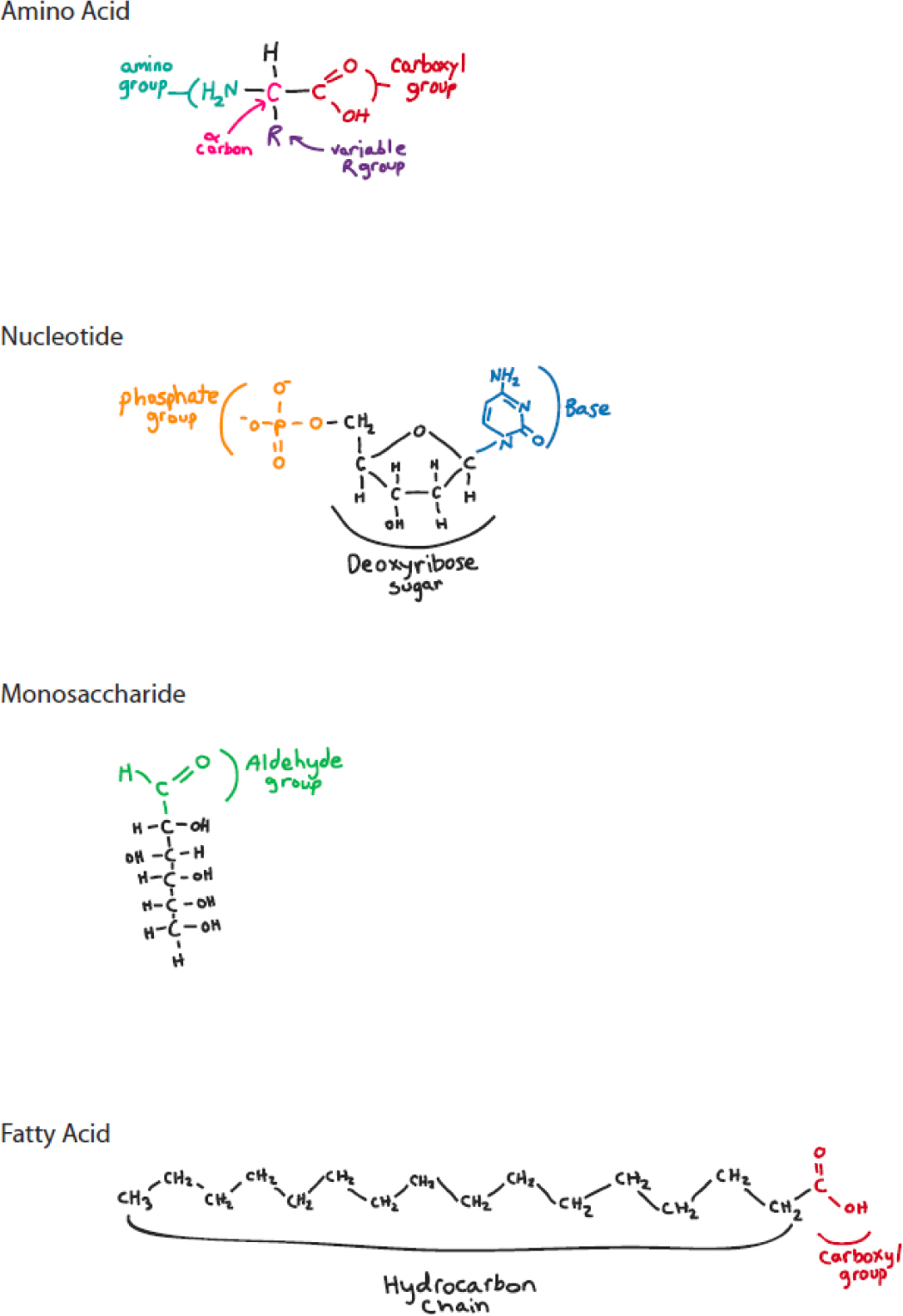
- The principal molecules found in organisms are themselves made of simpler molecules joined together. So if we want to understand how proteins emerged on Earth then we first have to understand the synthesis of nucleotides. Stanley Miller conducted experiments that showed that when he mixed gasses—which were thought to have been present in the early atmosphere—with a spark, amino acids were generated. Based on his experiments, other scientists have generated simple sugars and lipids, which are important in the formation of primitive membranes. Analyses of meteorites have also shown the presence of diverse amino acids, lipids, and other organic compounds, which supports Miller’s initial hypothesis. Building off of Miller’s work, Leslie Orgel performed experiments that showed how nucleotides would spontaneously join to synthesize nucleic acids. Many years later, John Sutherland and his colleagues were able to synthesize nucleotides themselves under conditions thought to be like those on the early Earth.
S-5
S-6
S-7
S-8
Chapter 3 Self-Assessment Answers
- DNA stores an enormous variety of genetic information due to its lack of restriction on the sequence of bases in the DNA molecule. Since there is no restriction, the possibilities of gene-encoded proteins are endless. DNA molecules can also be of great length due to the fact that they form special shapes, supercoils in prokaryotic cells and chromatin in eukaryotic cells, which allow them to fit inside the cells. Without these structures, a cell would not be able to contain the amount of DNA necessary to maintain proper function. The complementary pairing of one purine with one pyrimidine (Guanine to Cytosine, or Adenine to Thymine) is responsible for another key structural element of DNA—that two complementary strains of DNA interact to form a double helix. These attributes play a major role in the faithful replication of the DNA sequence. This ensures that the sequence of genes, and thus the function of the proteins, remains the same as cells grow and divide. Of course there are some occasions where a mistake is made in the DNA copying process, called a mutation, that can alter the function of the protein. In the majority of cases, this altered function is detrimental to the organism, but in a rare number of cases this mutation can actually be beneficial.
- A molecule of DNA is replicated by first breaking the weak hydrogen bonds holding the two strands together. The molecule of DNA then “unzips” into its two parental strands, which serve as templates for the new strands of DNA. Since the two strands of the original DNA molecule are complementary to one another, the end result of DNA replication is two DNA molecules that have identical sequence to the original molecule.
- Just four nucleotides can give rise to the vast diversity of genetic information due to two factors: (1) genes differ in their length of nucleotides, and (2) the nucleotides can be in any order. This gives rise to an enormous potential genetic diversity of any given gene.
- See Figure 3.13.
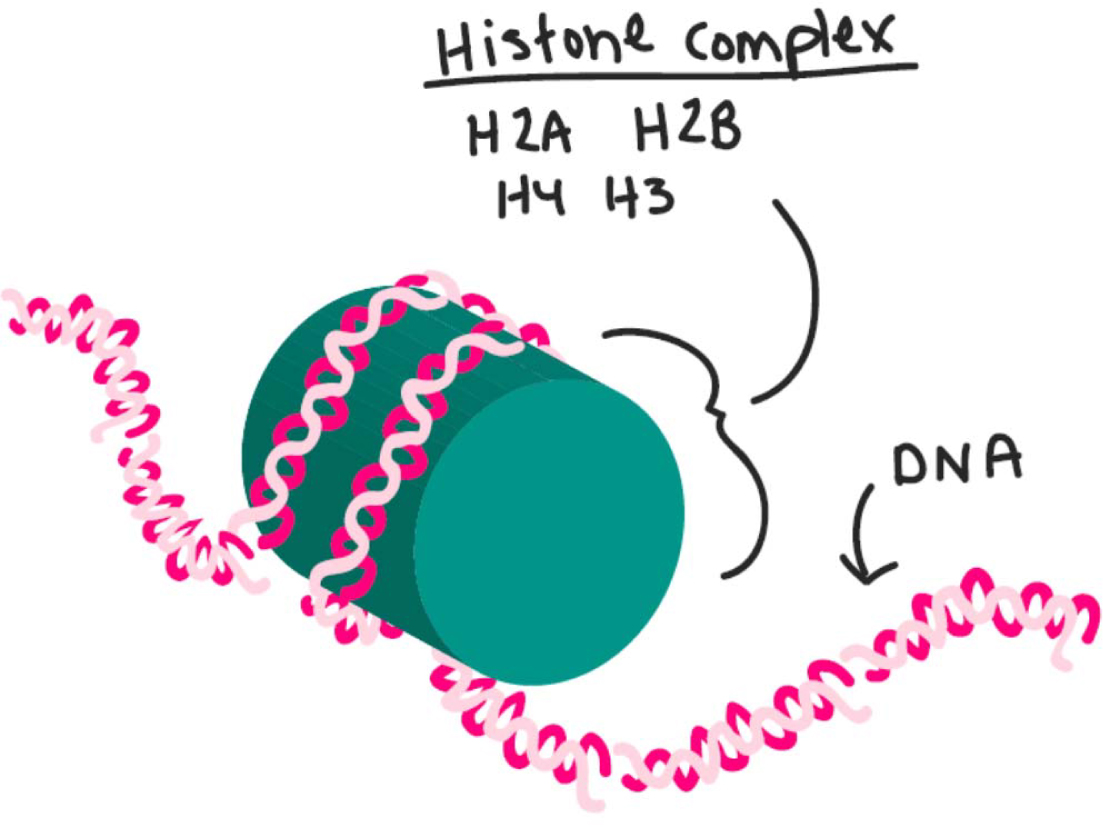
- The central dogma defines the usual flow of genetic information in a cell from DNA to RNA and finally to protein.
- RNA differs from DNA in the following ways: RNA is much less stable than DNA. RNA has catalytic abilities. RNA is single stranded. The sugar in RNA is ribose. The base thymine in DNA is replaced by uracil in RNA. RNA molecules are also usually much shorter than DNA molecules.
- A molecule of RNA is synthesized using DNA through transcription. The DNA molecule first unwinds into its two strands. One of these strands is used as a template for RNA transcription. The resulting RNA transcript is complementary in sequence to the DNA strand template (with the exception of uracil replacing thymine in the RNA). The polymerization is carried out by the enzyme RNA polymerase that binds to the DNA template (usually at a promoter sequence) and transcribes the nucleotides of the DNA into nucleotides of the RNA from the 5' end to the 3' end of the RNA molecule. For a full picture of the eukaryotic transcription complex please see Figure 3.17 and Figure 3.18.
- RNA exists in various forms (e.g., mRNA, tRNA, etc.) and its structure helps define its function. Single-stranded RNA often forms complex three-dimensional structures that enhance their stability. Particular three-dimensional structures allow for certain functions of the RNA. For example, a tRNA is shaped in a particular way so that on one end a codon (a group of three nucleotides coding for an amino acid) can bind and on the other end an amino acid (corresponding to the codon) can bind. This complex has to be in the right shape in order to interact with the ribosome and successfully carry out translation (RNA to protein).
- Three mechanisms of RNA processing (going from the primary transcript to mRNA) in eukaryotic cells are: (1) Addition of the 5' cap. This modified nucleotide (7-methylguanosine) allows the mRNA to be recognized by the ribosome complex. It also helps stabilize the mRNA. (2) Addition of the poly(A) tail. This is important in mRNA transcription termination as well as export of the mRNA into the cytoplasm. Like the 5' cap, it also helps stabilize the mRNA. (3) Excision of introns. The process of intron removal is called RNA splicing. The number of introns removed from a gene can affect the function of the protein. Thus, splicing is one more layer of diversity of the genetic code.
- Five types of noncoding RNA are: (1) ribosomal RNAs (rRNA) that are found in all ribosomes and aid in translation; (2) transfer RNAs (tRNA) that carry individual amino acids for use in translation; (3) small nuclear RNAs (snRNA), which are involved in eukaryotic gene splicing, polyadenylation, and other processes in the nucleus; (4) microRNAs (miRNA) that inhibit translation; and (5) small interfering RNAs (siRNA) that destroy RNA transcripts.
S-9
S-10
S-11
Chapter 4 Self-Assessment Answers
- See Figure 4.2 Briefly, the carboxyl group and alpha carbon are the same for all amino acids. The amino group is the same for almost all the amino acids, with Proline being the exception. The variety of function and form between the amino acids is mainly due to the different side chains.
- Amino acids can be categorized into four main groups based on the properties of their side chains: The first are the Hydrophobic amino acids, “water-fearing,” whose side chains are non-polar, usually found buried in the interior of the folded proteins, and typically form bonds with other hydrophobic amino acids or solvents (e.g., Valine). In the second group are the Hydrophilic amino acids, “water-loving,” that have polar side chains, usually found on the outside surface of folded proteins, and typically form bonds with other hydrophilic amino acids or water. Their charge allows them to interact with other proteins and macromolecules. Hydrophilic amino acids are also broken up into two groups: Basic amino acids with side chains that are positively charged (e.g., Lysine) and Acidic amino acids with side chains that are negatively charged (e.g., Aspartic acid).
- The way in which amino acids interact and bond in a polypeptide chain is important for the structure and function of the protein. The bonds that are important in maintaining primary structure are peptide bonds. These bonds form between the carboxyl group of one amino acid and the amino group of the next amino acid in the chain. The peptide bond allows the formation of polypeptide chains (aka, the primary structure). Note that these bonds are typically found between groups in the polypeptide backbone. Hydrogen bonds are important in maintaining secondary structure of the polypeptide chain. These bonds form between the oxygen in the carbonyl group of one peptide bond and the hydrogen in the amide group of another. This allows regions of the polypeptide to interact with itself and fold. Two common types of secondary structure made through hydrogen bonding are alpha helices and beta sheets (Figures 4.6 and 4.7). Note that in terms of secondary structure, these bonds are found between groups in the polypeptide backbone. There are four groups of bonds or interactions important in creating tertiary structure. The first group is the ionic bonds that form between a negative charge and a positive charge. For example, an ionic bond would form between a basic amino acid and an acidic amino acid because they have oppositely charged side chains. These bonds can occur between amino acids that are far apart in the polypeptide chain, thus creating loops and bends in the overall structure. Note that these bonds are typically found between side chains of the amino acids in the polypeptide backbone. The second group is the hydrogen bonds that form between the oxygen of one amino acid’s side chain and the hydrogen of another amino acid’s side chain. Note that when discussing tertiary structure, these bonds are found between different side chains. The third group is the disulfide bridges. These bonds form between two cysteine residues in the same polypeptide chain (disulfide bond) creating interact. Note that disulfide bridges are also important in quaternary structure. The fourth group important to maintaining tertiary structure is noncovalent interactions. These interactions include van der Waals forces and hydrophobic interactions.
- The order of amino acids in the polypeptide chain determines the way in which proteins fold because of the various interactions and bonds formed between the amino acids. These interactions, depending on the type and location, will give rise to a specific secondary and tertiary structure. More often than not, these structures must be perfectly arranged for the protein to function. Thus, it is important that the polypeptide chain be correctly ordered to result in the specific structure of that particular protein.
- In many cases, the ability of a protein to perform its function is dependent upon the protein being in the correct confirmation. For example, if the polypeptide chain of the large ribosomal subunit had a mutation or change in the amino acid sequence that lead to a change in the tertiary structure, the subunit may not be able to interact with the small ribosomal subunit, mRNA or the various tRNAs. Since these interactions can no longer occur, due to the improper folding of the large ribosomal subunit, the cell would not be able to translate the mRNA into protein and thus would eventually die.
- The codons of mRNA are groups of three nucleotides that code for a particular amino acid. The sequence of the codons in the mRNA will give rise to the order of the resulting amino acid polypeptide chain. The codons are translated by tRNAs. Each tRNA has its own group of three nucleotides, called an anticodon, that can recognize and bind to a specific codon in the mRNA. Each tRNA also has a specific amino acid, affiliated with a particular anti codon/codon pair, that is bound to the 3' end of the molecule. When the mRNA is being “read” through the ribosome, the order of the amino acids in the polypeptide chain is dependant upon the sequential interaction of the mRNA codon with the correct tRNA anticodon/amino acid pair. (See Figure 4.15)
- Translation of mRNA by ribosomes can be broken up into three processes: Initiation: Initiation factors bind to the 5' cap of the mRNA (in eukaryotic cells) or at the Shine Dalgarno sequence (for prokaryotes) and recruit the small subunit of the ribosome and a tRNA charged with Methionine. This complex then moves along the mRNA until it finds a start codon (AUG, coding for Methionine). The large ribosomal subunit then joins the complex and causes the initiation factors to be released. The tRNAMet is then bound in the P site of the ribosome. The next tRNA, determined by the codon of the mRNA, binds in the A site of the ribosome. This elicits a coupled reaction in which the bond between the Met and its tRNA is broken and a new bond is formed between the carboxyl group of the Met and the amino group of the next amino acid (a peptide bond). The ribosome complex then slides to the next codon on the mRNA shifting the now uncharged tRNAMet to the E site, where it is released from the ribosome complex, and the peptide bearing tRNA to the P site. The A site is now free for the next charged tRNA. Elongation: The ribosome continues in this fashion shifting down the mRNA one codon at a time, adding amino acids to the growing peptide chain. Elongation factors provide the energy needed for these reactions to happen. Termination: When the ribosome complex comes across a stop codon (UAA, UAG or UGA) a protein release factor binds in the A site of the ribosome and causes the bond between the polypeptide chain and the last tRNA to break. Once the polypeptide chain is released, the ribosomal subunits disassociate from the mRNA and each other and translation is complete.
- Two ways in which proteins can acquire new functions through the course of evolution are (1) mutation and selection and (2) combing different folding domains. In the mutation and selection category the sequence of the amino acids in the polypeptide chain is important for the proper folding and ultimately, function, of the protein. If the sequence is altered by a mutation that changes a codon to code for a different amino acid, this could affect the function of the protein and whether it is selected for in the population. A mutation that leads to a non-functioning protein will most likely lead to the impaired survival and reproductive ability of that organism and will thus be eventually eliminated from the population. A mutation that does not impair or improve protein function will likely remain in the population because those organisms will survive and reproduce at normal levels. A mutation that improves the function of the protein, although rare, would give a selective advantage to that organism if it could survive and reproduce more successfully. In the combining different folding domains category, form leads to function. If a protein gains a new folding domain by joining with another protein, for example, it now has the additional function provided by that folding domain. If this function is beneficial or benign to the protein, and ultimately the survival and reproductive ability of the organism, the new protein will be maintained in the population.
S-12
S-13
S-14
Chapter 5 Self-Assessment Answers
- In an aqueous environment, the polar hydrophilic phosphate head group will readily interact with the polar water molecules. In contrast, the hydrophobic lipid tail does not readily interact with water and will instead interact with other lipid tails or hydrophobic molecules. For example, lipid bilayers form cell membranes with the following layers: extracellular matrix (polar), phosphate head groups of first layer (polar), lipid tails of first layer (non-polar), lipid tails of second layer (non-polar), phosphate head groups of second layer (polar), and finally the cytoplasm of the cell (polar). This is an example of a lipid bilayer. Lipids can also form micelles and liposomes (Figure 5.3).
- Proteins can associate with membranes in the following ways: (1) Integral membrane proteins are permanently associated with the membrane and cannot be removed without destroying the membrane itself. Most integral membrane proteins span the cell membrane, thus they have both hydrophilic and hydrophobic regions. (2) Peripheral membrane proteins are temporarily associated with the membrane and can easily be experimentally separated. These proteins can be associated with either the internal or external side of the membrane. They are mostly hydrophilic in nature and thus interact with the polar heads of the lipid bilayer.
- An experiment designed to show that proteins move in membranes is the FRAP technique. FRAP stands for fluorescence recovery after photobleaching. You first label the proteins embedded in the cell membrane with fluorescent dye molecules. You then use a laser that bleaches part of the cell causing it to no longer fluoresce. Eventually, the fluorescently labeled proteins from other parts of the cell will move into the bleached area and cause it to fluoresce once again. If the proteins did not move in membranes, that area would stay bleached for the life of the cell.
- Three parameters that need to be stably maintained inside a cell are pH, salt, and water.
- Lipids help maintain the selective permeability of the membrane by preventing charged molecules and ions from diffusing freely into the cell. Large molecules like proteins and polysaccharides are too large to cross the plasma membrane without help so their transport must be facilitated. Proteins in the membrane help with this process by acting as channels and pores that import and export these molecules and others into and out of the cell. Each kind of channel or transporter has a specific kind of molecule, or sometimes a single molecule, that it helps across the membrane, thus adding another layer of specificity.
- Passive transport into and out of cells works through diffusion (the random movement of molecules). When there is a concentration difference (concentration gradient) of a particular molecule inside or outside of the cell, the molecule will move from an area of higher concentration to an area of lower concentration. Facilitated diffusion happens when a molecule cannot move across the plasma membrane. These molecules passively diffuse through channels or protein carriers in the lipid bilayer (See Figure 5.10). In contrast, active transport is used by the cell to move a molecule into or out of the cell against its concentration gradient. Molecules move through transport proteins (integral membrane proteins) embedded in the cell membrane. This type of transport requires ATP or energy either directly (primary active transport, Figure 5.12) or indirectly (secondary active transport, Figure 5.13).
- Cells maintain size and composition in the following ways: (1) Cells can use active transport to maintain the intracellular solute concentration so that it equals the extracellular solute concentration. This helps keep water at equilibrium inside and outside of the cell, giving the cell shape (e.g., red blood cell). (2) The cell wall of some organisms help maintain the cell’s size and shape by providing a rigid structure surrounding the cell membrane.
- Prokaryotic cells lack a nucleus and extensive internal compartmentalization. They contain plasmids that carry additional genes that can be transferred to other bacteria. Prokaryotic cells are also small (usually 1–2 micrometers in diameter or smaller). Their small size allows for a greater surface area-to-volume ratio for the cell and thus a better-suited membrane for the absorption of nutrients in the environment. Eukaryotic cells, on the other hand, have a nucleus and have specialized internal structures called organelles. They are also 10 times larger in diameter and 1000 times larger in volume than a prokaryotic cell.
- See Figure 5.18 for a brief synopsis.
- Proteins produced on free ribosomes are typically directed to their final destination through particular amino acid sequences called signal sequences. These proteins are sorted after they have been translated. Each compartment of the cell has a different signal sequence or sequences associated with it (e.g., nuclear localization signals will direct the protein to the nucleus). Proteins with no signal sequence remain in the cytosol. Proteins produced by ribosomes on the rough endoplasmic reticulum end up in the lumen of the endomembrane system or embedded in its membrane. They may also be secreted out of the cell. These proteins are sorted as they are translated. Proteins that will end up in the lumen or secreted outside the cell are sorted into the ER lumen. Those that will eventually be a part of a membrane are inserted into the ER membrane as they are synthesized.
S-15
S-16
Chapter 6 Self-Assessment Answers
- Organisms can obtain energy from the environment in two ways: (1) energy harvested from sunlight (phototrophs), and (2) energy harvested from chemical compounds (chemotrophs). These groups are further distinguished by how they obtain the carbon that their cells need. Autotrophs can obtain carbon directly from carbon dioxide when they convert it into glucose. Heterotrophs obtain carbon from organic compounds made by other organisms. (See Figure 6.1 for examples.)
- Catabolism is a series of chemical reactions that break down molecules into smaller units producing energy (ATP). Anabolism is a series of chemical reactions that build molecules from smaller units and require the input of energy (usually in the form of ATP).
- Energy is the system’s capacity to do work. The first form of energy is kinetic energy (the energy of motion). Moving objects perform work that results in the movement of themselves and the surrounding matter. Examples of kinetic energy are flexing a muscle, throwing a ball, basically any kind of movement. The second form of energy is potential energy (stored energy). Potential energy relies on the structure of the object or its position relative to its surroundings, and it is released by a change in the object’s structure or position. A ball sitting on the top of the stairs has a great deal of potential energy which is released when the ball starts to roll down the stairs (at which point the energy is converted into kinetic energy).
- Chemical energy in molecules is stored as potential energy of the electrons at various distances from the nucleus. The farther away an electron is from the nucleus, the more potential energy it has. When an electron moves closer to the nucleus, some of its potential energy is converted to other types of energy (like heat or light). In a covalent bond, atoms share electrons. When the shared electrons are far away from both nuclei, they have a great deal of potential energy. Carbohydrates, lipids, and proteins are a rich source of this chemical energy.
-

- See Figures 6.6 and 6.7. The first law of thermodynamics is the law of conservation of energy. It states that energy can neither be created nor destroyed; it can only be transformed from one form into another. For example, when an electron moves from a higher energy level to a lower one, it emits light or heat. The energy it takes to move the electron down a level is equal to the amount of energy released as heat or light. The second law of thermodynamics states that the transformation of energy is associated with an increase in the disorder of the universe. The degree of disorder is called entropy. In the example of the electron moving down energy levels, the heat emitted from the movement will increase the amount of disorder in the universe (or an increase in entropy).
- The amount of energy available to do work is called Gibbs free energy (G). In a chemical reaction, you compare the free energy of the reactants and products to determine whether there is energy available to do work. This difference is called ΔG. If the products of a reaction have less free energy than the reactants, ΔG is negative and energy is released. This kind of reaction occurs spontaneously (also called exergonic). If the ΔG is positive, meaning that the products of the reaction have more free energy than the reactants so that an input of energy is required to drive the reaction forward, this reaction is not spontaneous (also called endergonic).
- The hydrolysis of ATP releases energy. This energy can be used to drive non-spontaneous reactions in a cell if the total ΔG for the entire pathway is negative. See Figure 6.12.
- Enzymes reduce the activation energy of a chemical reaction (or the energy input necessary to reach the transition state) by stabilizing the transition state and decreasing its free energy. See Figure 6.14. Enzymes also form complexes with reactants and products to avoid being consumed in the chemical process. See Figure 6.15. Enzymes are also highly specific. They typically catalyze only one reaction, recognizing a specific substrate. Finally, inhibitors and activators can influence enzyme activity. Inhibitors decrease the activity of enzymes, whereas activators increase this activity. See Figure 6.19 for an example of two different types of inhibitors.
- The three-dimensional shapes of proteins are very important in allowing for enzyme specificity. The enzyme has to fold into its correct shape in order for the active site (the portion of the enzyme that binds substrate and converts it to product) to be in the right area and shape. An enzyme will only recognize its substrate if its active site is in the right conformation due to the correct three-dimensional folding.
S-17
S-18
S-19
Chapter 7 Self-Assessment Answers
- Cellular respiration is a series of chemical reactions that convert the energy stored in fuel molecules into a chemical form that can readily be used by cells. Cellular respiration occurs in four main stages: (1) Glycolysis: glucose, fatty acids or amino acids are partially broken down and a modest amount of energy (in the form of ATP) is released. (2) Acetyl-CoA synthesis: pyruvate (the breakdown product of glucose) is converted to acetyl-coenzyme and carbon dioxide is produced. (3) Citric acid cycle: acetyl-CoA is broken down and carbon dioxide and ATP are released. (4) Oxidative phosphorylation: in these reactions, electron carriers generated in stages 1–3 donate their high-energy electrons to an electron-transport chain (or a respiratory chain). This chain transfers electrons along a series of membrane-associated proteins to a final electron acceptor and harnesses the energy of the electrons to produce a large amount of ATP. In aerobic respiration, oxygen is the final electron acceptor, so it is consumed and water is produced.
- Oxidation-reduction reactions are used to store or release chemical energy. Oxidation is the loss of electrons and reduction is the gain of electrons. This gain and loss always happens in a single reaction or, in other words, electrons are transferred from one molecule to another. However, in many systems, electrons are not completely transferred between the molecules. Instead, there is a change in electron density around an atom. This is shown in the breakdown of glucose in the presence of oxygen to produce carbon dioxide and water. The carbon atoms in glucose are oxidized because they go from sharing electrons equally in the bond (C–C) to partially losing electrons in the carbon dioxide molecule (C=O). The opposite is true for oxygen, which is reduced in the same reaction. The oxygen go from sharing electrons equally (O=O) to partially gaining electrons when water is formed (H-O).
- ATP is generated by substrate-level phosphorylation and oxidative phosphorylation. In substrate-level phosphorylation, a phosphorylated organic molecule directly transfers a phosphate group to ADP. This pathway produces only a small amount of the total ATP generated in the process of cellular respiration. In contrast, most of the ATP generated in cellular respiration is produced through oxidative phosphorylation (stage 4 of the cellular respiration reactions). In these reactions, ATP is generated indirectly through the reduction of electron carriers, the transfer of high-energy electrons from electron carriers to the electron-transport chain, and the subsequent synthesis of ATP from ADP and inorganic phosphate.
- See Figure 7.4. Starting product is glucose and the end product is pyruvate. Energy storing molecules that are produced are ATP and NADH-.
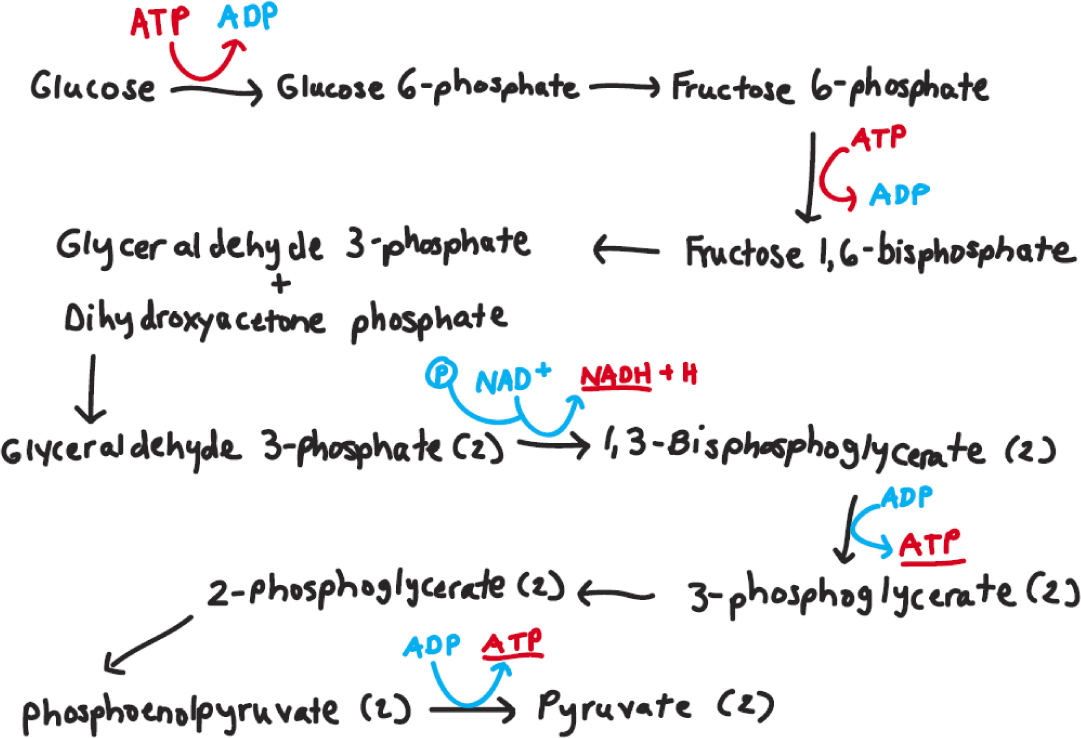
- In the first pathway, pyruvate is converted to acetyl-CoA, which is the starting substrate for the citric acid cycle. During the citric acid cycle, the chemical energy in the bonds of acetyl-CoA is transferred to ATP by substrate-level phosphorylation and to the electron carriers NADH and FADH2. The second pathway is fermentation, a reaction that happens without oxygen. There are many fermentation pathways but all rely on oxidation of NADH to NAD+ when pyruvate or a derivative of pyruvate is reduced. Two major fermentation pathways are lactic acid fermentation and ethanol fermentation. In the lactic acid pathway, electrons from NADH are transferred to pyruvate to produce lactic acid and NAD+. In the ethanol fermentationpathway, pyruvate releases carbon dioxide to form acetaldehyde, and electrons from NADH are transferred to the molecule to produce ethanol and NAD+.
- In two turns of the citric acid cycle (one for each acetyl CoA), 2 ATP, 6 NADH, and 2 FADH2 are produced. Carbon dioxide and oxaloacetate are also produced.
- The movement of electrons along the electron-transport chain in the inner mitochondrial membrane is coupled to the transfer of protons across the membrane resulting in the accumulation of protons in the intermembrane space. This creates a concentration and charge gradient, which provides a source of potential energy that is then used to drive the synthesis of ATP. See Figure 7.9.
- The protons accumulated in the intermembrane space cannot passively diffuse across the membrane, so they utilize a transport channel called ATP synthase. This enzyme is composed of two subunits: F0 (the channel through which protons flow) and F1 (the catalytic unit that synthesizes ATP). Proton flow through the channel causes it to rotate, which converts the energy of the proton gradient into mechanical rotational energy (kinetic energy). The rotation of the F0 subunit leads to rotation of the F1 subunit. This causes conformational changes in the F1 subunit that allow it to catalyze the synthesis of ATP from ADP and Pi.
- Muscle tissue generates ATP during short-term exercise by converting stored glycogen to glucose. This rapid breakdown of glucose is done anaerobically to pyruvate and lactic acid, which then feeds into the lactic acid fermentation pathway. During long-term exercise, the liver release glucose into the blood, which is taken up by muscle cells and oxidized to produce ATP. In addition, adipose tissue releases fatty acids that are also taken up by muscle cells and broken down by ß-oxidation. These processes are slower to mobilize the conversion of glucose and other molecules to energy; however, the end result is the production of more ATP than the fermentation pathway.
S-20
S-21
S-22
Chapter 8 Self-Assessment Answers
- The overall photosynthetic reaction is CO2 + H2O → C6H12O6 + O2, in which the CO2 is reduced to C6H12O6 and the H2O is oxidized to O2.
- In cyanobacteria two different photosystems evolved to produce one single photosynthetic electron-transport chain. One hypothesis is that a cyanobacterium with one photosystem gained the second photosystem through horizontal gene transfer from another cyanobacterium. Another hypothesis is that the two photosystems evolved together in the same organism. Photosynthesis is hypothesized to have evolved in eukaryotic cells through an endosymbiotic event where a cyanobacterium was incorporated into a plant cell and eventually evolved to be the organelle chloroplast.
- The photosynthetic pathway harnesses the energy of the sun to produce energy (in the form of ATP and NADPH) that will then drive the Calvin cycle to convert CO2 to a usable form of energy, a carbohydrate.
- The major inputs of the Calvin cycle are CO2 (from the atmosphere) and ATP and NADPH (from the photosynthetic pathway). The major outputs of the Calvin cycle are ADP, NADP+, and carbohydrates.
- See Figure 8.6. Briefly, CO2 enters the Calvin cycle and is added to the 5-carbon compound RuBP catalyzed by the enzyme rubisco. After this carboxylation reaction, the 3-PGA is reduced through conversions of ATP to ADP and NADPH to NADP+. The resulting triose phosphate, the carbohydrate, then exits the cycle to be used as energy for the cell. In the final step of the cycle, some of the carbohydrate is used to regenerate RuBP through reactions with ATP. Then the cycle starts again with more CO2.
- Photosynthetic electron transport requires two photosystems because each has a particular function. Photosystem II is able to pull electrons from water (something that Photosystem I is not capable of doing). Photosystem I, however, can harness enough light energy to convert NADP+ to NADPH (something that Photosystem II is incapable of). Since both the ability to split water for electrons and the production of NADPH is important in the photosynthetic pathway, both photosystems are critical for successful carbohydrate production.
- The role of cyclic electron transport is to prevent damage to the cell by an excess of high-energy electrons. These electrons are routed into an alternative pathway (the cyclic electron-transport system) that not only protects the cell but also creates ATP by setting up a proton gradient that drives the conversion of ADP to ATP by the enzyme ATP synthase.
- Two strategies that plants use to limit the formation and effects of reactive oxygen species are antioxidants and xanthophylls. Antioxidants like ascorbate and beta-carotene neutralize reactive oxygen species. Xanthophylls are yellow-orange pigments that slow the formation of reactive oxygen species by reducing excess light energy. They do this by accepting absorbed light energy directly from chlorophyll and then converting this energy to heat.
- The ability of rubisco to favor CO2 over O2 requires a high degree of selectivity (becausee carbon dioxide and oxygen look very similar to a large enzyme). This selectivity makes the reaction rate of rubisco very slow.
- The photosynthetic electron-transport chain captures at most about 24% of the sun’s usable energy. Some of the energy is reflected off the leaf. Some of the light energy absorbed cannot be transferred to the reaction center and is thus given off as heat. Another larger energy loss comes with photorespiration. In all, the maximum energy conversion efficiency of photosynthesis is about 4%.
S-23
S-24
Chapter 9 Self-Assessment Answers
- The four players in cell communication are a signaling cell, a signaling molecule, a receptor molecule, and a responding cell.
- The steps involved in cell communication are receptor activation, signal transduction, response, and termination.
- One way in which the signaling pathways are similar is that the cell uses them to communicate with each other and itself based on small-molecule signals. One difference between the pathways is the distance between the signaling and responding cell.
- Cells can respond to external signals by utilizing specific transmembrane proteins that bind the signal (ligand) in the signal receptor’s ligand binding site. The binding of ligand to its receptor causes a conformational change in the receptor activating it. The type of ligand and receptor determine how the cell will respond to the signal.
- A signal can be specific for a particular cell type even if the signal is in the bloodstream because the signal will only recognize a specific receptor on the correct cell type. Binding of ligand to receptor is often highly specific, and every cell does not have every kind of receptor.
- Several possible types of responses a cell might have to a signaling molecule are migration to another part of the body, activation of a particular protein, shape change of the cell itself, growth, production of defensive enzymes, self-destruction (apoptosis), and differentiation to name a few.
- Cell-surface receptors are usually transmembrane proteins with an extracellular domain, transmembrane domain, and cytoplasmic domain found in the plasma membrane of the cell. They have polar signaling molecules that cannot diffuse across the membrane (due to the hydrophobic lipid tails), so they bind with the receptor in the extracellular matrix (outside the cell). The receptor then transmits the signal to the inside of the cell, initializing? transcription of a particular gene, for example. Intracellular receptors exist inside the cell in the cytoplasm or in the nucleus itself. Their signaling molecules are typically nonpolar and can easily diffuse through the cell membrane. Once inside the cell, the ligand binds with its receptor, causing the receptor to change shape; in the case of steroid signals, the ligand receptor complex moves into the nucleus and begins specific gene transcription.
- In the example of G-protein—coupled receptors, a signal may be amplified in several ways. Multiple G-proteins could be activated by the G-protein receptor, which in turn would cause adenylyl cyclase to convert ATP to cAMP (the second messenger system). The cAMP can then activate its downstream target (e.g., Protein kinase A), which will then go on to convert ATP to ADP and finally activate multiple protein targets.
- Response of a cell to a signal can be terminated at a variety of levels. The receptor itself could change its conformation to the inactive form, the protein interacting with the intracellular portion of the receptor could become inactivated (perhaps due to de-phosphorylation) or any of the downstream enzymes (like cAMP or Protein kinase A) could become inactivated.
S-25
S-26
Chapter 10 Self-Assessment Answers
- Three types of filaments that make up the cytoskeleton are microtubules, made up of alpha and beta tubulin, microfilaments, made of actin monomers, and intermediate filaments, made of fibrous subunits. Animal cells have all three filaments types whereas plant cells only have microtubules and microfilaments.
- Microtubules and microfilaments are dynamic in structure because they can become longer or shorter with the addition or subtraction of their subunits. Cycles of this shrinkage and growth are called dynamic instability.
- Three major motor proteins that are required for cellular movement involving the cytoskeleton are myosin, kinesin and dynein. Myosin binds to actin filaments (microfilaments) in the cell and can cause these filaments to move together and contract in the example of a muscle cell contraction. Myosin can also attach to various types of cellular cargo and moves these materials from one part of the cell to another along the microfilament. Kinesin transports cargo towards the plus end of microtubules while dynein transports cargo in the opposite way or towards the minus end of the microtubule.
- Movement of cells through cilia and flagella is made possible by the microtubules extending along the length of the flagella or cilia. Dynein undergoes a conformational change, powered through ATP hydrolysis, which causes the pairs of microtubules to slide past each other giving the cilia or flagella its characteristic movement. In contrast, when a cell crawls it is due to the polymerization of actin in the microfilaments. The microfilaments assemble and disassemble in a directional manner and cause the cell to move in a particular direction. The interaction of myosin and actin also help this movement by contracting the microfilaments of the cell and squeezing the cytoplasm and its contents forward.
- Cadherins attach actin from one cell to another through adherens junctions. This establishes a physical connection among the actin cytoskeletons of all cells present in the tissue. Desmosomes hold the plasma membrane of adjacent cells together. They also utilize cadherins but unlike adherens junctions, the cadherins bind to intermediate filaments of the cytoskeleton. Hemidesmosomes anchor epithelial cells to the basal lamina. They are composed of integrins that bind to the extracellular matrix proteins in the basal lamina on one end and bind to intermediate filaments on the other. This results in a firmly anchored cell.
- Cadherins are transmembrane proteins that interact with the cytoskeleton on their cytoplasmic domain and with other like cadherin proteins on their extracellular domain. This results in the ability of cells to connect to one another. Integrin proteins are also transmembrane proteins that connect specific extracellular proteins, through interactions with their extracellular domain, to the cytoskeleton of the cell. This results in the cells being stably attached to proteins of the extracellular matrix.
- In plants, the extracellular matrix makes up the cell wall, which is composed of proteins like cellulose and lignin. The interconnected cell walls of the plant support the entire organism. In animals, the extracellular matrix can be found in connective tissue. Here, proteins like collagen, elastin and laminin provide support and protection to the tissues surrounding them.
- The basal lamina is a specialized layer of extracellular matrix that is present beneath all epithelia tissues where it provides the structural foundations for many different types of epithelia tissues. The epithelial tissue is connected to the basal lamina through hemidesmosomes, which are composed of integrins. The integrins of the cell interact with proteins in the extracellular matrix, or basal lamina, and connect the cell to this matrix by also interacting with intermediate filaments inside the cell itself.
- Malignant tumors are an example of a cell type that has a heightened ability to attach to extracellular matrix proteins. This allows the cancerous cells to go through basal laminas of blood vessels, travel to different locations and adhere. One mechanism thought to play a role in this heightened ability to adhere is increased gene expression and production of adherence proteins. In contrast, if a white blood cell, for example, was unable to attach to the basal lamina of the bloodvessels due to lowered adherence gene expression, it would be unable to travel to and stay at sites of infection and would therefore not be able to perform its function.
S-27
S-28
Chapter 11 Self-Assessment Answers
- Prokaryotic cells reproduce through a process called binary fission. During this process, the cell replicates its DNA, increases in size, and divides into two daughter cells, each having one copy of the parental DNA. Eukaryotic cells go through a similar process, albeit more complex, called mitotic cell division. In this process, cells first replicate their chromosomes in the nucleus. The nuclear envelop then dissolves and each pair of chromosomes are divided by connecting to the mitotic spindle. Once the two full sets of chromosomes are separated, a nuclear envelope forms around each one. The cell then goes through a process called cytokinesis, where it is split into two new daughter cells.
- Three situations in which mitotic cell division occurs are in the development of multicellular organisms, maintenance and repair of organs and tissues, and asexual reproduction of unicellular eukaryotes.
- The five steps in mitosis are: (1) Prophase (chromosomes condense, centrosomes radiate microtubules and migrate to opposite poles), (2) Prometaphase (microtubules of the mitotic spindle attach to chromosomes), (3) Metaphase (chromosomes align in center of cell), (4) Anaphase (sister chromatids separate and travel to opposite poles), and (5) Telophase (nuclear envelope re-forms and chromosomes decondense). See Figure 11.5 for an illustration of the changes in the chromosomes at each step.
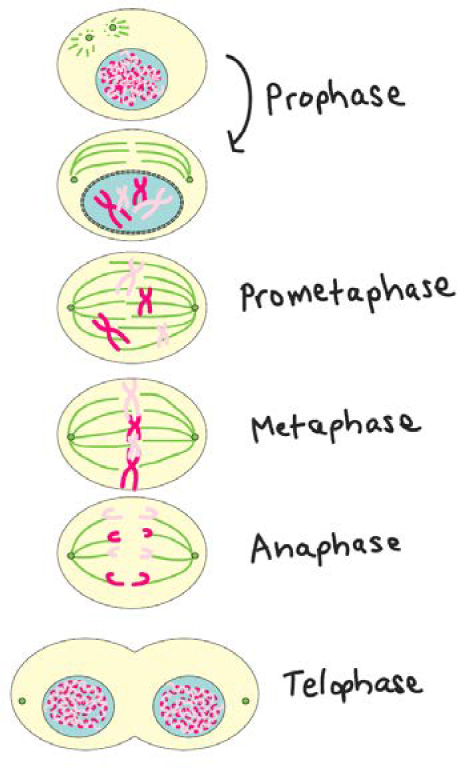
- Meiosis basically goes through two cell-division cycles called meiosis I and meiosis II. In meiosis I, chromosomes are duplicated in Prophase I forming sister chromatids. In Anaphase I, homologous chromosomes separate into two different daughter cells. During meiosis II, the chromosomes do not duplicate and instead the sister chromatids are separated into two more daughter cells. The end result of this process is four daughter cells, each having unique genetic information.
- Mitosis goes through one round of DNA synthesis to produce two genetically identical daughter cells, each with 46 chromosomes. Meiosis also goes through one round of DNA synthesis but goes through two rounds of cell division to produce four genetically different daughter cells, with 23 chromosomes each. See Figure 11.12.
- Genetic diversity is created in meiotic cell division by the crossing over of chromosomes and random alignment of bivalents in metaphase I. Crossing over occurs when homologous chromosomes of maternal origin and paternal origin undergo an exchange of DNA segments, thus creating genetic diversity. Random alignment of bivalents leads to a chromosome set that is a random mix of maternal and paternal homologs.
- In animal cells, cytokinesis involves a contractile ring made of actin. In plant cells, it involves the growth of a new cell wall called a cell plate.
- In the cell cycle, cyclins bind to and activate cyclin dependent kinases (CDKs). Once activated, the CDKs then phosphorylate target proteins involved in promoting cell division. Once activation has occurred, the CDK dissociates from the cyclin and the cyclin degrades.
- Three examples of checkpoints during the cell cycle are (1) Spindle assembly checkpoint, which happens before anaphase and ensures that all chromosomes are attached to the spindles; (2) DNA damage checkpoint, which happens in the G1 phase and checks for DNA damage; and (3) DNA replication checkpoint, which happens in G2 and makes sure all the DNA is replicated.
- An oncogene is a gene that causes cancer. A proto-oncogene is a gene that has the potential to cause cancer when mutated. A tumor suppressor gene blocks specific steps in the development of cancer.
S-29
S-30
Chapter 12 Self-Assessment Answers
- DNA consists of two antiparallel strands, meaning that the 3’ hydroxyl end of one strand interacts with the 5’ phosphate group of the other strand. In the antiparallel helical coil, a purine base (A or G) of one strand interacts with a pyrimidine base (T or C, respectively) of the other strand. This mechanism allows the two strands to have identical genetic information in the form of nucleotide sequence. When DNA replication occurs, the two strands separate (“unzip”) from each other and both are used as a template for the replication of two new DNA strands.
- The orientation of the two DNA strands is antiparallel. This means that the 3’ hydroxyl end of one strand interacts with the 5’ phosphate group of the other strand. When the two strands separate and DNA replication begins, nucleotides are added to the 3’ end of both strands so DNA replication occurs 5’ to 3’.
- The similarities of the resulting daughter strands from DNA replication are that they will encode the same genetic information in the form of nucleotide sequence and they will also be paired with one of the original parental DNA strands. The two strands are different in the way that they are replicated. The leading strand has the 3’ end of its DNA pointed toward the replication fork and thus will be synthesized as one long, continuous polymer. The replication of the other strand, or lagging strand, is a little more complex due to its 5’ end pointing toward the replication fork. Since DNA can only be replicated in the direction of 5’ to 3’, the lagging strand is synthesized in short, discontinuous pieces. Each new piece, or Okazaki fragment, is elongated at its 3’ end until it reaches the piece in front of it.
- Replicating the tips of linear chromosomes is problematic because during the synthesis of the lagging strand, about 100 base pairs at the 3’ end are not replicated. This is due to the synthesizing of the last RNA primer about 100 nucleotides from the 3’ end of the template. This loss of sequence is restored through an enzyme called telomerase. Eukaryotic chromosomes are capped by a repeating sequence called the telomere, which does not encode any genes. When 100 nucleotides of the telomere are lost, the telomerase replaces them. This shortening and lengthening of the chromosome is not detrimental to the cell becausee there are no coded genes in this region.
- The three steps of PCR are (1) denaturation of the double-stranded DNA into two individual strands, (2) annealing of the two primers to their complementary sequence on the DNA template strands, and (3) extension of the parental DNA strands through elongation (5’ to 3’) by DNA polymerase (by extending the primers). PCR can be used in a variety of ways such as DNA fingerprinting, where a person’s DNA is sequenced and potentially matched to evidence found at a crime scene (paternity tests are performed in a similar way). PCR can also be used to identify an organism based on a known conserved region of their DNA, and it can also be used to mass-produce certain sequences of DNA for DNA-based vaccines.
- Since fragments of DNA are negatively charged, pieces will move through a porous gel when an electric current is passed through it. The distance the DNA pieces move through the gel is based on their size, with larger fragments moving more slowly and smaller fragments moving through the gel quickly. To get these fragments of DNA, restriction enzymes, which each recognize a particular sequence of DNA (the restriction site), cleave the DNA at its specified site. DNA can also hybridize to other DNA strands if their nucleotide sequences are complementary to each other.
- In Sanger sequencing, the sequence of a template DNA strand is unknown. Elongation of this strand stops whenever a dideoxynucleotide terminator (a nucleotide in which the 3’ hydroxyl group on the sugar ring is absent) is incorporated at the 3’ end. The four altered nucleotides are chain terminators, each labeled with a different fluorescent dye, so the result of Sanger sequencing is a tube filled with different length fragments of the same DNA sequence. The mixture is then run on a gel and “read” by looking at the fluorescent pattern of the dideoxynucleotides incorporated into the sequence. For example, a sequence of 5’-ATGC-3’ would be “read” as green-red-blue-purple (for the fluorescent dyes).
- The mammalian gene (donor DNA) can be expressed in a bacterium through its insertion into a vector DNA that can be replicated in the bacterium. The same restriction enzymes are used to cut the donor DNA and the vector DNA so that they now have complementary ends. A ligation reaction is then performed to insert the donor DNA into the vector DNA. The vector DNA is then inserted into the bacterium and replicated through the normal method which also replicates the donor, mammalian gene, at the same time.
S-31
S-32
Chapter 13 Self-Assessment Answers
- Genome refers to all the genetic material of an organism that is transmitted from parents to their offspring.
- Shotgun sequencing is an approach for determining the complete genome sequence of an organism. It involves first chopping up the chromosome or genome into small pieces (which is the input for today’s sequencing technology). These small pieces are then sequenced 10–50 times, to reduce the chance of making an error, and then assembled in the correct order to generate the long, continuous sequence of nucleotides in the chromosome or genome. The short sequences are assembled, mainly through computer programs, according to their overlaps.
- It might be useful to sequence your own genome to look for potential mutations in genes known to cause disease if they are altered. Examples are the BRCA1 and BRCA2, which have been linked to breast cancer.
- Types of sequences present in many genomes are: (1) Protein coding genes, of which there are many different varieties such as single-copy genes (gene encodes sequence for only one protein), dispersed repeat (a repeated nucleotide sequence that is dispersed throughout the DNA), tandem repeat (nucleotide sequence that is repeated one after another in the DNA), and simple-sequence repeat (nucleotide sequence shorter than a tandem repeat that is repeated one after another in the DNA); (2) Non-protein encoding RNAs, which are the sequences that encode molecules like tRNAs and rRNAs.
- The purpose of genome annotation is to summarize the knowledge found in the genome by comparing similar motifs between organisms, to guide research, and to reveal evolutionary relationships among organisms. Genome annotation allows scientists to make an educated guess, or hypothesis, concerning a novel gene based on its similarity to known genes.
- The comparison of genomic DNA to mRNA can identify the exons and introns in a gene because in the process of mRNA maturing, the introns are spliced out of the mRNA sequence typically leaving only the exons behind. If you were to then compare the two sequences, you could determine which sequences were exons and then, based on the sequences that are missing in the mRNA, which sequences were introns.
- Comparative genomics, the analysis of the sequences of two genomes, can help infer evolutionary relationships by tracking the evolution of a particular gene through time. Sequences that are similar in different organism are said to be conserved and usually have an important function. By looking at a conserved gene, scientists can determine an evolutionary timeline of the slight changes seen in that gene and map it to the organisms that the gene is harbored in, inferring relationships between them.
- The C-value paradox defines the disconnect between genome size and organismal complexity. It is a paradox because some less complex organisms actually have larger genomes than their more complex counterparts. For example, a fern has a much larger genome size than humans, yet humans are more complex than a fern.
- In bacterial cells, DNA is packaged through the activity of the enzyme topoisomerase II and the formation of supercoils. Topoisomerase II breaks the double helix of the DNA, rotates the ends, and then seals the break. This results in underwinding, which creates strain on the DNA molecule. This strain is relieved by the formation of supercoils in which the DNA molecule coils on itself. These supercoils then form a structure with multiple loops, bound by proteins, called the nucleoid. Eukaryotic cells in contrast wind their DNA around a group of histone proteins called a nucleosome. The histone proteins are positively charged, thus neutralizing the negatively charged DNA backbone. The nucleosomes and DNA are then coiled to form the 30nm chromatin fiber.
- Homologous chromosomes are pairs of chromosomes that match in size and appearance. They have the same genes arranged in the same order. Chromosome painting, the labeling of DNA with different fluorescent dyes, can show the similarity between homologous chromosomes because under fluorescent light, the chromosomes will fluoresce the same.
S-33
S-34
Chapter 14 Self-Assessment Answers
- Mutations account for the differences we see in individuals in a population (e.g., eye color). A mutation can also be detrimental to the organism if the organism cannot survive or reproduce. A mutation may not affect the organism at all and thus may be carried in the population at no benefit or detriment to the population.
- The mutation rate for a given nucleotide varies depending on the organism, but is usually relatively low. The mutation rate for a given cell also varies depending on the number of times DNA replication occurs and the size of the genome. If a cell’s DNA is replicated more frequently, then there is a greater chance that a mutation will occur. The same goes for cells with larger genomes; the bigger the genome the higher the probability that a mistake will be made during replication.
- Mutations occur randomly and without regard to the needs of the organisms. This is to say that an organism does not “mutate” to adapt to its environment. Rather, mutations happen spontaneously and randomly, and if they happen to give that organism a selective advantage in a particular environment, then the mutation will be propagated throughout the population.
- Several types of small-scale mutations are: (1) Point mutations are changes in a single nucleotide. Point mutations can lead to non-functional proteins if the mutation changes a key nucleotide in the protein sequence. This is called non-synonymous or missense mutation. Point mutations can also be synonymous or silent. This usually happens when the third nucleotide of a codon is mutated to another nucleotide that still will give rise to the original amino acid. Thus the protein will not be affected. A nonsense point mutation creates a stop codon that terminates translation prematurely. In this case, the final protein, if even made, would likely be non-functional because it would be truncated. (2) Small insertions or deletions of nucleotides. If an insertion of three nucleotides occurs, then a new amino acid is added to the protein and may or may not affect the functioning of the protein. In the same way, a deletion of three nucleotides will delete an amino acid in the protein and would have the same effects. An insertion or deletion can also result in a frameshift mutation, where the reading frame of the mRNA is altered and different amino acids are added to the peptide change. This would drastically affect the functioning of the final protein of the frameshift that occurred toward the beginning of the nucleotide sequence. (3) Transposable elements are movable sequences of DNA that insert themselves into the genome of an organism. This insertion, depending on where it is, could cause mass interruption of transcription, cause errors in RNA processing, or disrupt the open reading frame.
- If a small-scale mutation happened in the non-coding region of the DNA, the mutation may go unnoticed by the organism because the mutation is not changing actively transcribed genes. These mutations can, however, make a difference in the phenotype of an organism if they happen in the coding region of the DNA. This is the region where mRNA is actively transcribed and proteins are actively translated. A change in this DNA could lead to a mutant protein and phenotype.
- Silent mutations happen when a nucleotide in a codon (typically the third nucleotide) is changed but the change does not affect which amino acid is coded for. For example CTC and CTT both code for glutamic acid. A missense mutation is one where the nucleotide change does affect which amino acid is coded for. For example, CTC codes for glutamic acid, but if the T is mutated to and A, the new amino acid would be valine. A nonsense mutation occurs when the codon is changed from coding for an amino acid to coding for a stop codon. A frameshift mutation occurs when one or two nucleotides are inserted or deleted from the DNA and results in the reading frame of the mRNA to be altered. The severity of the mutation usually depends on the position of the frameshift mutation because all the amino acids following the mutation are changed.
- Several types of large-scale mutations are: (1) Duplications and deletions of chromosomes. This happens when a segment of the chromosome is either present in two copies or deleted altogether. Duplications are typically less harmful to the organism than deletions because deletions can remove whole genes essential to the organism’s survival. However, since chromosomes usually occur in homologous pairs, the deletion in one may not be detrimental to the organism right away. An example where duplication is beneficial to the organism is when the duplicated gene gives the organism a reproductive and survival advantage in the population. This is called duplication and divergence. (2) Reciprocal translocation occurs when two different (nonhomologous) chromosomes undergo an exchange of parts. Since this phenomenon only causes change in the arrangement of genes and not their number, most do not affect the survival of the organism.
- A gene family is defined as a group of genes with related functions. They are thought to occur through multiple rounds of duplication and divergence, resulting in genes that are similar yet contain some differences that affect their function slightly (e.g., different odor receptors in the odorant receptor gene family).
- Mutagens are agents that increase the probability of mutation. Some common mutagens are: X-rays, which cause breaks in the sugar-phosphate backbone of DNA; ultraviolet light, which causes thymine bases to cross-link resulting in thymine dimers; bleach or hydrogen peroxide, which causes the loss of a base from the DNA sequence; and chemicals that are highly reactive, such as the ones in cigarette smoke, that often add bulky side groups to the bases and hinder proper base pairing.
- Since the preservation of the correct DNA sequence is so important to a cell, there are several repair mechanisms the cell has to combat mutagens and spontaneous mutations. DNA ligase repairs breaks in the sugar-phosphate backbone by joining the 3’ hydroxyl of one end to the 5’ phosphate of the other. The proofreading function of DNA polymerase corrects mispaired bases 99% of the time. The other 1% are corrected through a process called mismatch repair, in which one strand of the backbones in the vicinity of the mismatch is cleaved and then degraded nucleotide by nucleotide to a point at a distance past the site of the mismatch. Then the gap is filled by new synthesis and the mismatch is corrected. Base excision repair is where an improper base in DNA and its deoxyribose sugar are both removed and the resulting gap is then repaired. Nucleotide excision repair is similar to mismatch repair with the difference being the number of mismatched bases. Nucleotide excision repair can recognize thousands of nucleotides that are mismatched or damaged, whereas mismatch repair can only recognize one mismatched base.
S-35
S-36
S-37
Chapter 15 Self-Assessment Answers
- A genotype refers to the genetic composition of a cell or organism, which can vary based on the nucleotide sequence in the region(s) of interest. Although there can be many different forms (alleles) of a gene or sequence, each cell or individual normally has only two copies of each sequence, and they can either be identical to one other (homozygous) or different from one another (heterozygous). A phenotype of a cell or organism refers to its observable features, which are determined in part by its genotype, but can also be influenced by environmental factors. Some phenotypes are easily seen and vary widely among individuals, like natural hair color or height, but a phenotype may also involve less easily observable characteristics like blood type, which fall into a few distinct groups.
- Beneficial mutations are those that provide some sort of advantage to the organism in its environment, such as the δ32 allele of the CCR5 gene which can reduce HIV infection rates in exposed individuals and delay progression to AIDS after infection has occurred. The PiZ allele of the gene encoding a1AT is an example of a harmful mutation because it results in reduced levels of a1AT which, in the homozygous state, can lead to the development of emphysema due to increased breakdown of elastin in the lungs. Neutral mutations provide neither benefit nor harm to the individual, such as the AVI allele present in PTC non-tasters since the inability to taste this chemical does not affect the survival or reproductive capacity of the individual.
- Designating a mutation as simply beneficial, harmful or neutral does not account for the influence of the environment on the organism, which may determine how the mutation ultimately affects the individual’s fitness. For example, when an individual is heterozygous for the S allele of ß-globin, they may have mild symptoms of blood disease (which would be considered harmful), but these individuals are also partially protected from malaria, which is highly beneficial for individuals in regions where malaria is widespread.
- Differences in the amount of DNA or point mutations that alter restriction endonuclease recognition sites are two types of differences in DNA sequences that can be used to uniquely identify an individual. Variable number tandem repeats (VNTRs) are generated by the repetition of short stretches of DNA one after another in a particular region of a given chromosome. The size of the fragment generated by PCR amplification of these regions can reveal differences in the number of repeats within the region of interest. Point mutations in a DNA sequence can also introduce or disrupt a recognition site for a restriction endonuclease, so the pattern of restriction fragments that are generated by digestion of the region of interest can be used to determine whether a polymorphism exists in that region. Since each of these types of polymorphisms occur at many different regions within the genome, the combination of the alleles at several positions can be used to distinguish the DNA of one individual from another.
- A SNP is a single nucleotide polymorphism, or in other words, a difference between two sequences at a single nucleotide position within a DNA sequence (point mutation). By definition, SNPs must be common enough to be found at least once in a random sample of 50 individuals, but the affect of a given SNP on phenotype can vary widely. Some SNPs are neutral, whereas others are beneficial or can increase disease risk. SNPs that correlate with disease risk or incidence are of particular interest to researchers as a potential way to identify those that are at-risk for particular diseases before the onset of symptoms so that preventative treatment or early medical interventions can be initiated.
- DNA microarrays can be used to detect both SNPs and copy number variation (CNV). This technology relies on the ability of complimentary DNA sequences to hybridize to one another under favorable conditions. To detect SNPs, a microarray chip is covered with short, single-stranded DNA oligonucleotides and, in different regions of the chip, these sequences differ from one another by a single nucleotide to represent all four possible SNPs that might be present at one particular position within the sequence. The chip is then incubated with single-stranded, fluorescently-labeled DNA from one individual, which will hybridize to the chip only where the sequence is exactly complimentary. The pattern of fluorescence on the chip can then be used to determine which allele(s) of the SNP are present in individual samples. CNVs are detected in a similar manner except that the oligonucleotides adhered to the chip represent different regions of a larger stretch of DNA and the intensity of the signal for each region reflects the number of copies of that sequence that are present in the sample DNA.
-
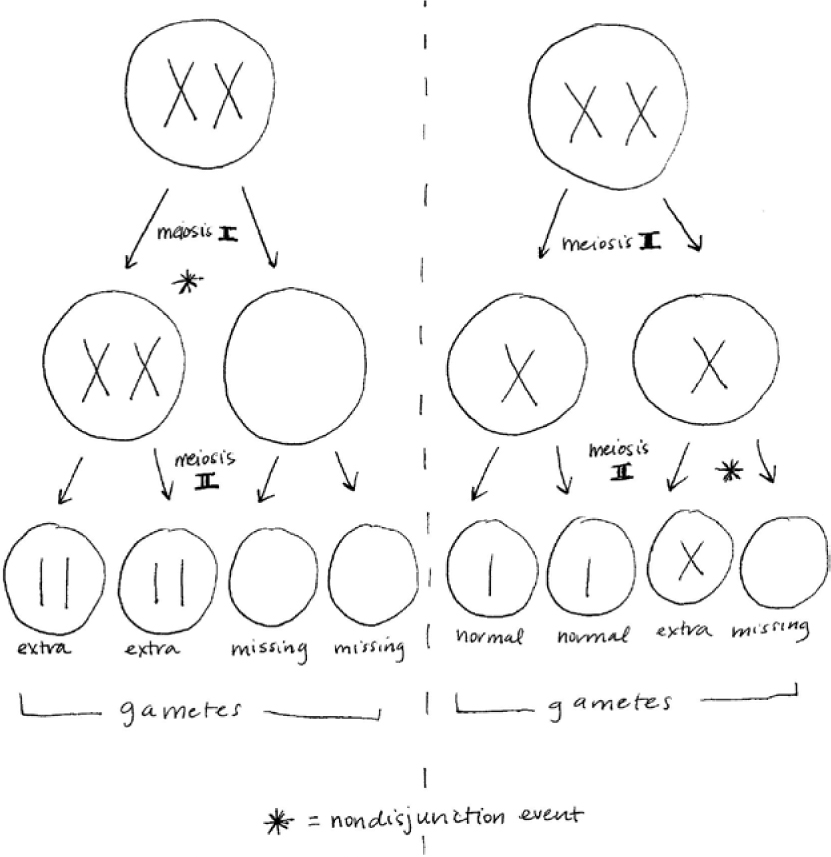
- Individuals with Down syndrome have three copies of chromosome 21, so they have an additional copy of the genes and elements present on this chromosome. Although the exact gene(s) responsible for this syndrome are still unknown, the increased dosage of chromosome 21 results in a group of traits which are characteristic of Down syndrome including mild to moderate mental disability, short stature, unique facial features and shorter life expectancy.
S-38
S-39
Chapter 16 Self-Assessment Answers
- Mendel’s experimental approach differed from others of the time because he focused on easily classified traits with contrasting characteristics (green seeds vs. yellow seeds) that were true breeding (i.e., plants with yellow seeds gave rise to offspring with yellow seeds). Mendel also counted the progeny of his crosses and looked for statistical patterning.
- A gene is a unit of heredity. Alleles are the different forms of the gene. A genotype is the particular combination of alleles present in an individual and the phenotype is the expression of that trait in an individual. For example, in Mendel’s experiments he looked at the gene for seed color. This gene had two alleles, yellow (dominant) and green (recessive). The genotype of a seed could be AA or Aa and the resulting phenotype would be yellow seeds. The genotype of green seeds (phenotype) was aa.
- Mendel’s two laws are: (1) the principle of segregation states that alleles will separate equally into different gametes, and (2) the principle of independent assortment, which states that different gene pairs segregate independently of one another.
- The segregation of alleles reflects the separation of chromosomes in meiosis. Homologous chromosomes separate during anaphase I of meiosis I, leading to the segregation of the alleles. Chromosomes display independent assortment during meiosis when they are sorted into daughter cells randomly.
- By knowing the genotypes of the parents, the genotypes and phenotypes of the offspring can be predicted by using a Punnett square. A Punnett square predicts the probability of every possible combination of one maternal allele with one paternal allele for a particular cross. For example, if a homozygous dominant red parent (RR) was crossed with a homozygous recessive white parent (rr) the offspring predicted by the Punnett square would all have the genotype Rr and phenotype of red (R, red, is dominant over r, white).
- A testcross would be useful if you did not know which allele was dominant. For example, Mendel didn’t know if yellow or green seeds were dominant, but by doing a testcross he was able to figure out that the yellow seed trait was dominant over the green seed trait by looking at the progeny when he crossed the two parental plants.
- The addition rule applies when the possible outcomes being considered cannot occur simultaneously. The multiplication rule applies when outcomes can occur simultaneously and the occurrence of one has no effect upon the likelihood of the other. Using these two rules, the probability that a particular genotype will occur can be determined from a known parental cross.
- See attached pedigrees. The first pedigree displays a recessive trait. It is recessive because it does not occur in every generation, and two non-affected individuals had two affected children. The second pedigree displays a dominant trait. It is dominant because it appears in every generation.
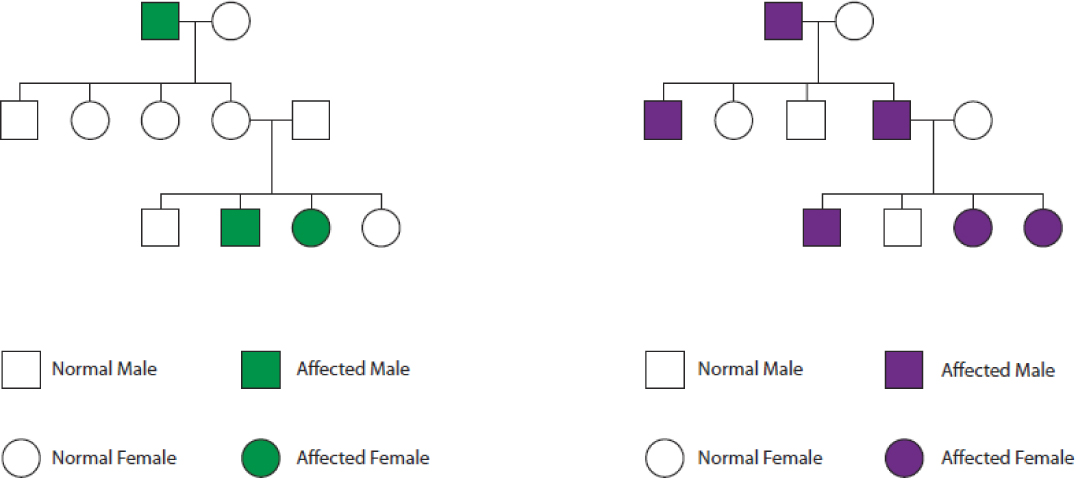
- The benefits of genetic testing include screening for potentially fatal or damaging diseases. For example, there are certain mutations in the BRCA2 gene that puts an individual at an extremely high risk for breast cancer. If a patient is screened and found to have this mutation, preventative measures can be taken to hopefully avoid cancer. There are risks of genetic testing, however. Discrimination against individuals based on their genetic information is an issue, especially when it comes to health care. There are also direct-to-consumer companies that give you your genetic information without the consent of your doctor. This information could be misleading if you do not understand how the tests were performed and what the probabilities mean.
S-40
S-41
Chapter 17 Self-Assessment Answers
- The X and Y chromosomes can pair during meiosis through regions of homology located near the tips of the chromosomal arms.
- Meiosis in the mammalian egg cell results in X-bearing eggs only. In contrast, meiosis in the sperm cell results in a 1:1 ratio of X-bearing and Y-bearing cells. Random fertilization of the egg results in a 1:1 ratio of female to male offspring.
- See diagram. In the first cross, a homozygous normal female is crossed with an affected male; their resulting progeny are all of normal phenotype. In the second cross, a heterozygous female is crossed with an affected male; their resulting progeny are half affected phenotype and half normal phenotype. In the third cross, a heterozygous female is crossed with a normal male; their resulting progeny are ¾ normal phenotype and ¼ affected phenotype. In the fourth cross, a homozygous affected female is crossed with an affected male; their resulting progeny would be all affected.
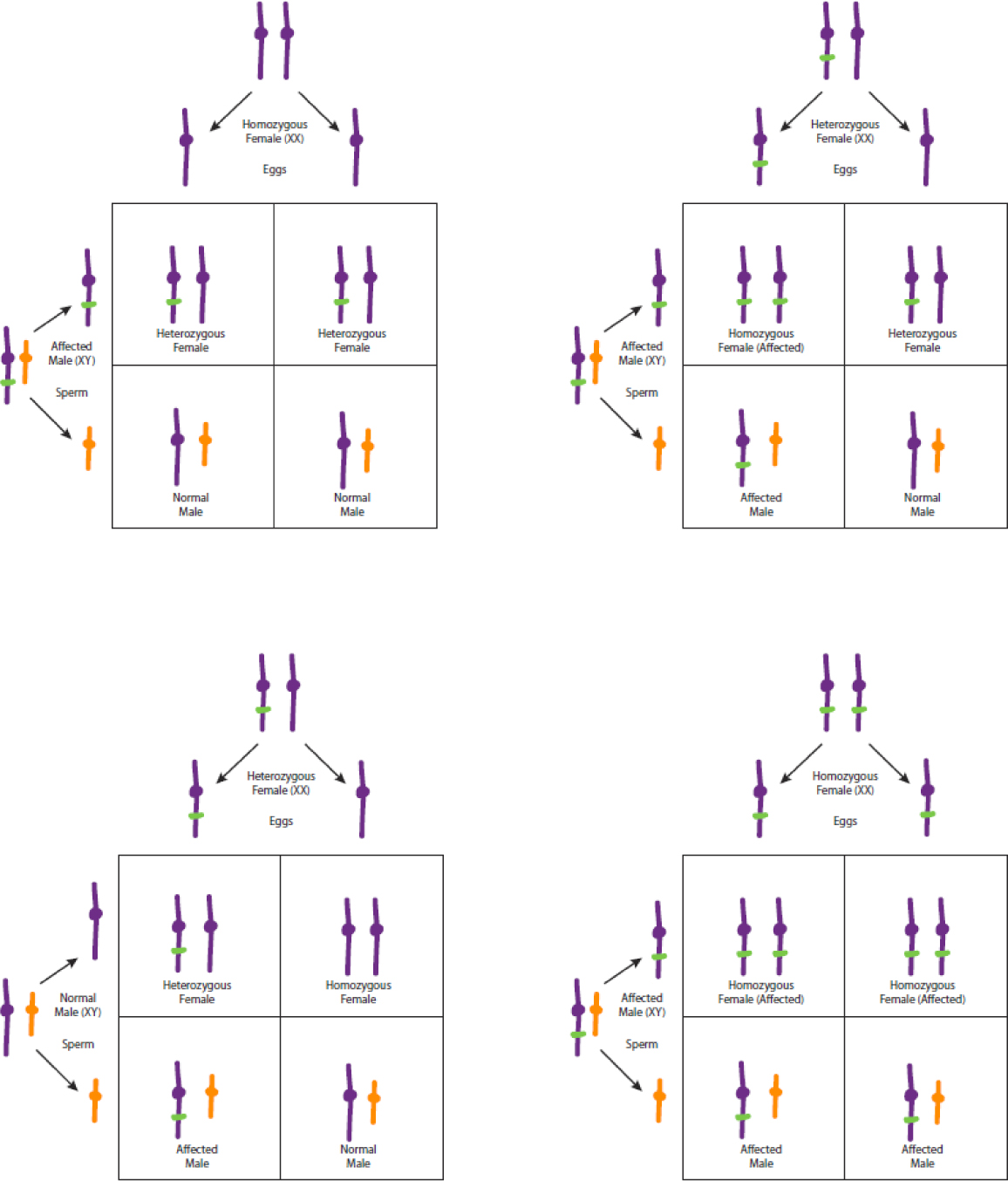
- Linked genes do not exhibit independent assortment because they are located sufficiently close together on the same chromosome.
- The closer, or more tightly linked, that two genes are to each other, the smaller the frequency of recombination because it is less likely that a crossover event would take place in the interval between them. The further two genes are from each other the greater the frequency of recombination because there would be a greater chance that a crossover event would happen in the interval between the genes. The frequency of recombination can be used as a measure of distance between the genes.
- For a Y-linked gene, only males are affected with the trait. Females never inherit or transmit the trait, and all sons of affected males are affected. This is due to the fact that males get their Y chromosome from their father only.
- A gene present in mitochondrial DNA is transmitted from the egg cell (mother) to the offspring. Both males and females can show the trait, all offspring from an affected female show the trait and males never transmit the trait to their offspring.
- Y-linked genes show complete linkage, and mitochondrial DNA does not undergo recombination and is maternally inherited. For these reasons, Y-linked and mitochondrial DNA are good traits to use when tracing ancestry.
S-42
S-43
S-44
Chapter 18 Self-Assessment Answers
- Examples of a complex traits are height, weight, hair color, skin color, heart disease, diabetes, cancer, depression, high blood pressure, number of eggs laid by hens, milk production in dairy cows, and yield per acre of grain.
- Complex traits are often called quantitative traits because phenotype is measured along a continuum with only small intervals between similar individuals. In many complex traits the phenotype is determined by measurement.
- Several factors that can influence variation in complex traits are environmental factors like sunlight, moisture or nutrition, and genetic factors such as multiple genes affecting a single trait.
- It does not make sense to try and separate the effects of genes and the environment in a single individual because they are so intimately related that it would be nearly impossible, and mostly meaningless, to split them apart.
- Let’s say you wanted to test the effects of diet on diabetes development in two sets of mice with different genotypes. Fed a normal diet, the two mice strains have normal levels of blood glucose, but when fed a high-fat and sugar diet, one mouse genotype displays diabetic symptoms while the other does not. This experiment separates the environmental influence of diet on a particular complex trait, diabetes, and shows that both the environment and genotype are important for the development of disease.
- See attached graph. The resulting shape of the graph is called a bell-shaped curve or normal distribution.
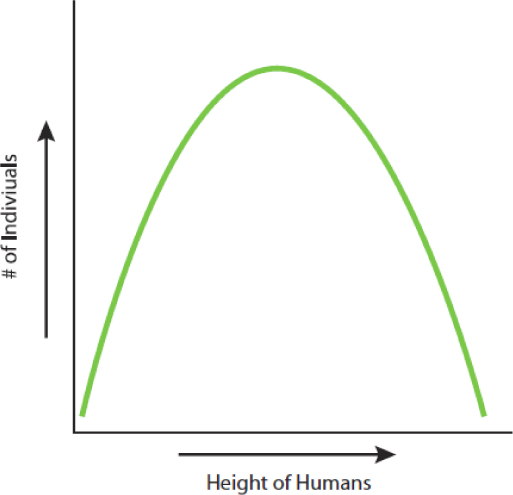
- The effect of genotype on a phenotype cannot always be determined without knowing what the environment is and vice versa because in many cases you will not see a phenotype if both conditions are not represented. In the example of the obese mouse phenotype in Figure 18.6, you only get obese mice when both the underlying genotype is present and the mice are fed a high-fat diet (environment).
- Regression toward the mean explains that offspring exhibit an average phenotype that is less different from the population mean than that of their parents. Or, in other words, children of short parents tend to be closer to the population mean height (i.e., taller than their parents).
- Heritability of a trait is the proportion of the total variation due to genetic differences among individuals. Heritability depends on the population being studied because the influence of the environment and the genotypes of the populations are going to be different for different populations or even the same population at different times. Thus, these factors change the relative heritability of that complex trait.
- Concordance is defined as the percentage of cases in which both members of a pair of twins show the trait when it is known that at least one member shows it. Identical twin studies can be used to investigate the importance of environment and genetic factors in the expression of a trait because both twins have the same genotypes. The variable in this situation is the environment resulting in researcher’s ability to tease apart effects of genes and environment on a particular trait.
- When few genes contribute to a trait, each one typically has a large effect. Conversely, when many genes contribute to a trait, each one typically has a small effect.
- Personalized medicine is when the patient’s genotype for a particular disease is known and a treatment is matched specifically to the genetic risk factors of that patient.
S-45
S-46
Chapter 19 Self-Assessment Answers
- Gene expression is when genes are turned on, and gene regulation controls when gene expression happens. Gene regulation makes sure that the gene is turned on in the right place at the right time in the right amount.
- Gene regulation can occur at each level of gene expression. For example, a gene expression can be regulated during transcription, translation or posttranslation.
- Bases can be modified by attaching a methyl group to cytosine. When several cytosines are methylated in close proximity it creates a methylated CpG island. When a methylated CpG island is near a promoter region, that gene is usually repressed or turned off. Chromatin, which is comprised of DNA, RNA, and proteins, is wrapped around an octamer of histone proteins. When chromatin is coiled tightly around the histones, the DNA is not accessible to transcription proteins. However, when the chromatin unravels from the histone through chromatin remodeling, the transcription proteins can access the DNA and begin transcribing it.
- The level of expression of X-linked genes is the same for both sexes. This means that one of the X chromosomes needs to be inactivated in female cells (XX). This phenomenon is called X-inactivation and is a means of dosage compensation. Thus females are actually a mosaic of tissues where sometimes the maternal X is expressed and other times the paternal chromosome is expressed. In calico cats, which are always female, the orange and black fur color is due to different alleles of a single gene on the X-chromosome. Based on which X chromosome is active, the cat will have a different color fur in that area.
- One protein-coding gene can code for more than one polypeptide chain through the mechanism of alternative splicing. By leaving in various exons or splicing them out, the spliceosome can splice the RNA in different ways to yield different proteins.
- One way in which gene expression can be influenced after mRNA is processed and leaves the nucleus is through the actions of small regulatory RNAs or small interfering RNA that can either inhibit or degrade mRNA respectively. A second way is to alter the 5’cap of the mRNA so translation initiation cannot occur. Altering or deleting the poly A tail is a third way in which translation of the mRNA can be inhibited.
- See below diagram.

- The CRO-cAMP complex helps regulate which compounds are utilized first by the bacterium. In the absence of glucose, E.coli’s preferred energy source, cAMP levels are high and the CRP-cAMP complex binds to a site near the promoter of the lac operon and activates transcription. In the presence of glucose, cAMP levels are low and the CRP-cAMP complex does not bind, and transcription is not induced to high levels even in the presence of lactose.
S-47
S-48
Chapter 20 Self-Assessment Answers
- Totipotent cells can give rise to a complete organism and can be found in the fallopian tubes as a fertilized egg. Pluripotent cells are able to give rise to any of the three germ layers, and therefore to any cell of the body, but cannot give rise to an entire organism. Embryonic stem cells are pluripotent and can be found in the inner cell mass of the blastocyst. Multipotent cells are further along in differentiation than pluripotent cells and can form a limited number of specialized cell types, such as the cells of the mesoderm, which differentiate into skin, muscle, bone, and red blood cells, and can be found in the gastrula.
- Stem cell therapy for an individual might someday consist of taking that person’s own adult cells and reprogramming them, through various methods, into pluripotent and multipotent stem cells. These cells could be programmed to replace burned tissue, defective heart muscle, regenerate nerve cells, etc. The possibilities of this technology are great.
- See below diagram.
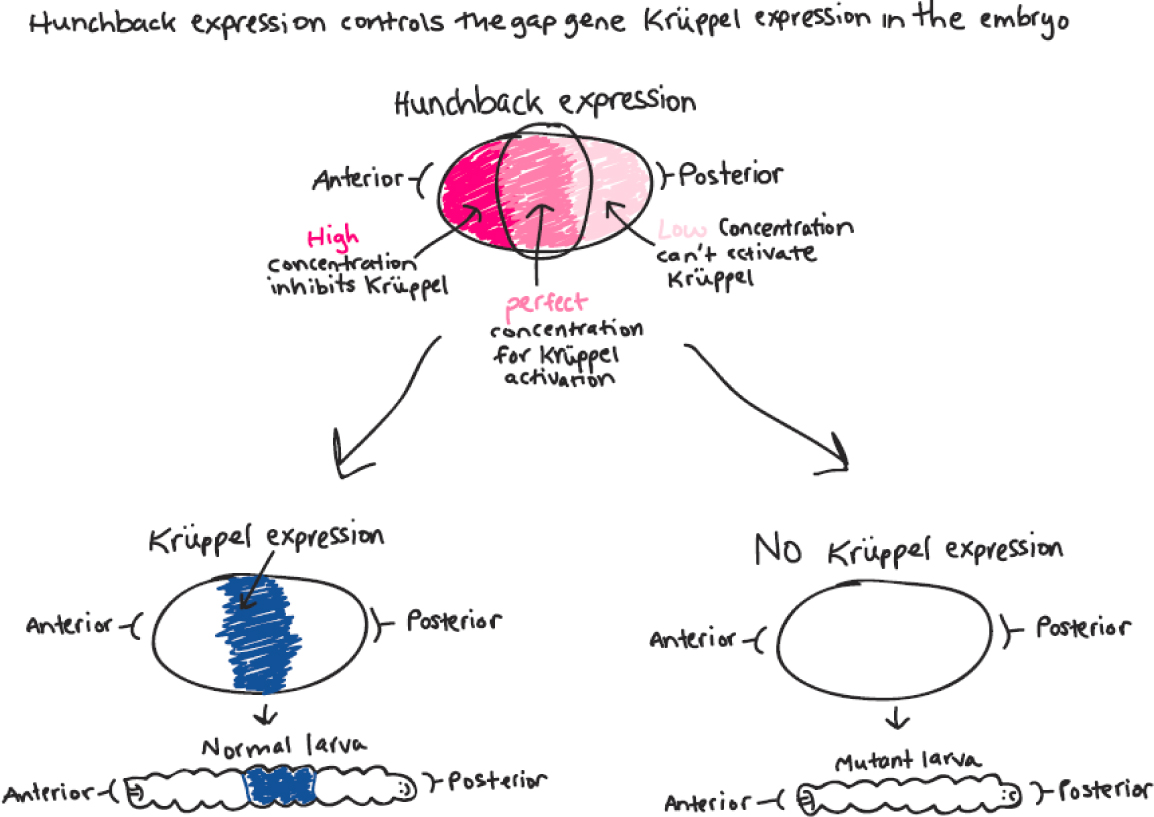
- A homeotic gene is a gene that specifies the identity of a body part or segment during embryonic development. A mutation in Bithorax causes the fruit fly to have two T2 segments in a row and thus two pairs of wings.
- Some genes are evolutionarily conserved because they carry out a vital function. For example, the development of eyes (from planaria to humans) have evolutionarily conserved genes because sight is a desirable trait in order to survive and reproduce in ones environment.
- Combinatorial control describes the regulation of gene transcription according to the mix of transcription factors in the cell. In the floral development ABC model, “A” transcription factors are involved in the development of whorl 1 and 2, “B” transcription factors are involved in whorl 2 and 3, and “C” transcription factors are involved in whorl 3 and 4 development. In whorl 3, for example, both sets of transcription factors (“B” and “C”) have to be present for the formation of the stamen of the flower.
- See below diagram.
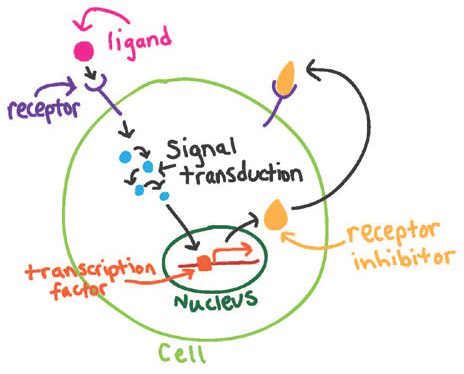
S-49
Chapter 21 Self-Assessment Answers
S-1
- A phenotype refers to the characteristics or traits of an organism that can be observed, such as the color of a flower‘s petals or a person’s height. Phenotypes are determined both by an organism’s underlying composition of alleles, also known as its genotype, and by the environment.
- Mutations can increase the ability of an organism to survive or reproduce (helpful), decrease the organism’s fitness (harmful), or have no effect on the organism (neutral).
- Genetic variation refers to the differences that exist between individuals within the nucleotide sequences of their genomes.
- Measuring genetic variation can be done by counting the number of individuals with observable differences (phenotypes) for a given trait; using gel electrophoresis to detect differences in the properties of enzymes encoded by variable nucleotide sequences; or by direct sequencing of regions of DNA, which is the current method for measuring genetic variation today.
- The frequency of each allele at a given locus can be determined by tallying the number of each allele that is contributed by each genotype present in a given population. For example, if 30% of a population is homozygous dominant for a particular trait (AA), 45% are homozygous recessive (aa), and 25% are heterozygous (Aa), the frequency of each of the two alleles, A and a, can be determined. Each homozygous dominant individual contributes two identical A alleles (30% or 0.3 × 2 = 0.6), and each heterozygote contributes one dominant allele (45% or 0.45 × 1 = 0.45). If we assume the population in question is diploid, the total number of alleles in the population will be two times the number of genotypes (200% or 2.0). Thus, the frequency of the A allele is 0.6 + 0.45/2 = 0.525 or 52.5%. The allele frequency of the recessive a allele can then be determined in a similar manner ((0.25 × 2) + (0.45 × 1) = 0.95/2 = 0.475 or 47.5%).
- Any change in the frequency of alleles or genotypes within a population over time is considered evolution.
- When a population is under Hardy-Weinberg equilibrium, allele and genotype frequencies do not change over time, and thus no evolution occurs within that population.
- For a population to be under Hardy-Weinberg equilibrium, the following five assumptions must be met: (1) there can be no selection, meaning that all genotypes must be equally likely to survive and reproduce within the population; (2) there can be no migration of individuals into or out of the population; (3) there can be no mutations in the DNA sequence of any individuals in the population; (4) there must be a sufficiently large population to avoid chance events altering the allele or genotype frequencies; and (5) individuals within the population must mate randomly with one another regardless of their genotype.
- For a population that is under Hardy-Weinberg equilibrium, known allele frequencies can be used to determine the genotype frequencies in that population using the Hardy-Weinberg equation. According to this equation, where p represents the allele frequency of one allele and q represents the frequency of the second allele, the frequency of homozygous dominant individuals is given by calculating p2, the frequency of homozygous recessive individuals is given by calculating q2, and the frequency of heterozygous individuals is given by calculating 2pq. For example, in a population with a dominant allele frequency of 60% (p = 0.6) and a recessive allele frequency of 40% (q = 0.4), the genotype frequencies for homozygous dominant, homozygous recessive, and heterozygous individuals would be 0.36 or 36%, 0.16 or 16%, and 0.48 or 48%, respectively.
- Changes in allele or genotype frequencies can occur through natural selection (the preferential survival and reproduction of individuals with certain alleles based on their fitness for their environment), gene flow (the migration of individuals into or out of a population), mutation (changes in a DNA sequence), genetic drift (random shifts in allele frequency due to chance events within a small population), or non-random mating (either by choice, based on the organism’s mate preferences, or by force, as in artificial selection where a breeder determines which individuals will mate).
- Natural selection is an evolutionary process that causes a change in allele or genotype frequencies within a population over time based on the relative fitness of each genotype in a particular environment. Due to competition for limited resources, those individuals with alleles that allow them to survive and reproduce better than individuals without those alleles will be more likely to pass on their genes to the next generation, thus preferentially maintaining these alleles in subsequent generations of the population and allowing for adaptation of the population to their environment over time. Natural selection is unlike other forms of evolution because it consistently results in populations that are better suited for their environment; non-adaptive evolutionary mechanisms, such as genetic drift, result in random changes in allele or genotype frequencies, which usually do not lead to adaptation of the population.
- A molecular clock is a region of DNA that has a known rate of mutation over time—the more differences observed when comparing these sequences from different species, the longer it has been since they diverged from one another. The relative timescale of divergence generated through the use of a molecular clock can be further clarified using chronological information from the fossil record.
S-2
S-3
Chapter 22 Self-Assessment Answers
- Although no one definition is able to perfectly describe the genetic boundaries between different organisms, the biological species concept defines a species as a group of organisms that can share genetic material by interbreeding with one another to generate viable, fertile offspring. By this definition, organisms that cannot successfully reproduce with one another are therefore considered different species.
- According to the morphospecies concept, organisms of the same species often have very similar appearances, so careful observation of the phenotypic characteristics of the organisms could provide insight into how many species were represented in the group. If possible, a more rigorous test would be to determine whether the organisms could breed with one another to produce viable, fertile offspring.
- Since the biological species concept defines species based on their ability to interbreed to generate viable, fertile offspring, those organisms that reproduce asexually (such as bacteria) and those that are extinct cannot be easily characterized by this definition.
- Since resources are limited in every habitat, each species must have a unique niche within its environment in order to avoid competition with other species, thus organisms with overlapping ecological requirements are likely members of a single species. In addition, organisms of a single species will have a high degree of genetic identity due to a shared ancestral lineage, so information about the evolutionary history of an organism can suggest whether a group of organisms is indeed a single species or whether they have genetically diverged from one another to form two separate species.
- Reproductive barriers that prevent fertilization (pre-zygotic) include differences in mating behaviors like courtship rituals, mechanical blocks to fertilization such as differences in the genitalia required for mating, and biochemical incompatibilities in the gametes that can limit the fusion of sperm and egg. After fertilization has occurred, post-zygotic barriers limit the ability of the zygotes formed from gametes of different species to develop into fertile adults because of differences at the genomic level such as an improper number of chromosomes.
- In order for populations to genetically diverge from one another, they must have limited gene flow between them. Reproductive isolation limits the production of hybrid offspring, so genetic exchange between populations is reduced and divergence continues as each population is subjected to the selective pressures of their environment and genetic drift. In addition, if populations begin to diverge through genetic drift or disruptive selection, these differences can result in establishment of a reproductive barrier, which would then work to limit further genetic exchange and promote reproductive isolation.
- Allopatric speciation, which is thought to happen more often than sympatric speciation, occurs after a geographic barrier physically separates two populations from one another, which limits gene flow and promotes genetic divergence of the two populations as they adapt to their different environments. Sympatric speciation is the divergence of one group of organisms into distinct species within the same geographical area, so that although the organisms inhabit the same area and come in contact with one another, gene flow is limited because of strong selection against hybrid offspring.
- Allopatric speciation can occur if a subset of a population moves to a new location far from the original population (dispersal), like if a hurricane blew a group of beetles to a distant island off the coast of the mainland. Allopatric speciation can also occur by vicariance, which is when a change in the environment effectively separates a population into two distinct groups. An example of allopatric speciation by vicariance would be if a lake receded and began to dry out leaving only smaller, isolated ponds behind. Fish from a single species might be split among several different ponds, each of which would be subject to genetic divergence based on the conditions in their respective pond and genetic drift, which over time could lead to speciation.
- Since genetic drift acts randomly to alter allele frequencies, the alleles that become fixed or extinct in a given population will be different in each population. These differences, accumulated over time, can result in genetic incompatibility, which will limit gene flow and lead to the establishment of two different species.
- Speciation is the result of genetic divergence between two populations to the point where they are no longer capable of producing fertile offspring. Natural selection can drive genetic divergence of populations based on the characteristics that are favorable in each population’s environment, which may also influence their reproductive compatibility with other populations. The characteristics that allow for optimal survival and reproduction in one population will be specific for its environment, so two populations that have lived in different locations for a long time, both being adapted to their environments by natural selection, will likely encounter reproductive barriers, limiting gene flow between the populations and reinforcing speciation.
S-4
S-5
Chapter 23 Self-Assessment Answers
- Two examples of a nested pattern of similarity among organisms are (1) a dog and a wolf are more similar to each other than either is to a cat, and (2) a dog, a wolf, and a cat are more similar to each other than they are to a turtle.
- See drawing.

- Monophyletic groups are groups in which all members share a single common ancestor not shared with any other species or group of species, like amphibians. Paraphyletic groups include some, but not all, of the descendants of a common ancestor, like birds being excluded from the “reptile” group even though there is evidence that they share a common ancestor. A polyphyletic group does not include the last common ancestor of all members, like putting bats and birds in the same group.
- The levels of classification are as follows: species, genus, family, order, class, phylum, kingdom, and domain.
- A homologous trait is one that results from shared ancestry, such as an amniotic egg and lungs. An analogous trait is a similarity that results from convergent evolution, such as bird and bat wings or echolocation.
- Synapomorphies are useful in building phylogenetic trees because the homologies are shared by some but not all of the members of the group. If an entire group shared the same homologous trait, we would not be able to construct a meaningful phylogenetic tree.
- Three types of fossils are skeletal fossils, trace fossils, and molecular fossils.
- For an organism to be fossilized it must be buried and have features that resist decay after death. Not all organisms fall into these two categories, hence gaps in the fossil record.
- The relative timescale of past events can be determined by the location of the fossil in the Earth’s surface. The absolute timescale can be determined by measuring isotope decay. Carbon, uranium, and lead are all used to date fossils.
- Archeopteryx is a fossil organism that shows the transition from bird to dinosaur, and Tiktaalik is a fossil organism that shows the transition from fish to tetrapod in the fossil record.
- Mass extinctions have shaped the ecological landscape by allowing the survivors to live and reproduce thus introducing new mutations into the population.
S-6
S-7
Chapter 24 Self-Assessment Answers
- Using a phylogenic approach based on anatomical characteristics, scientists found that either chimpanzees or gorillas were the closest living relatives of humans. Chimpanzees were identified as being humans’ closest living relatives when molecular techniques were used to compare the genetic material of chimpanzees and human. Scientists found that our genomes differ by about 1% from that of chimpanzees.
- The out-of-Africa theory of human origins suggests that modern day Homo sapiens evolved from a descendant of Homo ergaster in Africa about 200,000 years ago. Mitochondrial DNA and the Y chromosome do not undergo recombination, so the only genetic variation arises from mutation. By studying these two types of genetic material, scientists were able to calibrate the rate at which mutations occur and determine the time line of modern-day Homo sapien occurrence.
- Three anatomical differences between chimpanzees and humans that allow humans to walk upright are: (1) the human spine is S shaped so that weight is distributed right over the pelvis; (2) the human foot is narrower, has a more developed heel, and a larger big toe that facilitates a springier step; and (3) the foramen magnum is repositioned in humans so that the skull is balanced directly on top of the vertebral column.
- Differences we see between humans and chimpanzees can be accounted for by differential gene expression. Basically the same genes are expressed in both organisms, but at different times in the developmental stages.
- Three possible selective factors underlying the evolution of large brains in human ancestors are: (1) tool use (manual dexterity requires a complex nervous organization); (2) social living (groups require coordination, communication, and a means of integrating and acting upon the information conveyed); and (3) language (communication requires a complex nervous system).
- Differences among different human populations arose by natural and sexual selection. Natural selection can be seen through the evolution of skin color and body shape and size. Sexual selection can be seen through the predominance of different facial features in different races.
- The idea that culture, language, and consciousness are uniquely human can be supported by the observation that humans do all three of these things to a higher level of sophistication than any other organism. However, many other organisms have simpler versions of culture, language, and consciousness, so the idea that all three are uniquely human is incorrect.
S-8
Chapter 25 Self-Assessment Answers
- Photosynthesis and respiration are key processes that drive the short-term carbon cycle.
- See attached for drawing. The curve representing changing atmospheric levels of CO2 over the course of a year oscillates with the seasons because photosynthesis, which takes CO2 out of the atmosphere, is more active during the summer months and less active during the winter months. Respiration levels, which return CO2 to the atmosphere, remain constant throughout the year.
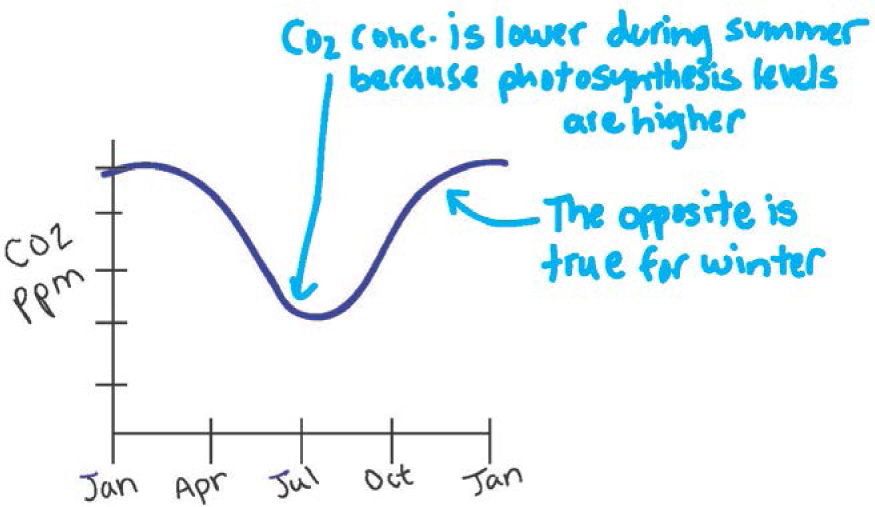
- See attached for drawing. The curve representing changing atmospheric levels of CO2 over the past 150 years shows a steady increase in levels of CO2, mainly due to human activities.
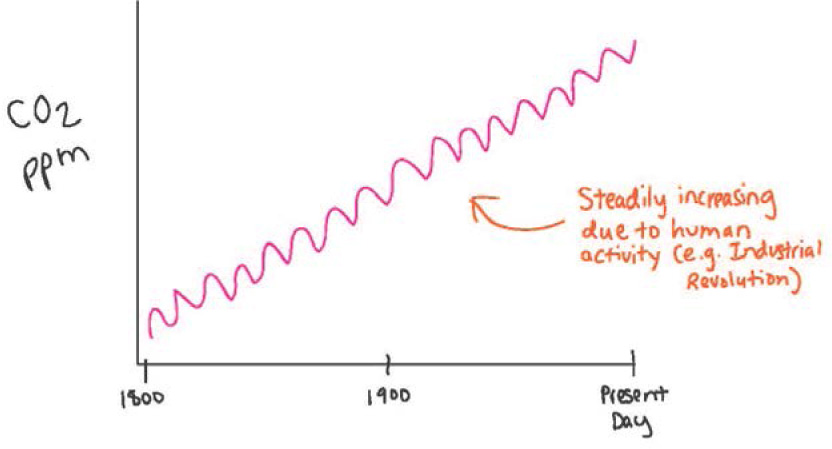
- One way in which the source of increase in CO2 in the atmosphere can be determined is through the measurement and tracking of carbon isotopes. By measuring the ratios of all three carbon isotopes, scientists can hypothesize as to where the increase of CO2 is coming from.
- The processes that influence the long-term carbon cycle are volcanism; chemical weathering; oceanic crust weathering; and oxidation of coal, oil, and ancient organic matter.
- See attached for drawing. The curve representing the changing atmospheric levels of CO2 over the past 500,000 years shows an oscillation pattern that seems to reflect the interglacial and glacial periods.
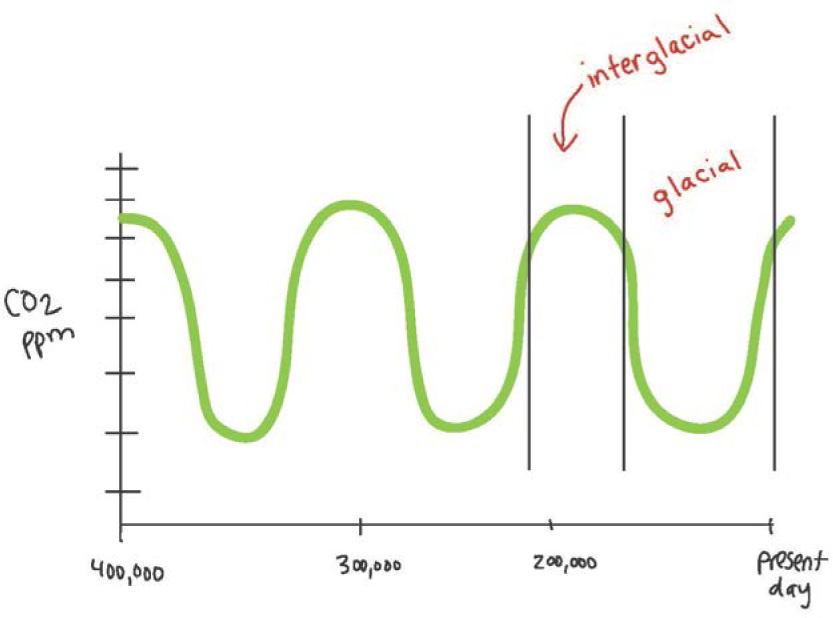
- See Figure 25.13 for an example of cycling carbon and energy through a community.
S-9
S-10
Chapter 26 Self-Assessment Answers
- The three domains of life are Eukarya, Archaea, and Bacteria. Eukarya consists of eukaryotic cells, whereas Archaea and Bacteria consist of similar but different prokaryotic cells.
- Prokaryotic cells do not contain a nucleus or other membrane-bound organelles, they do not have introns in their genes, their DNA occurs in a circular form, and they are relatively small in size when compared to eukaryotic cells. When contrasted against Bacteria, Archaea have different lipids present in their membrane, do not undergo photosynthesis using chlorophyll, are capable of methanogenesis, and have histone proteins in their cells.
- Prokaryotic cells obtain nutrients through diffusion. This keeps their size relatively small due to the need for nutrients to reach all areas of the cell.
- A small cell has more surface area in proportion to its volume, whereas a bigger cell has less surface area in proportion to its volume.
- Anoxygenic photosynthesis use hydrogen sulfide, hydrogen gas, ferrous iron, and arsenite instead of H2O as electron donors, thus they do not release O2 as a by-product. Respiration can occur without requiring oxygen when alternative electron acceptors such as nitrogen sulfur, manganese, iron, and arsenic are used instead of O2.
- In the sulfur cycle, bacteria and archaeons reduce sulfur in a process called anaerobic respiration, and oxidize sulfur through chemosynthetic and photosynthetic processes. In the nitrogen cycle, bacteria and archaeons fix nitrogen gas to ammonia and through the processes of nitrification, denitrification, and anammox turn ammonia back into nitrogen gas.
- Horizontal gene transfer complicates evolutionary relationships among bacteria and archaeons because phylogenies may falsely group distantly related bacteria by grouping genes passed on by conjugation, transformation or transduction.
- Proteobacteria are the most diverse of the bacterial groups and contain many organisms that populate the expanded carbon and other biogeochemical cycles. Gram-positive bacteria include both pathogens and bacteria that produce antibiotics. Cyanobacteria are species of bacteria that can undergo oxygenic photosynthesis.
- The three major groups of Archaea are the Crenarchaeota, Euryarchaeota, and Thaumarchaeota. The first two groups include acid-loving and heat-loving organisms. Euryarchaeota also include methane-producing and salt-loving organisms. Thaumarchaeota, which survive in colder, oxygen-poor environments, like the deep ocean.
- The Earth is about 4.5 billion years old, and life is thought to have first originated around 3.5 billion years ago.
S-11
Chapter 27 Self-Assessment Answers
- Key features that distinguish a eukaryotic cell from a prokaryotic cell are: a cytoskeleton that allows cells to change shape by remodeling quickly, typically larger in shape, a nucleus, and membrane-bound organelles.
- Forms of energy metabolism found in eukaryotes are aerobic respiration in the mitochondrion and photosynthesis in the chloroplast.
- The origin and evolution of the chloroplast and mitochondrion is thought to be through endosymbiosis (where one partner lives within the other). Chloroplasts closely resemble cyanobacteria and are thought to be descendants of symbiotic cyanobacteria that lived within eukaryotic cells. Mitochondria closely resemble proteobacteria and are also thought to have evolved as endosymbionts.
- One hypothesis for the origin of eukaryotic cells is that the host for mitochondrion-producing endosymbiosis was itself a true eukaryotic cell with a coleus, cytoskeleton, and endomembrane system. Another hypothesis for this origin is that the eukaryotic cell as a whole began as a symbiotic association between a proteobacterium and an archaeon.
- The seven superkingdoms of eukaryotes are: (1) Opisthokonts (e.g., animals), (2) Amoebozoans (e.g., slime molds), (3) Archaeplastids (e.g., red algae), (4) Stramenopiles (e.g., brown algae), (5) Alveolates (e.g., ciliates), (6) Rhizarians (e.g., cercozoans) and (7) Excavates (e.g., trypanosomes).
- Through evidence in the fossil record of coastal marine environments, the first eukaryotic cell is thought to have evolved 1800 million years ago.
S-12
Chapter 28 Self-Assessment Answers
- Simple multicellularity involves adhesion of cells with little differentiation between them. Complex multicellularity involves adhesion, signaling, differentiation, and specialization among the cells.
- Complex multicellularity is distributed over the eukaryotic phylogenetic tree and is thought to have evolved independently at least six times.
- Diffusion limits the size of organisms because it acts over small distances. Thus, cells need to be close together in order to get nutrients through diffusion alone.
- Multicellular organisms get around the size limits imposed by diffusion by actively pumping nutrients and other molecules into and out of the cell through bulk transport.
- Multicellular plants have cell walls around their cells, whereas animals do not. This restricts the plant cells from moving.
- The study of sedimentary rocks shows that abundant oxygen came to exist about 580–560 million years ago. This corresponds to the first fossil records of complex multicellular organisms.
S-13
Chapter 29 Self-Assessment Answers
- Vascular plants are better able to sustain photosynthesis than bryophytes because they are able to take up water from the ground through their root system instead of being dependent on the level of water on the surface. Bryophytes dry out when not enough water is available at the surface. As they dry out, they lose the ability to photosynthesize.
- Transpiration is the loss of water vapor from the leaves through evaporation. It is a consequence of acquiring CO2 from the atmosphere. As CO2 diffuses into the leaf through stomata, water vapor diffuses out at a faster rate. Thus, several hundred molecules of water are lost for every molecule of CO2 acquired for photosynthesis.
-
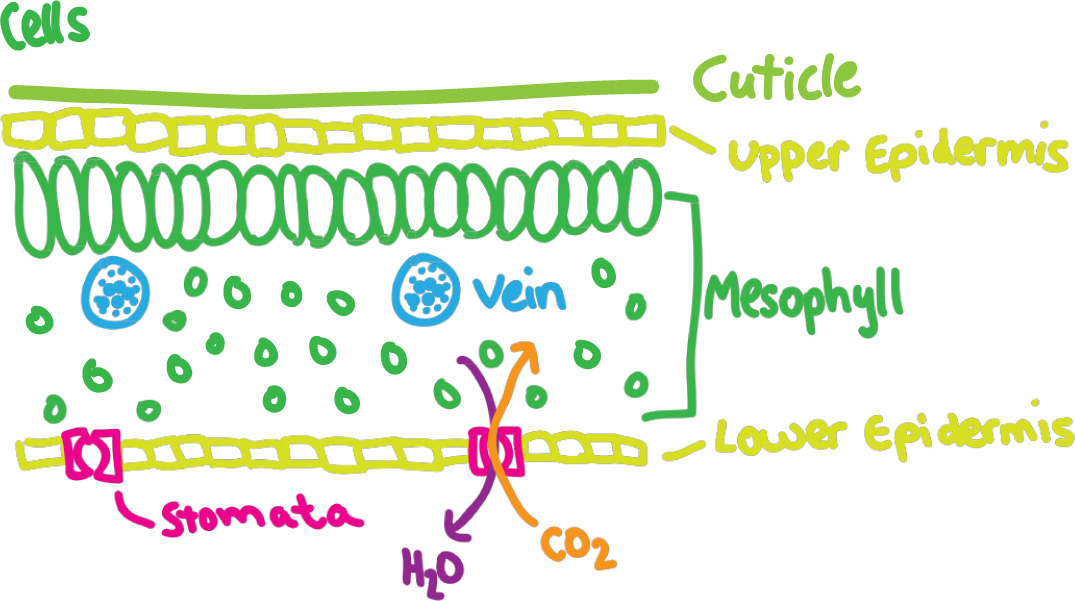
-

-
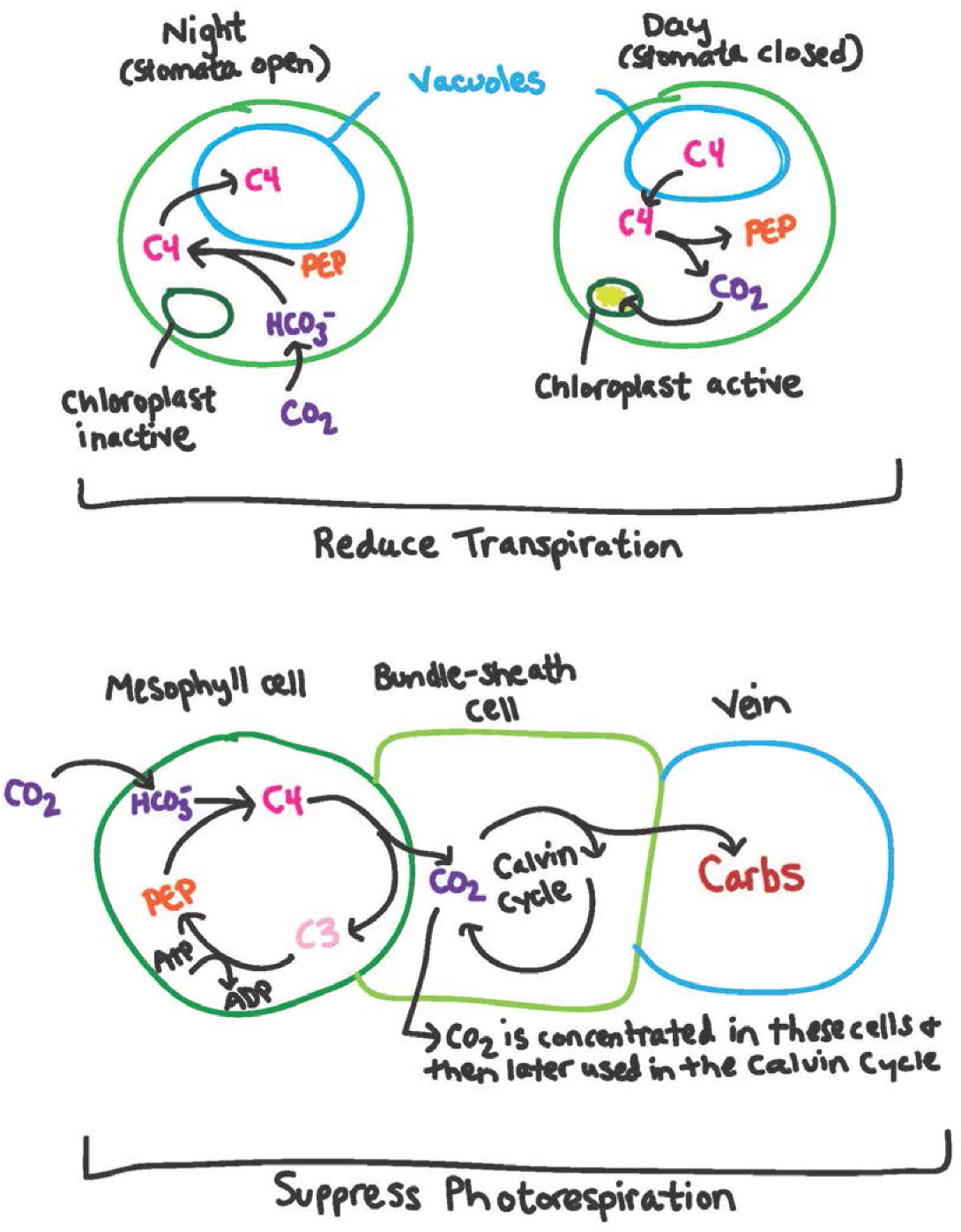
- Water transport in xylem is driven by an evaporative pump whose driving force is generated in the leaves. Thus water moves from the roots to the leaves in xylem. In contrast, the transport of sap in the phloem can go in either direction, from tubers to young leaves or from leaves to roots, for example.
Phloem transport is driven by differences in turgor pressure. Water is drawn into the phloem by osmosis, in response to the active transport of sugar molecules into the phloem. In the influx of water increases turgor pressure at the source. Water leaves the phloem when sugar molecules are transported out into the other plant tissues. The outflow of water reduces turgor pressure at the sink. Water flows from the region of high turgor pressure to the region of low turgor pressure. - Xylem conduits are basically hollow tubes made up of thick cell walls. There is no cytosol or internal organelles. Water is able to flow easily through the hollow tubes
Sieve tubes transport carbohydrates. They are also elongated tubes but they contain cytoplasm and a few organelles. The cytoplasm provides a medium in which to transport the carbohydrates, called phloem sap. - Phloem transports sugars and other nutrients to non-photosynthetic organs, like the roots.
- Four adaptations of roots that enhance the uptake of nutrients from the soil are root hairs of the epidermis; the ability of endodermal cells to control which nutrients enter the vascular system; the beneficial association of mycorrhizae fungi; and the beneficial association of bacteria in the root nodule of some plants like legumes.
S-14
S-15
S-16
Chapter 30 Self-Assessment Answers
- Alternation of generations is the basic plant life cycle in which a haploid gametophyte stage and a diploid sporophyte stage follow one after the other. Alternation of generations has allowed plants to thrive on land since the haploid spores produced by the sporophyte can disperse over a large distance without the need for water.
-


- The four whorls develop into carpels, stamens, petals, and sepals. A stamen has a structure called an anther that contains several sporangia in which pollen is produced. Once the anther splits open and exposes the pollen, the pollen can then be carried by animals or the wind to the sticky stigma of the carpels. Here the pollen germinates and extends its pollen tube down through the style to reach the ovule in the ovary of the carpel.
The often colorful petals attract pollinators. The sepals do not play a direct role in fertilization; they protect the flower during its development. - Gymnosperm pollen and ovules areproduced in separate structures, and pollen is carried to the female structure by the wind. Angiosperms often produce pollen and ovules in one structure, the flower. Some angiosperms take advantage of the wind to disperse their pollen, but more common is the use of animal pollinators.
Because the sites of pollen and ovule formation are near each other in a flower, a pollinator can deliver pollen to one plant and take up pollen to carry to another plant in a single visit. Pollen is captured on the sticky or feathery stigma at the top of the ovary-containing carpel. Many angiosperms invest in rewards like nectar or attractants like scent to lure pollinators. -

- The expression of a gene that allows plants to flower varies with a circadian rhythm, controlled by an internal clock. The protein expressed by the gene is stabilized by light, which is sensed bythe plants’ photoreceptors. Enough of the protein accumulates only when there is overlap between high rates of gene expression and stabilization of the protein by light.
-

- Vernalization is the process in plants in which flowering can be induced only if the plant has experienced a prolonged period of cold temperatures. The mechanism acts through chromatin remodeling, turning on or off genes. Chromatin remodeling is stable through mitotic divisions, explaining why newly formed parts of a plant "remember" developmental events.
S-17
S-18
S-19
S-20
Chapter 31 Self-Assessment Answers
- Stems can grow without a predetermined limit to their length because the apical meristem is continually making new cells while the older cells are still elongating, pushing the apical meristem up.
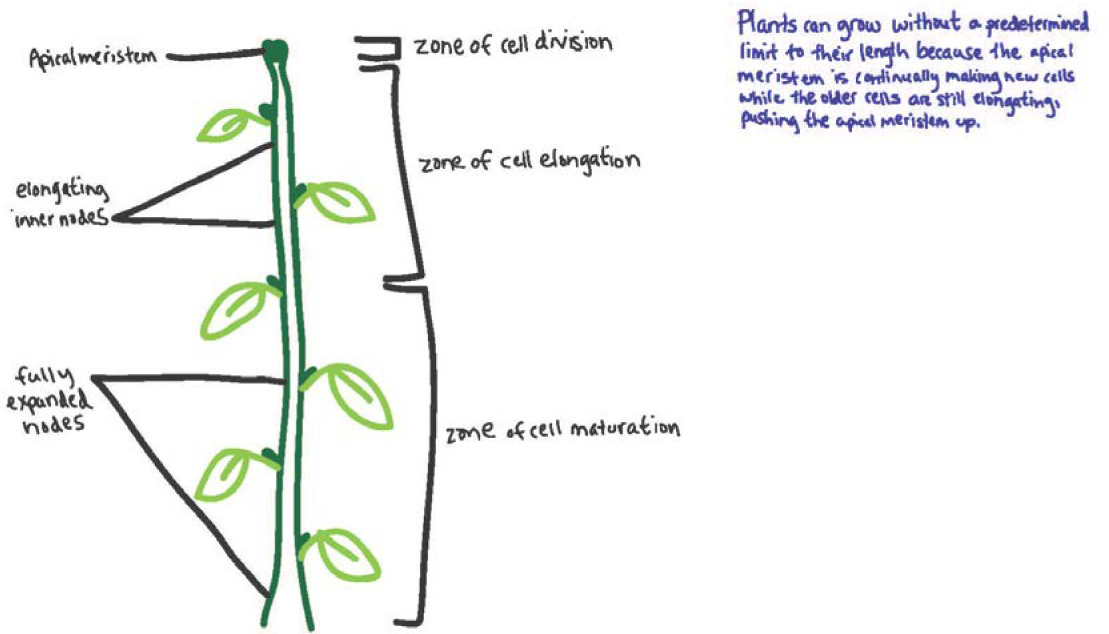
- Plants with internodes that have cells that elongate to a greater extent tend to be taller, like a forest vine. Plants with internodes that have cells that elongate to a lesser extent tend to be shorter, like a barrel cactus.
- Auxin is responsible for stimulating the formation of root meristems, among other things. (Other correct answers are that auxin guides the development of vascular connections between leaves and stem, and between leaves and roots; that it causes shoots to elongate; that it suppresses branching; that it helps orient stems toward the light, and roots downward.)
Auxin is transported through the phloem by polar transport, which is the coordinated movement across many cells in a particular direction. Auxin can only exit cells through PIN proteins, so the placement of PIN proteins on the basal side of each cell will cause auxin to flow from the tip to the base of a plant. - Cork cambium protects the stem of the plant against herbivores, mechanical damage, desiccation, and, in some cases, fire. The plant needs this protection because as the activities of the vascular cambium increase the plant‘s diameter, the primary epidermis eventually ruptures.
- The vascular cambium forms a continuous sheath from root to tip; as a result it produces xylem and phloem along the length of the plant. Cork cambium is discontinuous in both space and time because it is relatively short lived, and in many cases it forms in patches rather than as a continuous layer.
- Stems and roots use the same signals to respond to gravity and light but their responses are opposite. In the stem, light detected by photoreceptors signals the stem to preferentially transport auxin to the shaded side, causing the cells on that side to expand and the stem to bend toward the light. In roots, auxin is again transported to the shaded side of the root, but in this case the rate of cell elongation decreases on that side and the root ultimately bends away from the light. When stems or roots respond to gravity, auxin accumulates on the lower surface (in response tothe movement of heavy starch-filled organelles), but the stem bends up whereas the roots turn down.
- Roots are typically much thinner than stems, allowing them to grow around particles in densely packed soil. The root apical meristem is also protected by a root cap as the root grows through the soil. Finally, the root apical meristem does not produce any lateral organs such as leaves.
You could identify a root in several ways. First, does it have a root cap surrounding the apical meristem? Second, are there thin projections, root hairs, growing from the zone of maturation? Third, how big is the tissue in relation to the rest of the plant, as roots are typically thinner? - Lateral roots develop from a single layer of cells inside the endodermis called the pericycle. A new root apical meristem develops from the pericycle and grows out through the endodermis, cortex, and epidermis to the soil. New roots can form anywhere along the original root and, in some species, even along the stem of the plant. Lateral roots increase the surface area of the root system, allowing it to take up more water and nutrients from the soil.
- There are many examples of how a plant‘s ability to sense its environment improves the plant‘s chances for survival and reproduction. (1) Plants suited to growing in direct sunlight grow taller and branch less when light levels are low. This strategy allows the plant to put energy into reaching the light. (2) Roots elongate more and branch less when water is scarce. The root system is thus able to explore the soil, increasing the plant‘s chance of encountering water reserves. (3) Exposure to wind results in shorter and stronger stems that help the plant withstand the mechanical stress of high winds. (4) Plants use day length as a cue to prepare for winter. For example, as a plant senses winter approaching because of the shortened length of daylight, it creates storage organs in the roots that will provide nutrients for the growth of new leaves and stems the following spring.
S-21
S-22
Chapter 32 Self-Assessment Answers
- Pathogens can enter plants through a variety of mechanisms. Some enter through wounds in the plant stem or leaves. Others enter through the stomata or on the piercing mouthparts of insects or nematodes. Some pathogens even secrete enzymes that weaken epidermal cell walls; they can then force their way through the weakened epidermis and enter the plant. Once inside the plant, the pathogen can grow (as do fungi) or move (as do bacteria) through cell walls. The pathogen can also move through the xylem or phloem..
- Biotrophic pathogens, such as viruses, get their resources from plant cells that are still alive. Necrotrophic pathogens, such as some bacteria, first kill the cell before obtaining the resources from it.
- Two components of the innate immune system are the basal immune system and a specific immune system. The basal immune system consists of receptors on the plant cell membrane that recognize broad features of pathogens such as bacterial flagellin. Recognition triggers a defense response. The specific immune system consists of receptors called R proteins that recognize specific avirulence (AVR) proteins secreted by the pathogens. This interaction between the R and AVR proteins elicits a defense response against the pathogen.
- The hypersensitive response against plant pathogens is one in which the plant cells surrounding the infected tissue make an excess amount of reactive oxygen species, reinforce their cell wells, and finally die. The dead cells form a barrier that prevents the pathogen from leaving the area and infecting the rest of the plant. The growth of necrotrophic pathogens is substantially slowed by a hypersensitive response.
Systemic acquired resistance (SAR) is a plant defense mechanism used in response to necrosis resulting either from a hypersensitive response or a necrotrophic pathogen. A chemical signal is sent from the infected region to non-infected regions through the phloem. This signal triggers the expression of genes that "prep" the non-infected cells for defense in case the pathogen spreads to their area. Thus, systemic acquired resistance increases the ability of uninfected tissues to resist infection. - Rhizobium radiobacter is a bacterium that is especially good at inserting its DNA into the genome of its host plant. This characteristic has allowed scientists to use the bacterium to insert genes of interest into test plants.
- Plants protect themselves from being eaten by herbivores through many mechanisms. These mechanisms may be mechanicalsuch as the presence of hairs on leaves or spines on tree trunks or hard silica plates in the epidermal cells. Plants can also produce a variety of chemicals that can affect anything from the insect‘s nervous system to its development. Some plants have even evolved ecological defenses against herbivory. In exchange for food or shelter, insects, such as ants, will defend the plant from other herbivores. Grasses are not destroyed by grazing because their low-to-the-ground apical meristems are not damaged.
- The biodiversity of plants is affected by the number and kinds of pathogens and herbivores that feed upon them. Plants evolve new forms of defenses and the pathogens and herbivores evolve new mechanisms to overcome these defenses, leading to another round of new plant defenses. An innovation in defense may allow a plant population to expand into new areas, increasing its potential to evolve into new species. Biodiversity is also increased through the mechanism of the Janzen-Connell hypothesis, in which seedlings will survive better if they disperse greater distances from the parent tree. This model selects for high biodiversity in a small area.
- There are often trade-offs between plant growth and plant defense because a plant only has a certain amount of energy and resources to expend at one time. If the plant uses most of its energy and resources in defense against pathogens and herbivores, it may not grow very tall or fast or produce a lot of seeds. Depending on the environment the plant is in, it will allocate its resources to best fit its needs at the time.
-
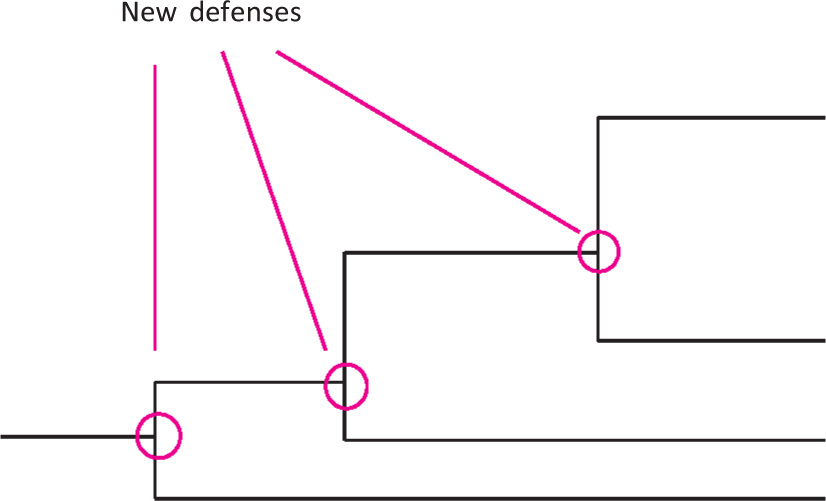
- One disadvantage of herbicide and pesticide use in agriculture is that it is a strong selective force for the evolution of resistance in pathogens. One benefit of these compounds is that it allows farmers to protect their crops and produce vast quantities of products.
S-23
S-24
Chapter 33 Self-Assessment Answers
-
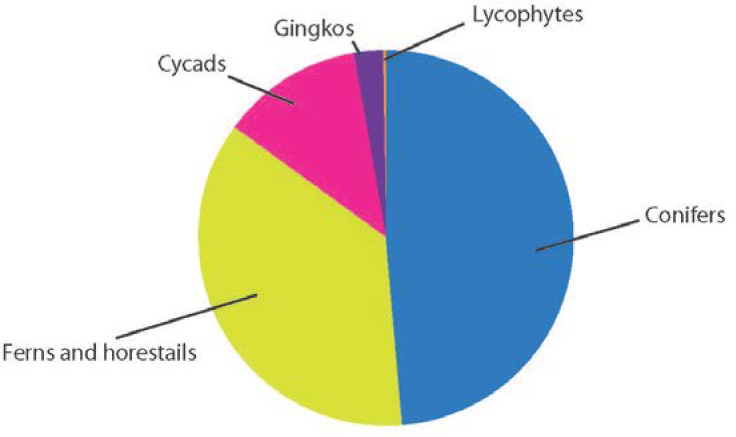
- If mosses, liverworts, and hornworts formed a monophyletic group, we would not be able to infer what the first land plants looked like because they would have arisen from a different unknown ancestor.
- Bryophytes can be found to exist in almost any environment, including the Antarctic continent. Often bryophytes are epiphytes and can live on other plants because they are not dependent on the soil as a source of water. Bryophytes are a main component of peat bogs, wetlands in which dead organic matter accumulates. Bryophytes can be found in swamps and deserts and every environment in between.
- Lycophytes can be found in diverse habitats ranging from the tropical rain forest to the Arctic tundra.
- Ferns are able to elevate their leaves in three ways: (1) by producing thick roots that descend from the leaves to the ground, adding both vascular capacity and mechanical support; (2) by producing leaves that twine around the stems of other plants, using them as support; and (3) by floating on the surface of water, where they have little competition for sunlight.
- Fern diversity has been affected by the evolution of angiosperms because the angiosperms created a vast number of new environments that the ferns could occupy, adapting to each.
- In contrast to fern diversity, cycad and conifer diversity dropped steeply with the appearance of angiosperms.
- Angiosperms transport water in wider multicellular xylem channels, whereas conifers transport water in smaller single-celled tracheids. Because angiosperms are able to take up water more efficiently and thus perform a variety of cellular functions at an increased rate, they had a competitive advantage over conifers in many environments. In cold and dry climates, the size of angiosperm channels is constrained by the dangers of cavitation, thus leveling the playing field for the conifers. In some environments, conifers may even have a competitive edge.
- For wind pollination of conifers to be effective, there has to be a large number of the conifers in the general area so that the probability of the pollen landing on the correct species is high. Animal-pollinated angiosperms can be less densely populated because the animals will seek out the specific plant. Thus the probability that the pollen will get to the right species is high. Therefore, angiosperms do not have to make as much pollen as the conifers because they have a more direct route from plant to plant.
- One feature that might account for the diversity and success of angiosperms is that their flowers and fruits are typically specific for that plant‘s pollinator of choice. By having animals pollinate and spread seeds, angiosperms can reproduce even if they are far apart. As a result, rare species can persist even at a low population density.
Another feature accounting for diversity and success are angiosperm xylem vessels. These vessels have two cells types, allowing them to separate the functions of water transport and mechanical support. Xylem vessels give angiosperms a greater flexibility of form. Angiosperms may thus have been able to adopt a diversity of new forms, such as vines and sprawling shrubs, that better allowed them to grow toward the light.
S-25
S-26
Chapter 34 Self-Assessment Answers
- Fungi do not have organs that enable them to ingest and digest food. Instead, fungi absorb molecules directly through their cell walls after they have first digested the material through the release of enzymes. Fungi are also unable to move to find food, thus they grow to find nourishment.
- Hyphae are numerous long, thin filaments that provide a large surface area for absorbing nutrients. Hyphae grow at the tip, elongating and penetrating into new environments where they may encounter water and new food resources. Chitin allows the cell walls of hyphae to be flexible but strong when compared to plant cell walls.. The cell wall also prevents the cell from rupturing, and it contributes to the formation of positive turgor pressure, the force that allows the hyphae to penetratedeeper into their surroundings.
- Fungi convert dead organic matter back to CO2 and water, thus returning nutrients to the soil where they will be available for plant growth. In particular, fungi are the major decomposers of the cellulose and lignin in wood.
- Lichens are made up of a fungus and a photosynthetic microorganism such as green algae or cyanobacteria. The hyphae of the fungus anchor the lichen, aid in the uptake and retention of water and nutrients, and produce chemicals that protect against excess light and herbivorous animals. The photosynthetic microorganism provides a source of reduced carbons and, in some cases, fixed nitrogen.
- Fungi disperse through the release of spores. A fungus will produce a huge number of spores that will be carried by the wind, water. or animals to different environments. A spore will start to grow only if it is in a suitable environment.
-
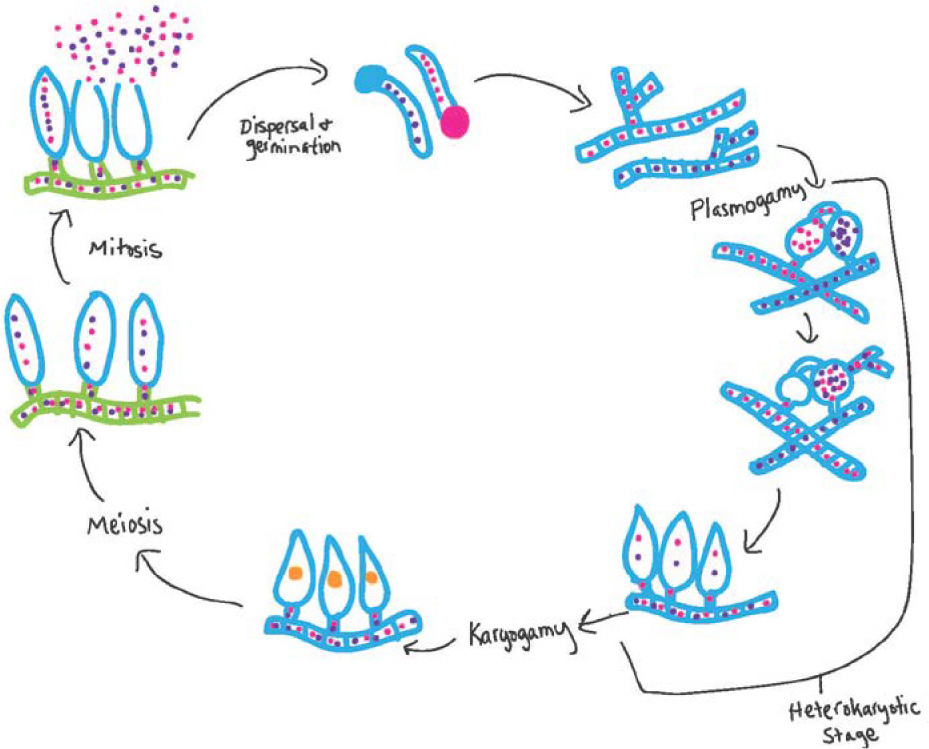
-
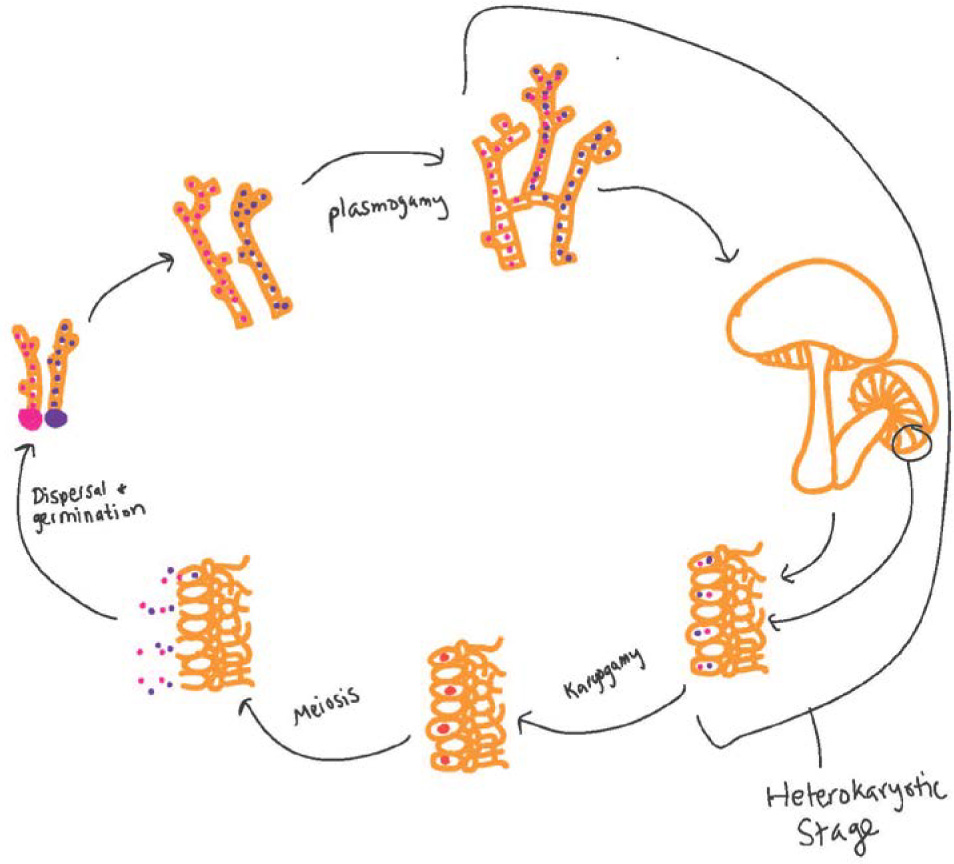
- Several key innovations in the evolutionary history of fungi allowed these organisms to move from water to land. The first was chitin;its flexible yet strong nature allowed the fungal cells to live in a non-aquatic environment. The second was hypha—these growths allowed fungi to explore the land environment in search of nutrients and water. Finally was the evolution of aerial spores and structures releasing them, which helped fungi disperse their spores successfully on land.
- Since a major group of fungi associate with different plants and animals, diversity in the plants have corresponded to increased diversity in the fungal species.
S-27
S-28
S-29
Chapter 35 Self-Assessment Answers
-
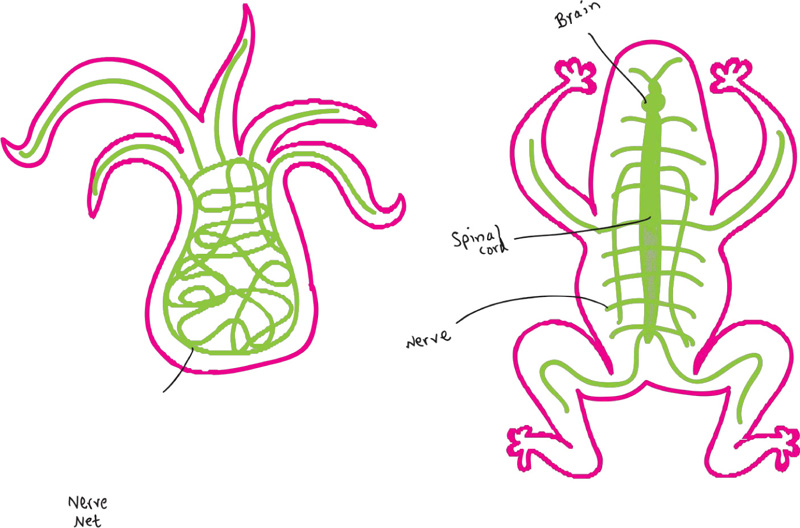
- Three basic categories of neurons are: (1) sensory neurons, which respond to physical features such as temperature, light, and touch or to chemical signals such as odor and taste; (2) interneurons, which process the information received by the sensory neurons and transmit it to different body regions; and (3) motor neurons, which are at the end of the pathway and produce a suitable response based on the information from the sensory and interneurons.
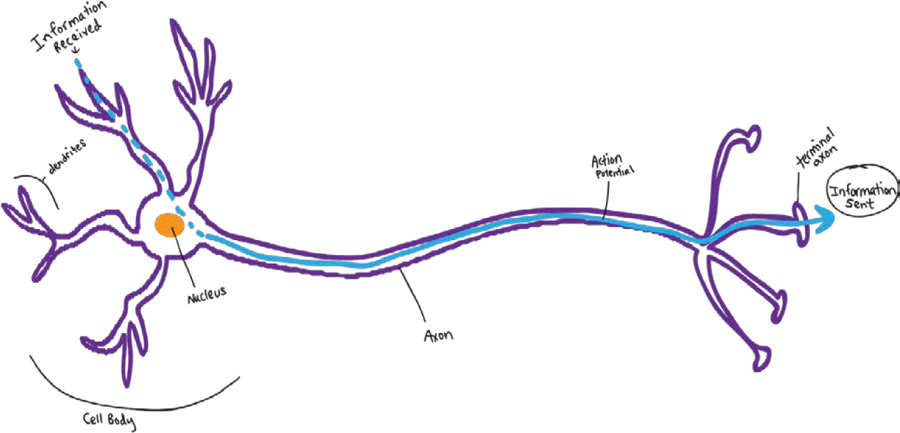
-

- An action potential is all or nothing because the magnitude of the action potential is always the same, regardless of the strength of the initial stimulating input.
- A neuron cannot fire a second action potential during the refractory period, when the inner membrane voltage falls below and then returns to resting potential. The action potential is propagated along the axon in only a single direction because the refractory period prevents the membrane from reaching its threshold too quicklyafter an action potential and firing an action potential in the reverse direction.
- The myelin sheath insulates the axon, spreading the charge from a local action potential over a much greater distance along the axon‘s length. The axon membrane is exposed at regular intervals at sites called nodes of Ranvier that lie between adjacent segments wrapped with myelin.The action potential jumps from node to node, greatly increasing the speed of transmission.
- See below

- Neurotransmitters binding to receptors on the postsynaptic membrane can elicit an excitatory response if they bind and depolarize the postsynaptic membrane. Neurotransmitters cause an inhibitory response if they bind to receptors and hyperpolarize the postsynaptic membrane.
- The voluntary, or somatic, component of the vertebrate nervous system controls the sensing and response to external stimuli, like sight or smell. The involuntary, or autonomic, component of the vertebrate nervous system controls many bodily functions like heartbeat and digestion.
-

S-30
S-31
S-32
S-33
Chapter 36 Self-Assessment Answers
- Chemoreceptor neurons respond to molecules that bind to specific protein receptors on the cell membrane of the sensory receptor. The interaction of molecules and chemoreceptors underlies the sense of smell and taste. An example is coral polyps responding to concentrations of simple amino acids in water to feed.
Mechanosensory neurons respond to physical deformations of their membrane that can be caused by touch, stretch, pressure, motion, and sound. Examples are the receptors in our skin that sense touch and pressure.
Electromagnetic sensory neurons respond to electrical, magnetic, and light stimuli. Examples are the photoreceptors that sense light in different organisms. -
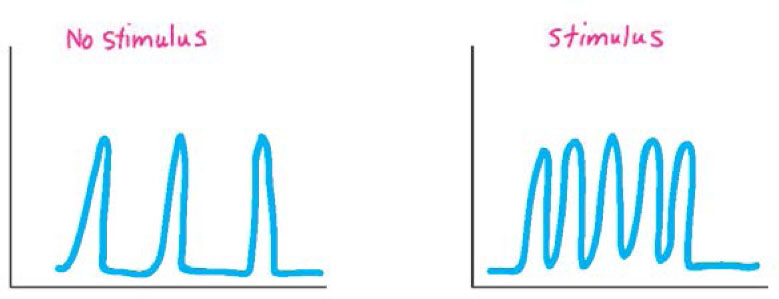
- All animals have chemoreceptors so they can sense food sources.
- The three main stages by which sound is detected and coded by the mammalian ear are: (1) Amplification: sound vibrations are amplified by the bones in the middle ear. The vibrations are then transmitted to the oval window of the cochlea in the inner ear. (2) Transfer of sound vibration to fluid pressure waves: vibrations of the oval window cause fluid pressure waves in both canals of the cochlea at the same time. (3) Mechanoreception by hair cells within the cochlea: fluid vibrations within the cochlear canals bend the stereocilia of the hair cells back and forth, stimulating them to release excitatory neurotransmitters. These cause postsynaptic neurons to fire action potentials that are sensed as sound by neuronal networks in the brain.
- Cone cells have color-sensitive pigments that allow the eye to detect color. Rod cells, which are differently shaped, sense light but not color. Rod cells can detect white, to shades of grey, to black. Because of their greater number and sensitivity to light, rod cells enable animals to see in low light. Cone cells predominate in the center of the retina while rod cells predominate the periphery.
- The cornea is the transparent part of the sclera in the front of the eye. Light passes through the cornea before reaching the lens. The cornea and lens bend incoming light rays, focusing them on the retina at the back of the eye to form images.
- Three different types of eyes in animals are eyecups, compound eyes, and single lens eyes. (1) Eyecupssense the direction and intensity of light but do not form images. Eyecups contain photoreceptors that point up and to the left or right. A pigmented epithelium layer is behind the photoreceptors so that eyecups only sense light from above and in front of the animal. (2) Compound eyes are made up of multiple light-focusing elements, each with a lens, called ommatidia. Ommatidia individually focus light onto a central region formed from multiple overlapping photoreceptors. Compound eyes provide a mosaic image and extremely good at detecting motion and flashes of light. (3) Single-lens eyes produce a sharply defined image of the animal‘s visual field. A single lens focuses light rays on a particular region of photoreceptors, improving image quality and light sensitivity.
-

- Neurons in the primary motor cortex produce complex coordinated behaviors by controlling skeletal muscle movements. The area of the body that is controlled by particular neurons can be mapped onto the cortex. Thus if an injury occurs in a specific area of the brain, you might be able to predict which areas of the body may be most affected.
- By correlating the area of the brain affected with the effects of the injuryy, you may be able to tell which functions or body areas that part of the brain controls. For example, if a person has an injury in a particular part of their brain and their sense of taste changes, there is a good probability that that area controls taste perception.
S-34
S-35
Chapter 37 Self-Assessment Answers
-
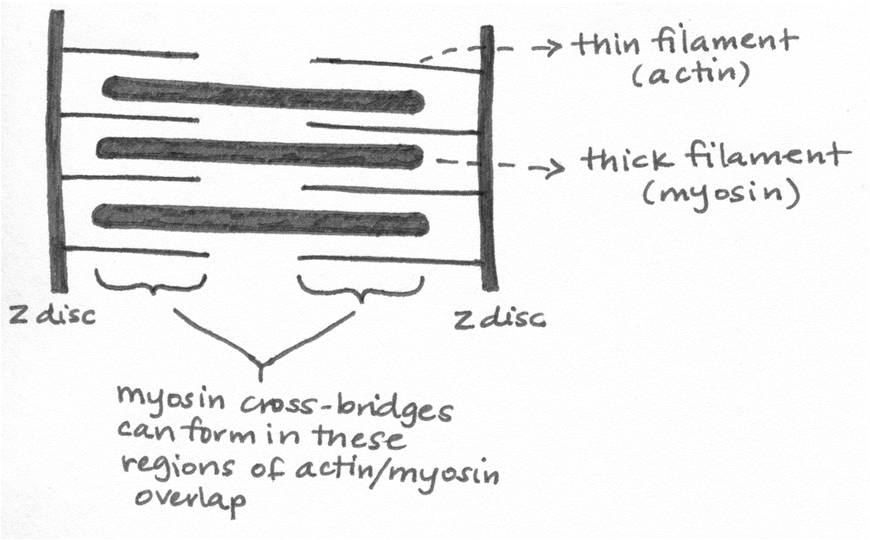
- Depolarization at the motor endplate of a muscle fiber is propagated from the cell surface to the sarcoplasmic reticulum (SR) via the T-tubule system. Depolarization of the SR causes release of Ca2+ ions from the SR into the cytoplasm. The Ca2+ ions bind to troponin and cause a conformational change in troponin that that causes tropomyosin to move. The movement of tropomyosin exposes the myosin binding sites on actin, allowing for the formation of myosin-actin cross-bridges and muscle contraction.
-
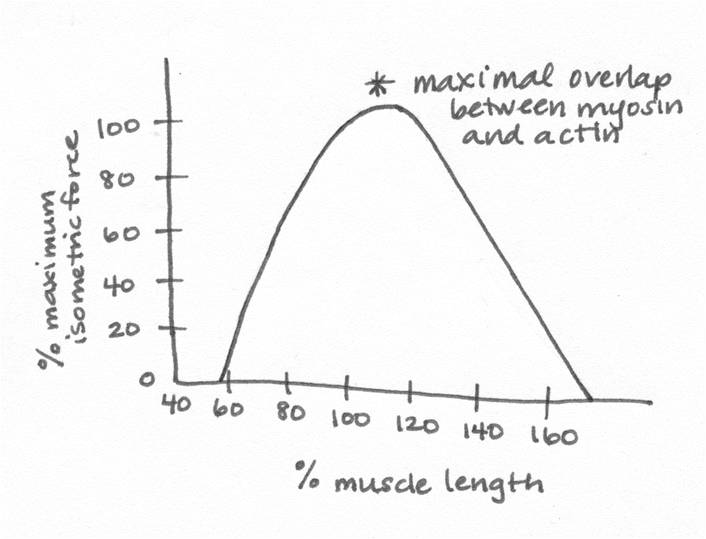
-
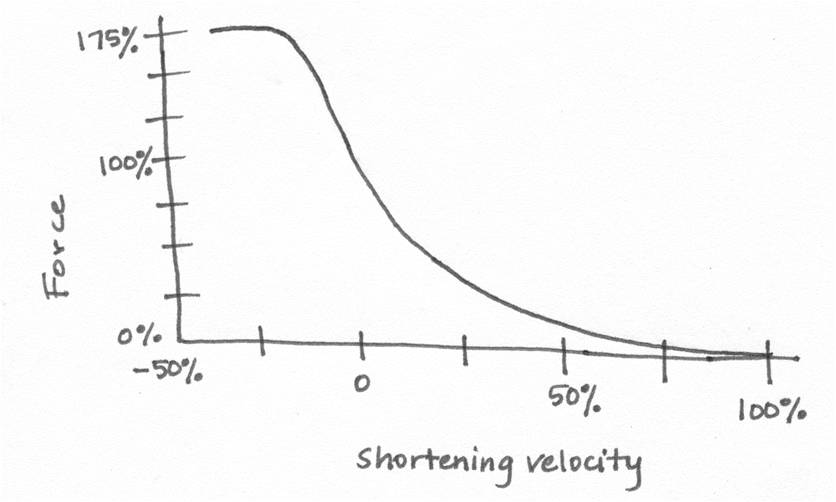
- A single twitch stimulus will result in a certain amount of force based on the number of muscle fibers in the motor unit. If the number of stimuli increase but the frequency is low, the muscle fully relaxes between stimuli. In this case, the force produced by each stimulus will be equal to that of a single twitch stimulus. When the frequency of the stimuli is increased further, so that the muscle does not have time to relax between stimuli, the forces produced by the individual stimuli are summed together to generate a greater force than a single twitch stimulus can produce. At a sufficiently high frequency, a sustained contraction of the muscle, known as tetanus, occurs.
- All animal skeletons consist of rigid elements (such as cartilage, bones or fluid-filled cavities) and groups of muscles that work as antagonists.
- While both endoskeletons and exoskeletons provide support and protection for an animal, exoskeletons cover the outside of an animal and provide external protection from harm, whereas endoskeletons are internal and provide protection to vital organs but not the animal‘s exterior. Both types of skeletons are made from composite materials, which makes them strong and flexible. However, endoskeletons, like those found in vertebrates, are first formed as cartilage and then mineralized to form hardened bone, whereas exoskeletons are formed by the deposition of mineralized proteins at the outer edge of the growing skeleton. Finally, damage to both types of skeletons can be repaired, but animalswith exoskeletons must form an entirely new skeleton, whereas animals with endoskeletons can repair specific regions of damaged bone through the work of osteoblasts.
- Bone tissue is composed of hydroxyapitite mineral and collagen protein. Hydroxyapitite makes the bone strong and rigid, and collagen protein allows the bone to absorb force and resist breaking.
-
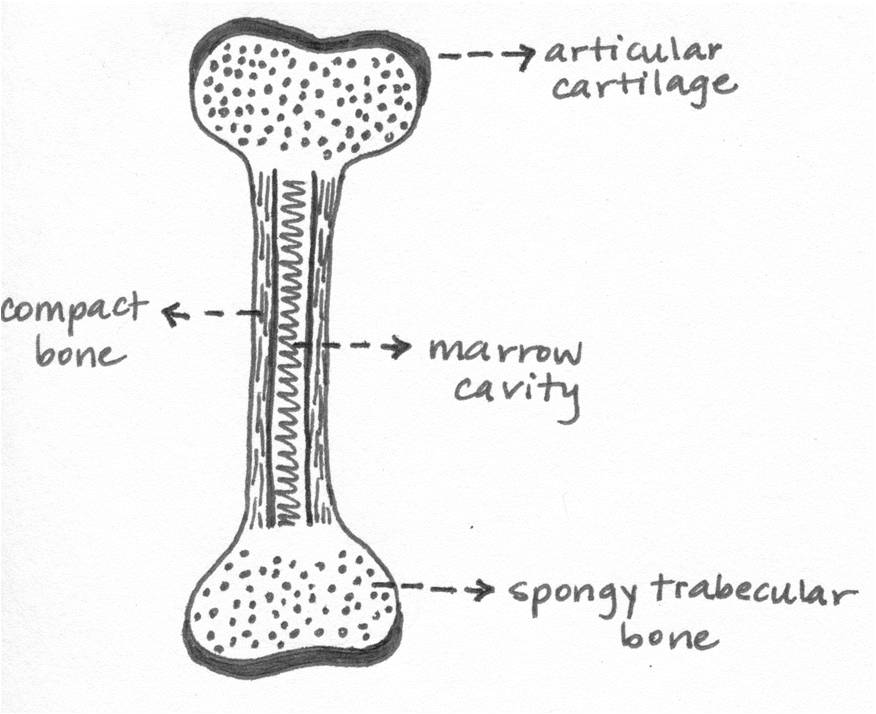
S-36
S-37
S-38
Chapter 38 Self-Assessment Answers
- The endocrine system works to (1) regulate growth and development (e.g., coordinating caterpillar molting and metamorphosis); (2) maintain homeostasis (e.g., balancing blood-glucose levels); and (3) allow for response to environmental changes (e.g., preparing an animal to flee at the sight of a predator).
-
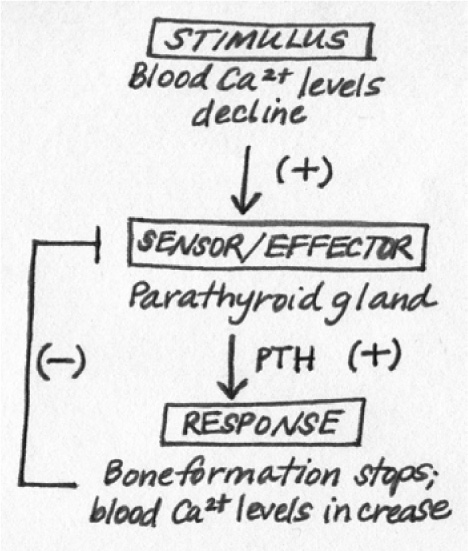
-
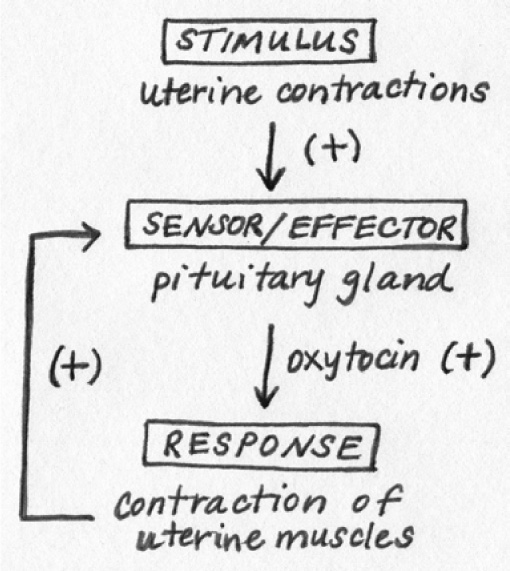
- Hormones can be amines (e.g., epinephrine), peptides (e.g., oxytocin), or steroids (e.g., cortisol). Hormones must bind to specific receptors in order to exert an effect on a cell, so only those cells or organs that express the specific receptor for a given hormone will respond to the hormone as it passes through the blood.
- The endocrine system can elicit broad and dramatic effects throughout the body because the initial hormone signal is amplified at several different steps along the pathway. If the initial hormone targets an endocrine gland, the gland will release an amount of its specific hormone that is larger than the amount of the initial hormone original released. When a hormone reaches a target cell, the signal is again amplified within the cell through signaling cascades in the signal transduction pathway. In signaling cascades, each individual molecule in the pathway may activate several or many downstream molecules. or modulation of transcription factors which can have broad and long-term effects on gene transcription, altering the behavior and metabolism of a cell.
- Peptide hormones are hydrophilic, so their receptors are located at the surface of the cell because these hormones cannot readily cross the plasma membrane. Once a peptide hormone binds to its receptor at the cell surface, intracellular second messenger pathways are activated. Ultimately these hormones affect the activity of one or more enzymes within the cell and leading to changes in gene expression, cell metabolism, or cell behavior on timescales of minutes to hours.
- Since steroid hormones are hydrophobic and can cross the plasma membrane, their receptors are located within the cell. Once a steroid hormone binds to its receptor, this activated complex can function as a transcription factor in the nucleus to alter gene expression. In this way, these hormones modulate the function, metabolism, or activity of the cell in a wide variety of ways over the span of days to months.
- The hypothalamus controls the posterior pituitary gland directly by way of neurosecretory cells. The cell bodies of these cells are located in the hypothalamus and their axons terminate in the posterior pituitary. Instead of releasing neurotransmitters, these axons release hormones straight into the blood. The anterior pituitary gland is controlled by hormones, known as releasing factors. The releasing factors are released by neurosecretory cells of the hypothalamus and travel via small blood vessels to the anterior pituitary. The releasing factors then stimulate the release of pituitary hormones into the bloodstream.
- Hormones can elicit broad and coordinated changes within specific organs or an entire organism because they can travel long distances throughout the body via the bloodstream. Paracrine signals are not transported in the blood; they act locally to modulate the behavior of neighboring cells. Neurotransmitters act over short distances to allow rapid communication between adjacent neurons. They also act between neurons and muscles to mediate motor outputs necessary for movement and body control. Pheromones are released into the environment; they can act at great distances to affect the behavior of other animals.
S-39
S-40
Chapter 39 Self-Assessment Answers
-
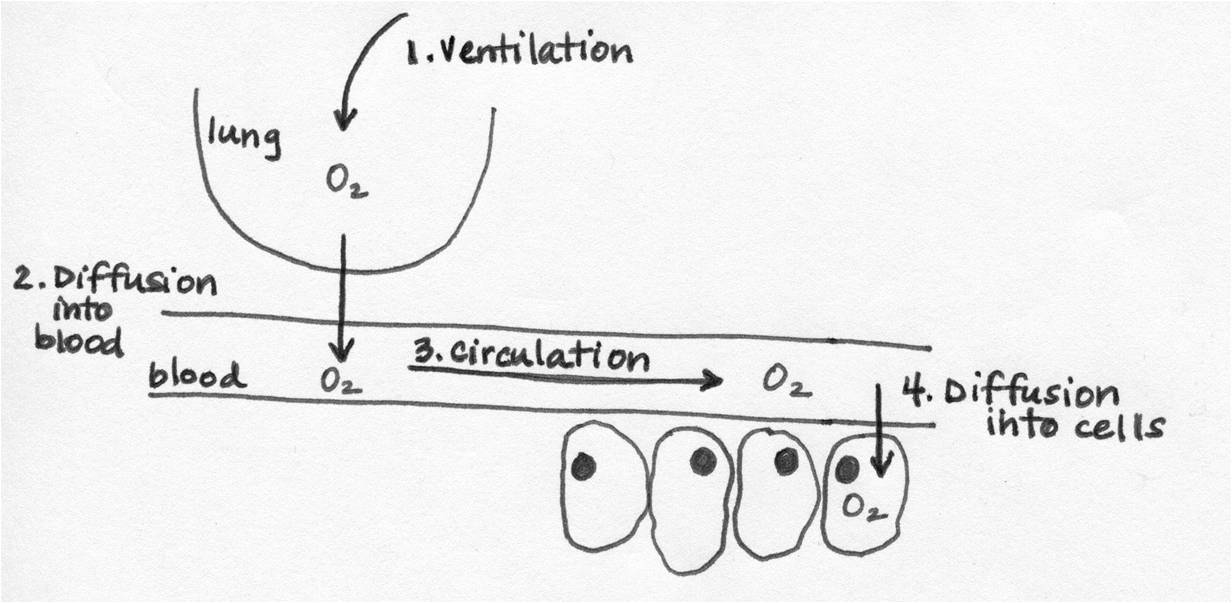
- Gills are composed of stacks of lamellae, each made up of a thin layer of flattened epithelial cells. The lamellae provide both a large surface area for gas exchange and a short distance for the diffusion of gases between the blood of the aquatic animal and the passing water.
- Aquatic animals must be very efficient at extracting oxygen from the water because the oxygen content in water is much lower than in air, and water is more viscous and dense than air, so more energy is required to move water by bulk flow during ventilation.
- The highly branched air tubes of the insect tracheal system deliver air directly to the cells. Oxygen diffuses from the air in the trachea directly into the body cells of the insect. There is no respiratory surface or circulatory system.
- Gill respiration maximizes the efficiency of gas exchange by utilizing unidirectional water flow. Because water flows in one direction, the supply of oxygen is continuous and uninterrupted. This efficient system allows gill-breathers to extract sufficient oxygen from water, even though its oxygen content is much lower than air, and to actively pump water over the gills. to allow for countercurrent exchange of gases between the water and the blood of the aquatic animal. In contrast, the bidirectional airflow of the lungs is less efficient because oxygen intake decreases during exhalations. Lung ventilation can depend on bidirectional airflow despite its suboptimal capacity for gas exchange because the oxygen content of air is higher than water and the energetic cost of moving air by bulk flow is lower than for water (since air is less dense that water). The ventilation rate can be increased to deliver more oxygen as necessary without an enormous energetic expense to the organism.
- During inhalation, the volume of the thoracic cavity is increased by contraction of the diaphragm. The increase in volume creates negative pressure inside the lungs that draws air into the lungs.. During exhalation, the volume of the thoracic cavityis decreased by relaxation of the diaphragm. The decrease in volume creates positive pressure, expelling air out of the lungs.
- Once hemoglobin binds one molecule of O2, its affinity for additional O2 molecules dramatically increases. The increase in binding affinity maximizes uptake of O2 in areas of high oxygen content and allows for rapid saturation of O2 binding sites in hemoglobin before the blood leaves the capillaries surrounding the alveoli of the lungs.
- Since resistance to blood flow is proportional to 1/r4 (where r is the radius of the blood vessel), as arteries branch into smaller vessels, the resistance to blood flow increases.The rise in resistance causes a proportional decrease in the rate of blood flow.
-
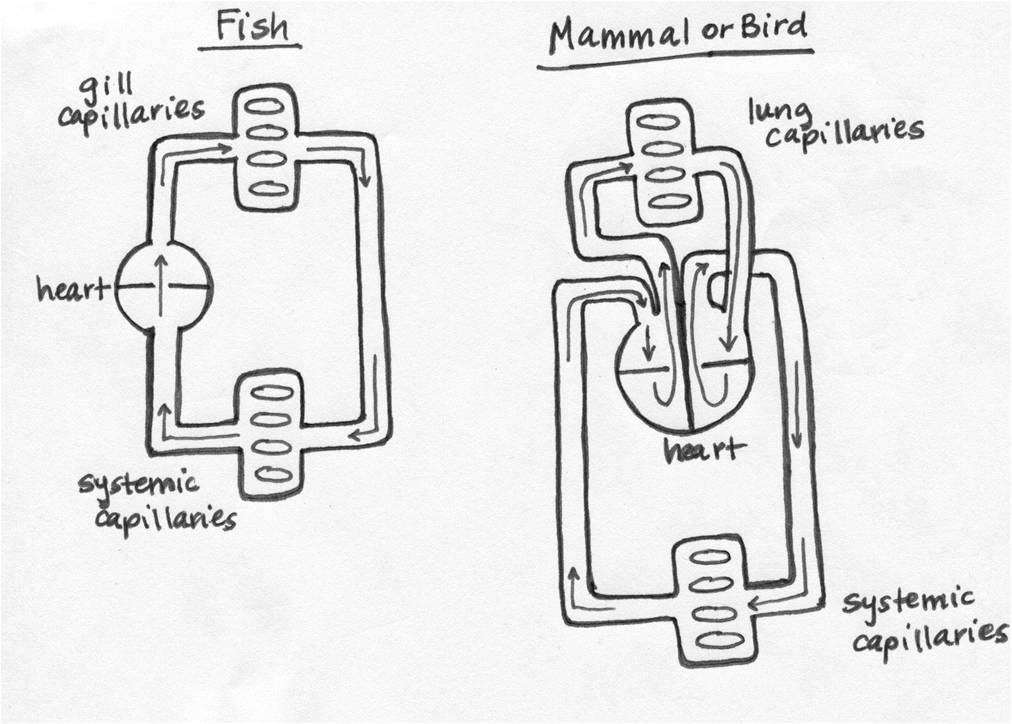
- Cardiac output can be adjusted by changing either how fast the heart pumps the blood (heart rate) or the amount of blood pumped through the heart in each cardiac cycle (stroke volume). Mammals, including humans, increase cardiac output mainly by increasing heart rate via signals from the nervous system, whereas fish typically increase stroke volume to increase cardiac output.
S-41
S-42
Chapter 40 Self-Assessment Answers
- DWhen an animal is at rest, its basal metabolic rate produces enough energy to maintain the animal‘s essential functions (circulation, respiration, etc). As activity level increases, metabolic rate also increases to meet the demand for additional energy. As the size of an animal increases, the energy requirement also increases so the metabolic rate for larger animals is greater than for smaller animals. Finally, those animals that regulate their body temperature by utilizing the heat produced from metabolism (endotherms) must have a higher metabolic rate than similarly sized animals that are ectotherms, which rely on external heat sources to balance their internal temperature.
- For short and rapid bursts of energy, animals use anaerobic glycolysis and fermentation to generate small amounts of ATP very quickly. For prolonged activities, oxygen is used to drive aerobic respiration to generate more ATP.
- The metabolic rate of an animal can be measured by determining its rate of oxygen consumption, which can be accomplished by placing the animal in an enclosed space where the amount of oxygen used by the animal can be monitored.
- As runners increase their speed, their body must rely more heavily on anaerobic metabolism to generate ATP quickly to meet the energy needs of their muscle cells. However, the lactic acid produced by fermentation builds up in the blood and leads to fatigue, so in order to increase the distance a runner can cover, they must slow down in order to minimize lactic acid buildup and reduce fatigue.
- Endotherms rely on the heat released during internal metabolic reactions to maintain thermal homeostasis. When the animal‘s temperature becomes too high, it releases excess heat to the environment (e.g., by sweating), whereas if the animal‘s temperature is too low, heat can be retained by constricting peripheral blood vessels, shivering or by increasing basal metabolic rate. Ectotherms, which use external heat sources in the environment to maintain their internal temperature, use behavioral changes to regulate their temperature, increasing or decreasing their exposure to the heat source (e.g., the sun) as necessary.
- If the food supply is inadequate, animals first utilize glycogen and fat reserves to generate energy. But after prolonged periods of undernourishment, protein stores (found mostly in muscles) will be metabolized as a last resort to meet the energy needs of the animal.
- Animals capture prey by suspension filter feeding (e.g., baleen whales); suction (e.g., aquatic salamanders); swimming to it (e.g., sharks); or, for carnivorous animals, using their sharp, specialized teeth to catch it (e.g., dogs).
-
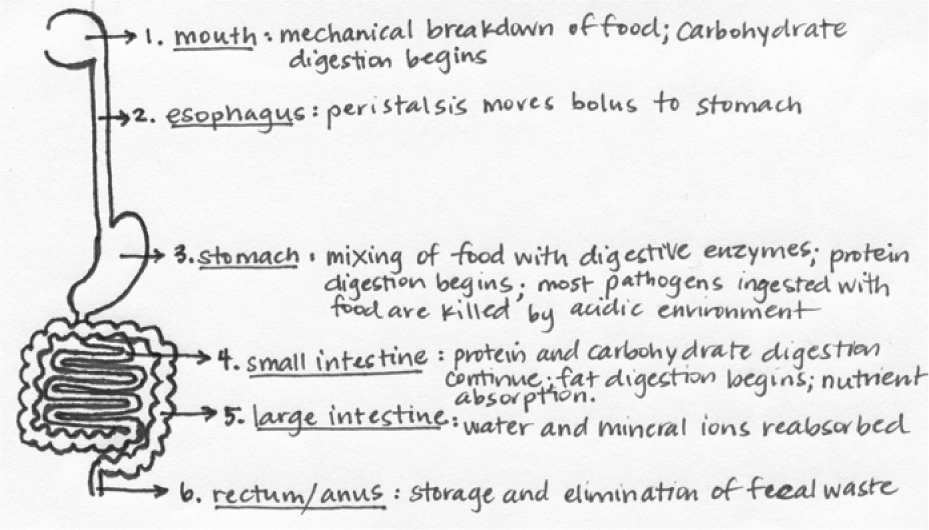
- Both foregut and hindgut fermenters utilize bacteria in their gut to help break down plant materials into nutrients that can be absorbed. Foregut fermenters maximize nutrient absorption by processing the plant material extensively within several chambers of the stomach (where the bacteria reside) before it reaches the small intestine. In contrast, hindgut fermenters pass the ingested material through the small intestine before it is fermented by the bacteria residing in the colon and cecum, reducing the ability of these animals to extract nutrients from plant material they ingest.
S-43
S-44
Chapter 41 Self-Assessment Answers
-
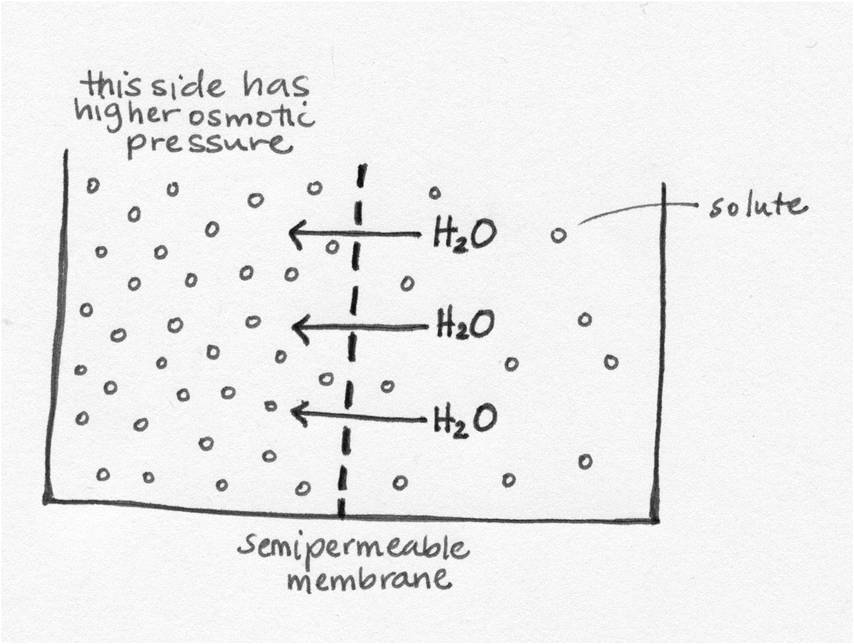
- Animals gain water and electrolytes through drinking and the foods they eat. Additionally, water is generated by cellular respiration. Water and electrolytes are lost through urine, feces, and evaporation. Specialized glands in some animals can also aid in removal of excess electrolytes.
- Animals that regulate their internal osmotic pressure by maintaining their internal solute concentration at a level similar to that of their environment are considered osmoconformers, which includes animals such as sharks and marine invertebrates like sea stars. Freshwater fish, like trout, and all terrestrial animals, including humans, are considered osmoregulators because they expend considerable energy to maintain an internal solute concentration that is different than that of their environment in order to regulate their internal osmotic pressure.
- Although ammonia is highly toxic, many fish can excrete waste in this form because it can be easily diluted in their aquatic environment; they don’t have to expend additional energy converting this waste into a less toxic form. Since terrestrial animals do not live in water, they must convert ammonia to a less toxic form, urea, which can be stored and excreted with water in the urine. For those animals that must conserve water, like those that live in hot, dry climates, the ammonia that is generated by the breakdown of proteins is converted into uric acid which is much less toxic and does not dissolve in water, so waste excretion can occur with limited water loss.
- Waste excretion happens through filtration, where solutes, waste, and water are removed from the blood; reabsorption, where water and necessary solutes are returned to the blood; and secretion, which allows excess solutes and toxins to be removed from the body in the filtrate.
-

- ADH affects urine concentration by altering the permeability of the collecting duct to water. In the presence of ADH, aquaporins are inserted into the membrane of the cells surrounding the collecting duct, increasing reabsorption of water and concentrating the urine. In the absence of ADH, the collecting duct is impermeable to water, so water remains in the filtrate and the urine is diluted.
- If blood pressure drops, cells within the juxtaglomerular apparatus release renin into the blood. This in turn leads to activation of angiotensin II, which causes blood vessels to constrict, increasing blood pressure due to the decreased diameter of the blood vessels. In addition, angiotensin II causes release of aldosterone, which triggers increased reabsorption of water and electrolytes in the distal convoluted tubule and collecting duct, leading to an increase in blood volume and blood pressure.
S-45
S-46
Chapter 42 Self-Assessment Answers
- Asexual and sexual reproduction are two ways that organisms can reproduce. They both provide a way for a parent to transmit genetic information into a new generation. In asexual reproduction, a single individual will bud or fragment, forming genetically identical clones. Whereas in sexual reproduction, two genetically different organisms will come together to form a genetically unique progeny. The process of mitosis happens in both forms of reproduction, whereas meiosis only happens with sexual reproduction.
- The roles of meiosis and fertilization in sexual reproduction are, respectively, halving the amount of chromosomes in the gamete and restoring the original chromosome content. Both provide genetic variation in the offspring.
- Asexual reproduction is rapid and eliminates the need for the organism to have a mate. However, asexual reproduction does not introduce genetic variability into the population like sexual reproduction and therefore may have dire evolutionary consequences.
- There are few, if any, ancient asexual organisms because a certain amount of genetic variability is favored. For a population to adapt, there must be a higher rate of genetic variability than just random mutation alone. Sexual reproduction gives these populations the level of genetic diversity they need in order to be evolutionarily fit.
- Internal fertilization; oviparity, in particular the development of the amnion; and viviparity are all adaptations that allow reproduction to take place on land.
- Sperm are produced in the testes, then travel through the epididymis, vas deferens, ejaculatory duct, and finally the urethra.
- Oocytes are produced in the ovaries and then travel through the fallopian tubes to the uterus.
- The anterior pituitary secretes a surge of LH and FSH, which cause ovulation. Follicle cells secrete estradiol, which causes the uterine lining to thicken, and the corpus luteum secretes progesterone, which helps maintain the thickened uterine lining. If the oocyte is fertilized, it implants into the uterine lining and secretes hCG, which maintains the corpus luteum. Eventually, the placenta takes over the estrogen and progesterone production to maintain the uterine lining and stimulate the growth of the uterus. If the oocyte is not fertilized, the corpus luteum degenerates, estrogen and progesterone levels drop, and the uterine lining is shed.
- Male and female gametogenesis are similar in that a primordial germ cell undergoes several rounds of mitosis to form a primary spermatocyte or oocyte. Then, in sperm development, the primary spermatocyte undergoes two rounds of meiosis to form four haploid sperm cells. In contrast, the primary oocyte undergoes two rounds of meiosis but only to produce one viable ovum. The other three cells are called polar bodies and are arrested in the meiosis II phase.
- Three key developmental steps in the development of a single-celled zygote to a multicellular individual are cleavage, gastrulation, and organogenesis. Cleavage is where the single-celled zygote divides by mitosis. This divides the single large egg into many smaller cells. Gastrulation is a highly coordinated set of cell movements that leads to a fundamental reorganization of the embryo into three germ layers. Organogenesis is the transformation of the three germ layers into all the organ systems of the body.
S-47
S-48
Chapter 43 Self-Assessment Answers
- Both the innate and adaptive immune systems can target a variety of pathogens while also distinguishing self from non-self. All organisms have an innate immune system, which provides a broad and non-specific defense against pathogens. Adaptive immune systems are only found in vertebrates, allowing these organisms to have immunological memory of previous exposures to pathogens and the ability to mount a specific response to pathogens.
- The innate immune system is composed of physical barriers (e.g., skin, mucous membranes); chemical barriers (e.g., low pH of the stomach, enzymes); mutualistic microorganisms that compete with pathogenic organisms for resources; and leukocytes (e.g., phagocytes).
- Leukocytes identify non-self invaders using cell-surface receptors, known as toll-like receptors. These receptors recognize conserved surface markers present on a variety of pathogens but not on host cells.
- Leukocytes present at the site of an infection release chemical messengers that cause blood vessels to dilate, increasing blood flow to the area and leading to the redness (rubor) and warmth (calor) that are characteristic of inflammation. These chemicals can also increase the permeability of blood vessels. As a result, cells and fluid to leak out into the interstitial space, causing swelling of the tissue (tumor). The chemical messengers can also target nerve cells in the infected area, causing pain (dolor).
-
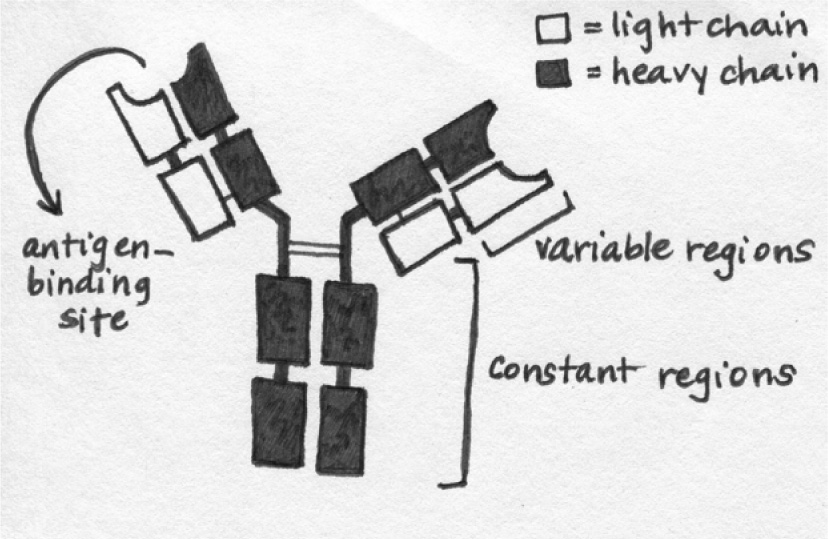
- The heavy and light chains of an antibody are encoded by multiple gene segments, and each segment is present in multiple copies within the genome. As a B cell differentiates, genomic rearrangements occur such that only one copy of each segment is used to produce the resulting antibody. These rearrangements occur independently in each B cell, so each B cell produces a unique antibody that can recognize a specific antigen.
- After the first exposure to a given pathogen, clonal selection of B cells with antibodies that recognize antigens on that pathogen leads to the production of memory B cells that are specific for that particular pathogen. These memory B cells secrete pathogen-specific antibodies on re-exposure to the same antigen. They are long-lived and respond more quickly to a pathogen than naïve B cells. Moreover, the pool of memory B cells is larger than the pool of naïve B cells for the same antigen. For these reasons, the response to subsequent exposures to the same pathogen is faster, stronger, and more sustained.
- Both B cells and T cells are activated by the binding of an antigen to their cell-surface receptors (antibodies or T-cell receptors, respectively). Both B cells and cytotoxic T cells are activated by cytokines released from helper T cells. B cells can recognize free or pathogen-bound antigens, while T cells require the antigen to be presented in association with major histocompatability complex proteins expressed on the surface of host cells.
- T cells that express T-cell receptors that efficiently recognize host MHC proteins undergo positive selection during maturation in the thymus. These selected cells continue the maturation process, whereas those that do not recognize MHC proteins are destroyed. In addition, T cells with receptors that react with self antigens presented by MHC proteins are eliminated by negative selection during maturation. As a result, the resulting T-cell population will only effectively recognize non-self antigens presented by MHC proteins. If tolerance to self antigens is lost, autoimmune diseases can arise as the immune system attacks and destroys the host’s own body cells.
- Pathogens that have the ability to change their surface antigens over time can evade the immune system because the antibodies and memory cells generated after the first encounter do not recognize the new antigens presented by the pathogen. Some pathogens are able to change their surface antigens through antigenic drift or antigenic shift, where changes in the genes encoding these antigens leads to their variation. Other pathogens have multiple, slightly different copies of a particular antigenic protein and can change which one is expressed. In this way, they can alter the antigens presented to the immune system. Pathogens that grow slowly within a host cell can also escape the immune response because they are shielded by the host cell from the circulating immune cells. Moreover, these pathogens do not produce many antigens for presentation by the MHC proteins because they replicate slowly.
S-49
S-50
Chapter 44 Self-Assessment Answers
-
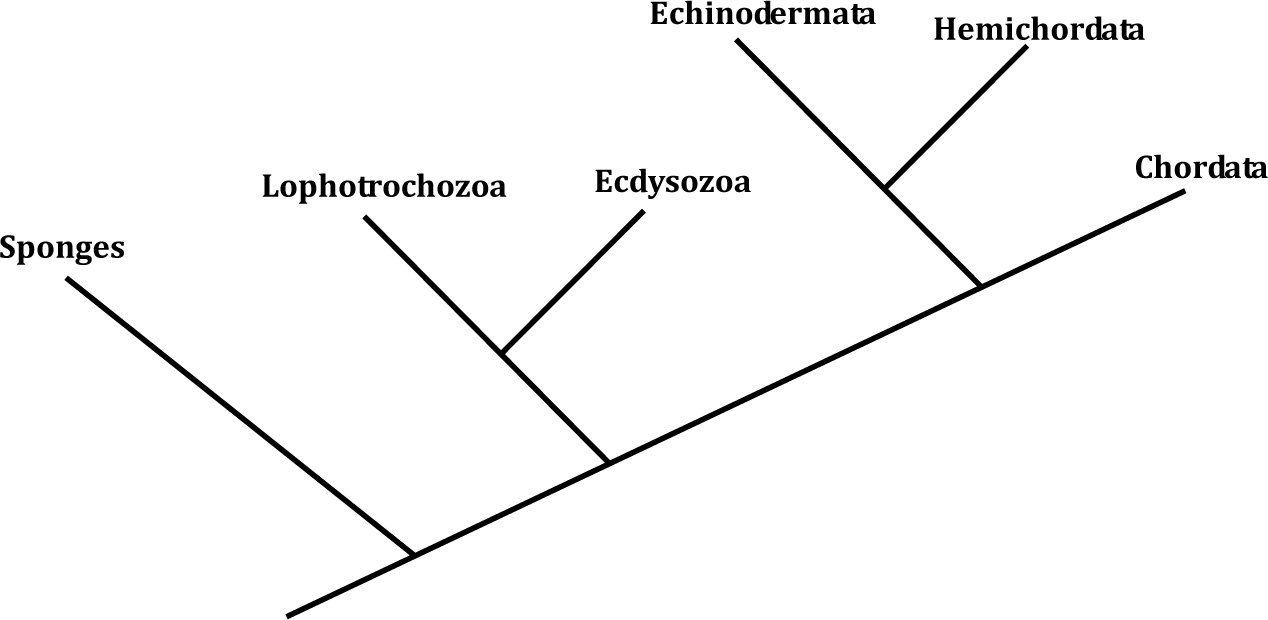
- Several criteria can be used to classify animals, including morphological characteristics and molecular sequences. Symmetry (radial vs. bilaterial) and blastopore fate (deuterostomes vs. protostomes) are two traits used to classify animals at a large scale. More specific phyla are often characterized by distinct traits. For example, these include: (1) the appearance of a mantle in mollusks; (2) jointed legs and a chitin skeleton for arthropods; and (3) a cranium and jointed skeleton in vertebrates. Comparisons of molecular sequences for specific proteins can help to solidify relationships between organisms, and facilitate groupings into phyla.
- In a sense, sponges, cnidarians, ctenophores (comb-jellies), and placozoans are all composed of three different layers of tissue or fluid with a specific organization. However, the organization of these layers and the associated feeding behaviors of these four organisms differ greatly.
Placozoans are formed by two layers of tissue separated by a third layer of fluid. These animals do not possess a distinct cavity (or mouth) into which food or water is drawn. Rather, these animals envelop a food source and feed by endocytosis performed by individual cells.
Sponges are also made up of three distinct layers: a porous outer layer of tissue, followed by a layer of mesohyl, and finally by an innermost layer composed of (in part) choanocytes. Unlike placozoans, sponges do possess a central cavity into which food-rich water is funneled. The cells within this central cavity, rather than secreting digestive enzyme into this environment, internalize food particles via endocytosis.
Cnidarians are similarly composed of three different layers: an outer epidermis, a middle mesoglea layer, and an innermost endoderm that lines a distinct gastric cavity. Unlike sponges and/or placozoans, cnidarians demonstrate radial symmetry and possess a distinctive mouth into which food is drawn by tentacles. Interestingly, the cnidarian mouth acts as both the entryway for food and exit for waste. Once through the mouth, food enters the gastric cavity and is digested by enzymes.
Comb-jellies or ctenophores, similar to cnidarians, possess an epithelium, a "gelatinous" middle layer, and an internalized endoderm. These animals are also radially symmetric. However, in contrast to cnidarians, comb-jellies possess both a mouth and anal pore; waste doesn‘t exit from the same hole that food enters. - Many feeding methods don‘t require a distinct head or mouth, and instead make use of endocytosis. Sponges don‘t possess definitive heads, but funnel food-rich water into a centralized cavity. Cells within this cavity subsequently take up food particles via endocytosis. Placozoans also do not possess heads. To feed, these organisms envelop a food source and release digestive enzymes. Through endocytosis, single placozoan cells will then take up digested material.
- Insects possess several unique traits, many of which are shared with other arthropods. These include jointed legs, a chitin exoskeleton, and eggs that can resist desiccation. Additional characteristics of some insects include the process of metamorphosis and the development of wings. Collectively, these traits have allowed insects to colonize various environments, and have made them remarkably successful organisms.
-

- Amphibians, amniotes and mammals all fall under the broader category of vertebrates. Being vertebrates, all of these organisms demonstrate a jointed and mineralized skeleton, a cranium-encased brain, and a vertebral column. Animals classified as amniotes, amphibians, and mammals demonstrate additional characteristics unique to the phyla. For example, amniotes—much like insects—are characterized by desiccation-resistant eggs. Mammals are classified by the appearance of mammary glands and hair, whereas amphibians demonstrate a gill-based larval stage and lung-focused adult stage.
- The Cambrian Explosion holds great evolutionary significance, as it brought with it the development of a diverse array of novel animal body plans (e.g., the combination of new characters in a single animal) reminiscent of those seen in modern-day organisms. In earlier Ediacaran fossils, such familiar characteristics are not observed.
S-51
S-52
S-53
Chapter 45 Self-Assessment Answers
- Recall the example of Aquaspirillum bacteria being attracted to a magnetic pole. What causes (or what is the mechanism that drives) this movement of Aquaspirillum toward a magnetic pole (does it have to do with iron oxide within the bacteria themselves)? Has this bacterial behavior developed as a result of specific genetic or environmental factors (i.e., to what extent is this an innate or learned behavior)? Why would moving toward a magnetic pole convey greater reproductive success to a bacterium? Did this behavior of moving toward a magnetic pole evolve from random bacterial movements, or from some earlier behavioral trait?
- An innate behavior is one that an organism performs instinctively. For example, when a first-time mother cat gives birth, she instinctively licks her kittens to stimulate breathing. Conversely, a learned behavior is not instinctive, but is shaped by an organism‘s experiences over time. An organism learns that a certain behavior can have a positive or negative result; such a behavior is not necessarily "taught" by other members of the species. In keeping with our cat example, a learned behavior could be a cat running to its owner if he or she shakes a bag of treats. The cat learns that the sound of a bag shaking has a positive outcome—a snack.
- Molecular biology techniques (especially assessing where a gene is expressed in an organism) and breeding techniques can both be used to determine whether a behavior stems primarily from genetics or environment. The example of ADH receptor distribution in prairie and montane voles utilized molecular techniques to determine how genes are involved in vole mating choices. Where ADH receptors are expressed determines whether or not these voles will be monogamous or promiscuous. Similarly, breeding techniques can help determine whether a gene is involved in a certain behavior. Recall William Dilger‘s experiment of mating two types of lovebirds with different nest-building techniques. These crosses produced lovebirds with an intermediate behavior phenotype, indicating that nest-building is influenced by genes.
- Habituation and sensitization are both types of non-associative learning. An example of habituation would be squirrels on a college campus. Normally, if you came across a squirrel in the forest, it would flee as you approached. However, campus squirrels are accustomed to people walking past them in close proximity. These squirrels have become "habituated" to high people traffic, and will no longer flee as people approach. Sensitization, on the other hand, is when one stimulus alters an organism‘s response to a second stimulus. Recall the example of Aplysia being sensitized to siphon stimulation following an electric shock.
- With associative learning, an organism learns that a particular behavior will result in a specific outcome (whether positive or negative). If you own fish, have you ever noticed that when you go to feed your fish they swim up to the top of the tank when the tank lid is lifted? This is an example of associative learning. The fish associate the opening of the tank lid with food, and swimming to the water‘s surface results in more food (and quicker access to it). Dog trainers also rely on associative learning. For example, a trainer will reward a dog with a treat or affection when it performs a desired behavior (like sitting or shaking hands). The dog associates a behavior with a reward, and will eventually perform that behavior on command. Specific variations on associative learning include classical and operant conditioning.
- Depending on the stimulus, organisms can undertake different types of movements. An organism can either move toward or away from a stimulus in a directed manner (remember the example of bacteria moving directly toward a magnetic pole). A taxis denotes this kind of directed movement. In contrast, stimuli can also induce undirected movements or kineses, where an organism moves toward or away from a stimulus in a random pattern (remember the example of bacteria making undirected turns to escape high-salinity conditions).
- The term "communication" suggests that two individuals are consciously exchanging information. Recall the example of a vervet monkey serving as a lookout for its family group. When a predator approaches, this lookout (the sender of information) sounds an alarm to the rest of its family (the receivers of information). This is a conscious exchange of information, where the vervet monkey wants its family members to hear the alarm and respond by taking cover or fleeing. However, many exchanges of information in biology aren‘t always conscious or intentional; sometimes a sender doesn‘t want to communicate a certain piece of information to a receiver, but does so inadvertently. Consider a hunter tracking a deer. The deer leaves tracks in a forest, which signals to the hunter that a deer has passed through the area. Conversely, in certain instances a deer can detect a hunter by his smell. In neither case does the deer or hunter want to provide information about their location to the other party, but they do so unintentionally. This unintentional exchange of information is why many biologists prefer not to use the term communication.
- An altruistic behavior is one of "self-sacrifice"; an organism will perform tasks to help the survival of another member of the species, not necessarily a member of its immediate family. Kin selection may contribute to the evolution and selection of altruistic behaviors. In kin selection, an individual will help assure the survival of genetically similar individuals (either in a hive, a family group, etc.). In helping related individuals survive and reproduce, an individual can assure that more of its genetic material can be passed on to future generations, even without reproducing itself. These genetically similar individuals will also likely carry genes that convey altruistic behaviors, reinforcing this behavior.
- Intersexual selection depends on the interaction between members of different sexes. Females pick a male based on certain characteristics, and these traits are selected for in a population because males with these characteristics have greater reproductive success. A prime example of intersexual selection is the intricate plumage of male birds of paradise, which is used to court females directly.
Conversely, intrasexual selection depends of the interactions between members of the same gender in a species. Here, traits are selected for by males (or females) competing with one another for mates. Antlers on bucks, for example, are the result of intrasexual selection; antlers of a certain size and shape make bucks more successful during altercations, conferring greater reproductive success. Thus, this trait is selected for not by direct interactions between bucks and does, but by interactions between male deer.
S-54
S-55
Chapter 46 Self-Assessment Answers
- A species’ population size is effectively determined by how many individuals enter into and exit a given region. Thus, population size depends on birth rates and immigration rates (individuals "entering" into a region), in addition to death rates and emigration rates (individuals "exiting" a region).
- The exponential growth curve represents a population with a constant per capita growth rate. At this stage, the environment can still support a growing number of individuals of one species. Neither the scarcity of resources nor overcrowding has limited the population size. Thus, the curve keeps extending upward on the right side of the graph. The straight line on the left side of the graph (representing a slight incline) has to do with a population having relatively few individuals to start. A handful of individuals can only produce so many offspring at once. However, if these individuals continue to reproduce, and so do their progeny (and so on), population size can rapidly increase.
The logistic growth curve also contains a period of exponential growth; however, the curve levels off in a horizontal line on the right side of the graph. This population size (where the graph levels offs) represents the carrying capacity of a given environment. At this point, the environment does not have enough resources to support any more members of a species. As a result, more individuals in a population die and the birth and death rates equilibrate, leading to a (relatively) constant population size over time.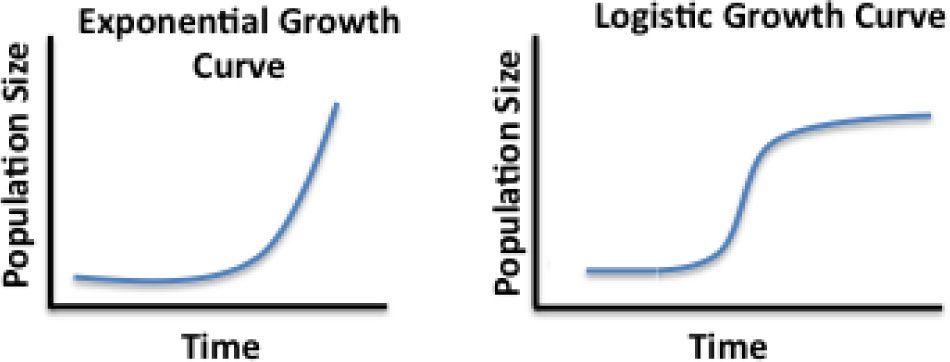
- Density-dependent factors that affect a species’ population size include inter- and intraspecific competition for resources and space. For example, as resources are exhausted and competition intensifies, a population‘s birth rate decreases but the death rate increases. However, competition isn‘t the only density-dependent factor that influences population size. As a population grows and its density increases, diseases can also spread (increasing the death rate).
Density-independent factors that affect population size include natural disasters (e.g., floods, droughts, hurricanes) and/or unexpected changes in temperature. Such occurrences can severely decrease the size of a population, regardless of how many individuals inhabit a given area. -
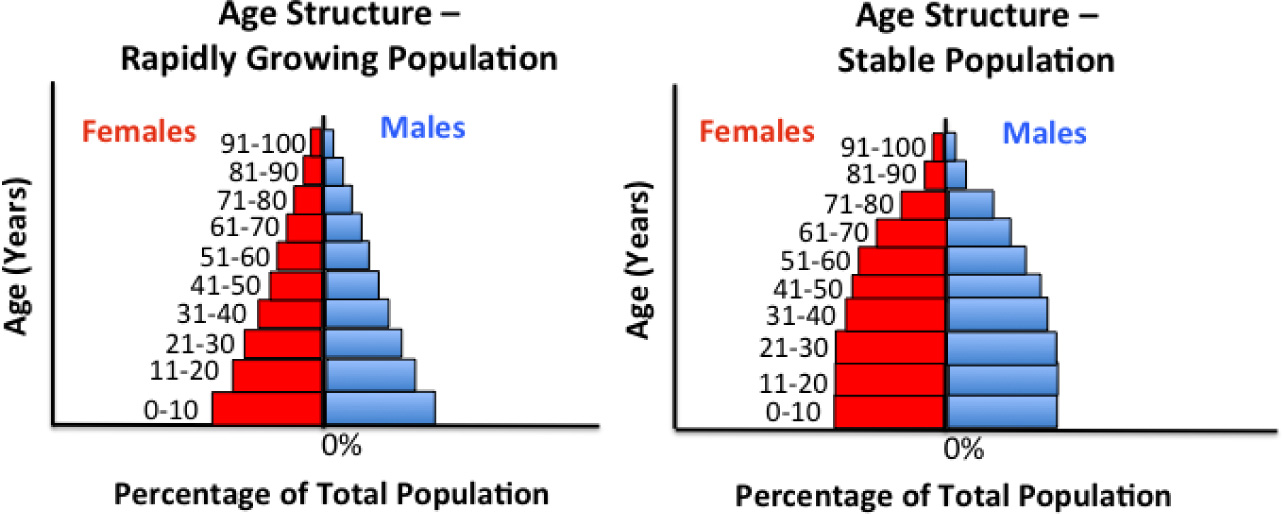
-
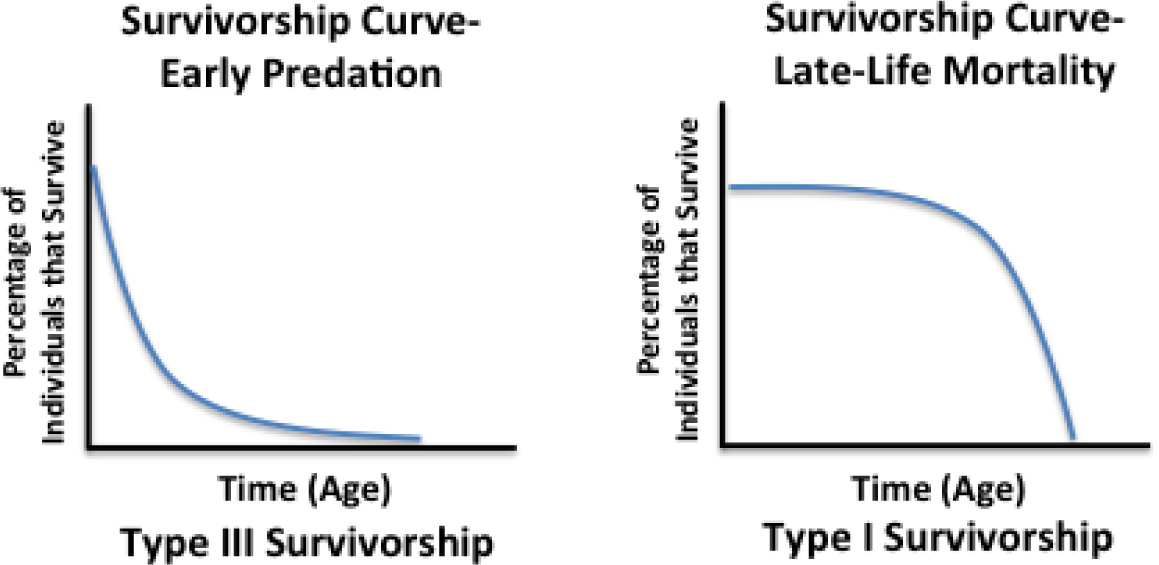
- K- and r-strategists differ fundamentally in the number of offspring they produce, and in the amount of resources and energy they dedicate to their progeny. r-strategists produce several offspring, but do not invest much energy in the long-term raising or protection of their young. This is a particularly effective strategy for a species that inhabits an area where resources are limited, or for a species that has multiple predators. Thus, r-strategists tend to inhabit "unpredictable" environments, assuring that some of their progeny will survive due to the sheer number they produce.
Conversely, K-strategists devote a large degree of energy and resources into raising their young, with the trade-off of only producing a few offspring at a time. This strategy is employed by species living in "predictable" environments, where resources are more readily available and predators are limited. - A physiological trade-off is when an organism contributes more resources and/or energy to one particular function over another (i.e., in plants, producing more seeds while sacrificing defensive structures such as thorns).
- A "habitat island" is a region that can support a given species, but is surrounded by environments that cannot support the same species. Thus, much like islands in the ocean, habitat islands are isolated areas. For example, a lake would be considered a habitat island for trout, as these fish could not survive in the forest surrounding the lake. Other examples of habitat islands include actual islands in the ocean (i.e., ants on an island can‘t live in the surrounding ocean) or a valley surrounded by mountains (i.e., grasses able to inhabit the valley would not be able to survive at higher mountain elevations).
- The species diversity of a habitat island depends on the colonization and extinction rates of organisms inhabiting (or attempting to inhabit) this area. Initial colonization rates depend both on the size of a habitat island (more area means the potential to support a greater number of species) and its proximity to other habitat islands (from which organisms can migrate). In turn, extinction rates depend on the types of species colonizing a habitat island and their interactions with one another.
Many of the factors that influence species diversity on a habitat island can also be taken into consideration during conservation efforts for an endangered species. Imagine that a conservationist wants to introduce members of an endangered species into a new environment. She must evaluate what other organisms have colonized this environment, and the extent of human activity in this area. She must also determine if the size of this potential habitat is large enough to support the introduction of a new species. If few resources are available and/or the species will be heavily hunted (either by humans or other predators), this will likely result in the deaths of any endangered animals introduced into this environment. Furthermore, the conservationist has to assure that she introduces enough animals into the environment so that they will be able to find one another and mate (i.e., individuals must be in close proximity to one another). If steps are taken to assure that the above conditions are met, there is a good chance that members of this endangered species can take root and survive in this new habitat.
S-56
S-57
S-58
Chapter 47 Self-Assessment Answers
- The niche of an oak tree depends of several pieces of information, including: what type of climate/environment/resources can support an oak tree; what other types of vegetation are found alongside oak trees (and how these different plant species interact); and what organisms either feed on oak tree products, or require oak trees for shelter. An oak tree is found in a deciduous forest, which contains nutrient-rich soil and experiences a moderate climate and defined seasons. These trees provide shade, which creates an appropriate environment for underlying vegetation (i.e., ferns, shrubs). Oak trees also provide nesting spots for a variety of birds and mammals, and provide food for a variety of insects (which feed on oak leaves) and vertebrates (i.e., squirrels eat acorns).
- A mutualistic relationship is one in which both species involved benefit in some way. The relationship between aphids and the bacteria that colonize them is an example of mutualism. Here, the bacteria benefit because they are provided with a safe environment within the aphids, and aphids benefit because their nutrient-poor diet is supplemented with products from the bacteria. Conversely, any predator-prey interaction is an example of antagonism. For example, take the relationship between seals and killer whales. Here, a killer whale benefits by gaining energy from the seals it eats (energy which is used for reproduction or other necessary life activities). Conversely, a seal that is consumed is certainly negatively affected. Once killed, the seal no longer has the opportunity to mate and reproduce, and cannot continue to spread its genetic information to the next generation.
- A community encompasses all of the species within a given habitat. The composition of a given community can be shaped by: 1) inter- and intraspecific competition; 2) the frequency of disturbances (like fires) occurring within an environment; and 3) seasonal changes which result in different weather patterns, as well as species’ migration.
- When a disturbance occurs in a given environment, it can drastically alter the composition of that area‘s community. A drought can seriously reduce the population size of species not equipped to deal with the scarcity of water. This may have a similar effect as when a wildfire clears a portion of a forest. Such a change allows for new species (adapted for dry conditions) to enter and colonize an area, leading to the process of ecological succession. If droughts are common in a specific region, these disturbances can select for organisms that can tolerate a lack of water and dry conditions. This, in turn, can limit the species diversity in a given community.
- Ecological succession describes the temporal colonization of a new habitat by different species. Each species changes that habitat, making conditions favorable for a new species to move in. A prime example of ecological succession is what occurs after a new island is formed by volcanic activity. Initial colonization by lichen (and associated invertebrates) leads to soil formation and subsequent colonization by grasses and shrubs, which eventually make way for larger trees.
- Herbivores occupy the trophic level between primary producers (i.e., plants) and predators. If there is an ample supply of vegetation, herbivores consume this plant material and reproduce. This increase in herbivore numbers provides food for predators at higher trophic levels, and results in an increase in the predator population. If herbivores exhaust the resources provided by primary producers, their numbers decrease, resulting in less food for predators and a smaller predator population. In this manner, changes in an herbivore population can influence predator and primary producer populations at different trophic levels.
- Biomes include: 1) rainforests—characterized by copious amounts of rain, warm temperatures, and a diverse array of plant and animal life; 2) deserts—regions with limited precipitation, a high rate of evaporation (in some cases), and vegetation that is equipped for the long-term storage of water (i.e., cacti); 3) taiga—forests that experience a brief summer season, occur in cold climates, and are characterized by a large proportion of conifers and shrubbery; 4) deciduous forests—which experience a range of seasons and moderate rainfall, and support several different tree species; and 5) the savannah— which experiences definitive wet and dry seasons and is primarily inhabited by tall grasses.
Interestingly, the vegetation that exists in these five different biomes is constrained, in part, by evaporation and transpiration rates (which are dependent on factors such as temperature and annual precipitation). Consider the Sahara Desert in Africa. The high temperature of this desert, paired with the limited amount of rainfall, means that most water in the Sahara will evaporate pretty quickly. Any plants in the Sahara should be able to survive in an environment where water is scarce, and must maintain low transpiration rates (thus conserving precious water). These conditions limit which plants can inhabit the Sahara Desert. In other terms, since the Sahara Desert has a high evapotranspiration ratio (the comparison of the rate of evaporation to the rate of transpiration), only certain types of vegetation can survive in this environment. - Generally, greater species diversity is observed at latitudes close to the equator. This is particularly evident if we compare the species observed in rainforests (latitudes of 0-10°) to those seen in tundras (latitudes at 65° or higher) or at the northern/southern poles. Rainforests demonstrate a huge array of life, with hundreds of species of trees, insects, and other animals observed in a small area. Conversely, the tundra can only support a limited number of plants capable of surviving in a few inches of topsoil (i.e., shrubs).
Two theories can explain this difference in species diversity observed near the equator versus higher latitudes. At higher latitudes, plants and animals must survive changes in temperatures (sometimes extreme) and seasons. Few species can survive in these climates, effectively limiting species diversity. In addition, higher latitudes are relatively "new" habitats compared to those observed at the equator. The covering of northern latitudes by glaciers during the ice ages, and the subsequent recession of these glaciers, has only recently opened up these environments to colonization by new species. Regions near the equator, however, have experienced the same environmental conditions for longer periods, allowing for more species to evolve and thrive.
S-59
S-60
Chapter 48 Self-Assessment Answers
- An individual‘s "ecological footprint" is represented as the amount of land (generally given in hectares) needed to supply all the resources and energy that person uses. Consider your favorite actor. His ecological footprint would take into account all the land (or water) needed to: 1) provide the electricity to power all the lights and appliances in his house(s); 2) produce the oil or gas needed to heat his home(s) and run his car or jet; 3) cultivate the crops which provide his favorite fruits and vegetables, and grow the fish used in his favorite sushi roll; and 4) provide the cotton which is used to make his shirts. Depending on who your favorite actor is, he may have a very large ecological footprint!
- Carbon dioxide can be introduced into the atmosphere by both natural and man-made processes. The burning of fossil fuels and forests (to make way for crops) are both major sources of man-made CO2. On the other hand, volcanic eruptions are natural processes that introduce CO2 into the atmosphere.
- Carbon dioxide is a greenhouse gas that is normally present in the Earth‘s atmosphere. This gas absorbs solar radiation reflected off the Earth‘s surface and re-emits it, ultimately warming the planet. The problem arises when excess CO2 is introduced into the atmosphere by human activities (e.g., burning fossil fuels). Excess CO2 in the atmosphere results in more of this reflected radiation being absorbed and re-emitted, resulting in an increase in temperature. Thus, higher levels of CO2 in the atmosphere can translate into an increase in mean global temperature.
- Recall from Chapter 25 that different materials (such as forest vegetation or the oil used to heat a house) are composed of three primary carbon isotopes (12C, 13C and 14C). These isotopes are present in distinct ratios depending on the source; some sources have lots of 12C but little 14C. When these materials are burned (or used in other processes), they can generate CO2 composed of different carbon isotopes. As scientists (remember Hans Suess?) studied atmospheric CO2 levels, they determined that even though more CO2 was present in the atmosphere, the composition of this CO2 had changed. When researchers compared previous and modern measurements, they realized that the level of 14C in the atmosphere had decreased, as had the ratio of 13C to 12C. What sources could have produced the amounts of 12C, 13C and 14C now present in the atmosphere? The answer was fossil fuels. Thus, scientists concluded that humans are in fact contributing to increased CO2 through industrial practices.
- CO2-induced changes in temperature (both in the atmosphere and in the ocean) and ocean acidity can have serious consequences for many organisms. Some organisms can respond to temperature changes while remaining in the same environment; often, these organisms have to modify their behavior (i.e., like plants changing their flowering times). However, other organisms are forced to migrate to more suitable climates. For example, recall that corals require symbiotic algae for survival. As sea temperature rise, these algae migrate (presumably to waters with more favorable temperatures); however, the corals can‘t migrate with the algae, as they build skeletons and are anchored to a particular location. Without the algae, the corals die. Interestingly, corals are also susceptible to CO2-induced changes in ocean acidity. As the seas become more acidic (the result of increased aquatic CO2 levels), corals can‘t construct their unique skeletons and eventually die.
- Although excess CO2 in the atmosphere is a serious problem, several steps can be taken to reduce our contribution to greenhouse gases. Efforts are being made to both remove CO2 from the environment, and to limit our CO2 output. Remember that trees naturally use CO2 during photosynthesis. Thus, planting more trees via reforestation efforts helps to remove excess CO2 already in the atmosphere. The use of alternative energy sources such as wind power also means that less fossil fuels (one of the main sources of human-generated CO2) are burned. For example, an electric or hybrid car is powered mostly by electricity rather than gas (a fossil fuel). Less gas means that less CO2 will be introduced into the atmosphere. So by turning to alternative energy sources, we can limit the amount of man-made CO2 introduced into the environment in the first place.
- To increase crop yields, farmers often treat their land with nitrogen or phosphate-based fertilizers. However, a large percentage of this fertilizer (and the nutrients it contains) is carried off by rainfall to rivers and lakes. This nitrogen and phosphate-rich run-off unintentionally "fertilizes" bodies of water. As a result, the native cyanobacteria and algae living in rivers or lakes experience population explosions. This overgrowth of cyanobacteria and algae in response to excess (human-introduced) nutrients is known as eutrophication, and can be remarkably detrimental to the environment. Excess cyanobacteria and algae provide a robust food source for aquatic bacteria, and as bacteria feed they rapidly deplete the oxygen (via aerobic respiration) in their environment. This process can result in the appearance of "Dead Zones" – areas literally devoid of life - in rivers or lakes. Without the proper amount of oxygen in the water, fish, crustaceans and other aquatic life can‘t survive.
- Increasing crop yields is one way to assure that a growing global population can be fed. This can be accomplished through devoting more land to agriculture and utilizing fertilizer. Other solutions include genetically engineering plants that are resource-efficient or resistant to predators or diseases. However, all of these methods carry with them certain dangers: increasing atmospheric CO2 levels, jeopardizing aquatic environments due to eutrophication, or selecting for hardier pests. Providing for a growing human population will likely require the integration of these methods.
- Human activities can have positive or negative effects on specific species. Many invasive species, which are introduced into new environments either inadvertently (e.g., through shipping) or purposefully (e.g., as food sources), have been positively affected by human actions. Such species include the Zebra Mussel, the Kudzu plant, and Brown Tree Snake. All of these invasive species have taken root in new environments where natural predators do not necessarily exist, and where endogenous organisms are not equipped to deal with competition from these invaders. As a result, the populations of these invasive species have skyrocketed.
In contrast, many species are also negatively impacted by human activities. These include: 1) certain species of frogs, whose life cycles are disrupted by the introduction of agricultural pesticides into the environment; 2) corals, which experience "bleaching" in response to changes in ocean temperature (the result of excess CO2); and 3) numerous species of trees in the rainforest, which have been negatively impacted by deforestation. - Both amphibians and canaries are remarkably responsive to certain changes in their environment. Much like canaries once warned miners of excess carbon monoxide levels underground, so too can amphibians warn us about dangerous levels of pesticides in the environment. In fact, we are already beginning to see the effects of excess pesticides (such as atrazine) on the life cycles of frogs. Recall that over-exposure of frogs to atrazine severely affects their ability to reproduce and/or results in deformed offspring. Such observations in frogs warned scientists that atrazine may also negatively affect human reproduction, a hypothesis confirmed by evaluating the response of human placental cells to atrazine exposure.
S-61